5 Tips for Conducting Effective Gaming Market Research
Topic: Gaming | 4 May 2023

As the gaming industry continues to grow, market research becomes an essential tool for video game development companies to stay ahead of the competition.
By conducting effective market research, companies can gain valuable insights into consumer behaviour, preferences, and industry trends.
In this blog post, we'll share five tips for conducting effective market research in the gaming industry .

Tip 1: Define clear research objectives
The first step in conducting effective market research is to define clear research objectives. This involves identifying your target audience and where they hang out, such as online forums, social media platforms, or gaming conventions. Setting specific research goals is also crucial, as it helps you focus your efforts and gather relevant data. Finally, it's essential to understand the objective of your research, whether it's to improve game design, understand consumer preferences, or identify new market opportunities.
When defining your research objectives, it's important to be as specific as possible. For example, instead of saying "we want to understand consumer behaviour," you might say "we want to understand how gamers aged 18-25 use social media to interact with gaming communities." This will help you focus your research efforts and gather data that is relevant to your goals.
It's also important to identify your target audience and where they spend their time. This might involve conducting secondary research to understand the demographics and behaviour of your target audience, as well as their preferences and pain points. Once you have identified your target audience, you can focus your research efforts on gathering data from these individuals.
Finally, it's essential to understand the objective of your research. This will help you focus your research efforts and ensure that you are gathering data that is relevant to your goals. For example, if your objective is to improve game design, you might focus on gathering data on consumer preferences for game mechanics, art style, and storylines.
Tip 2: Use a combination of primary and secondary research methods
Another key to effective market research is using a mix of primary and secondary research methods. Primary research involves gathering data directly from consumers, while secondary research involves analysing existing data from various sources.
When conducting primary research, there are a variety of methods you can use, including focus groups, surveys, and interviews. Focus groups are particularly useful for gathering qualitative data on consumer preferences, opinions, and pain points. Surveys are useful for gathering quantitative data on consumer behaviour, such as how often they play games and what types of games they prefer. Interviews can be useful for gathering more in-depth insights from individual consumers.
When conducting secondary research, you might analyse data from a variety of sources, including industry reports, social media analytics, and competitor analysis. This data can help you gain a more comprehensive understanding of the gaming industry and consumer behaviour.
It's important to choose the right methods for your research, depending on your goals and the data you need. For example, if you want to understand consumer preferences for game mechanics, you might conduct a focus group or survey. If you want to understand industry trends and competitor strategies, you might conduct secondary research using industry reports and competitor analysis.
Tip 3: Conduct focus groups and surveys to understand consumer behaviour
Focus groups and surveys are popular primary research methods that can provide valuable insights into consumer behaviour. By gathering feedback from a group of consumers, you can understand their preferences, opinions, and pain points.
When conducting focus groups and surveys, it's important to ask the right questions that will help you gather actionable insights. For example, if you want to understand consumer preferences for game mechanics, you might ask questions such as "What type of game mechanics do you enjoy the most?" or "What type of game mechanics do you find frustrating?"
When conducting focus groups, it's important to create a comfortable environment where participants feel comfortable sharing their opinions. It's also important to recruit participants who are representative of your target audience.
Surveys can be conducted online or in person and are useful for gathering quantitative data on consumer behaviour. It's important to keep surveys short and focused to avoid survey fatigue and ensure a high response rate. You should also make sure that the questions are clear and easy to understand, and that the response options are relevant and exhaustive.
Once you have gathered data from focus groups and surveys, you can use this data to inform your research and make data-driven decisions. For example, if you find that gamers in your target audience prefer certain types of game mechanics, you can use this information to improve your game design and make your games more appealing to your target audience.
Tip 4: Analyse your competition to stay ahead of the game
Analysing your competition is a crucial component of effective market research. By understanding your competition, you can identify opportunities for growth and improvement, as well as stay ahead of industry trends.
When analysing your competition, it's important to identify their strengths and weaknesses, as well as their strategies and tactics. This might involve conducting a competitor analysis, which involves gathering data on your competitors' products, marketing strategies, and customer base.
You should also monitor industry trends and changes, such as new technologies, emerging markets, and changes in consumer behaviour. This will help you identify new opportunities and stay ahead of the competition.
By analysing your competition and staying abreast of industry trends, you can make informed decisions about your own product development, marketing strategies, and business growth.
Tip 5: Continuously monitor and review research results
Finally, it's important to continuously monitor and review your research results. This involves evaluating the effectiveness of your research methods, reviewing your research objectives, and analysing your findings to inform your business decisions.
By continuously monitoring and reviewing your research results, you can identify areas for improvement and make adjustments to your research methods and goals as needed. This will help you stay on track and ensure that your research is effective and informative.
Expert market research and consumer insight from specialists in the gaming sector
In conclusion, effective market research is essential for video game development companies to succeed in the competitive gaming industry. By following these five tips, you can gather valuable insights into consumer behaviour, preferences, and industry trends, and use this data to make data-driven decisions and stay ahead of the competition.
Bryter works with a broad range of gamer audiences to understand their behaviours, motivations, needs and experiences. This insight helps video game developers to better understand what is shaping and influencing gamer behaviour in relation to what they play, how and when they play, and what shapes their purchase behaviours.
This is evident in our annual female gamers survey , which uncovers insights, data and statistics about the female gamer market to help developers build more inclusive, representative and appealing games for a female audience.
Our expertise spans a wide range of platforms and genres in the gaming sector, allowing us to provide clients with a comprehensive range of services. From early concept testing and market sizing, to playtesting and post-launch evaluation, we combine our extensive market knowledge and experience to deliver valuable insights into brand equity and player understanding.
If you’d like more information on devising an insightful market research plan for your gaming project contact us to see how we can help.
Related new articles

Netflix Gaming - what do consumers know?
13 November 2023

Metaverse consumer survey
27 May 2022
Case Studies

Testing the player experience for a new multiplayer puzzle game
View case study

Exploring the potential for a new mobile game
Book a consultation.
You can book a meeting with one of our consultants and we’ll be happy to discuss your current business challenge.

Related Topics
- Summer Game Fest 2024
- Game Industry Layoffs
- Generative AI
- Investments & Aquisitions
- Unionization
- Cooking Game Deep Dives
- Q&A's
- Postmortems
- Programming
- Extended Reality
Recent in More

- Browse Latest Blogs
- Submit Your Blog Post
- Frequently Asked Questions
- Blogging Rules and Guidelines
How to market a game: an introduction to game marketing How to market a game: an introduction to game marketing
Are you looking to market your game? This guide will teach you everything you need to know about game marketing, from targeting your audience to using unconventional tactics. You'll learn about the history of video game marketing, how social media and community management play a role, and more.

July 25, 2024

Introduction to Game Marketing
What is game marketing.
Marketing is simply the act of promoting or selling a product. A smart approach to game marketing is to incorporate it into the game’s development plan, conducting market research and beginning marketing processes at the inception of the game. It is a crucial component in attracting and engaging players, and it is ultimately crucial to success in driving sales: without a clear and well-executed marketing strategy, a game is unlikely to have success in the short or long term. Read on for more details on the components that can build a concrete campaign, including social media, community engagement, audience analysis, paid campaigns, and app store optimization.
The Need for Video Game Marketing
The video game market is oversaturated. In a marketplace where plenty of high-quality games are competing for players’ attention, it is not enough to focus purely on the product itself: consumers need to be convinced to buy your game over a competitor’s. An effective marketing plan can make your game a focal point in an expanding tide of other gaming opportunities. Take, for example, Honkai: Star Rail, whose massive marketing campaign secured millions of pre-registers before the official launch and generated $40m in gross revenue on the day of its launch in China. Marketing is not just about the initial launch, however, and regular updates and expansions alongside sustained marketing activities can maintain a game’s relevance and continue to attract new players. Game marketing is, therefore, a crucial component of a game’s success and survival in an increasingly competitive environment.
Evolution of Video Game Marketing
History of video game marketing.
Advertising in video games isn’t a new concept; however, methods and techniques have shifted significantly in the last few decades. Where marketing of the 80s and 90s relied on print advertising, informative and attractive packaging, and TV commercials, the digital revolution of the last 20 years has seen companies utilize social media, influencers, online trailers, e-mail, websites, and digital storefronts and platforms. It is worth noting here that an expensive marketing campaign has never been a guarantee of success. Atari’s 1982 game E.T. the Extra-Terrestrial was a complete commercial failure despite having the branding of one of the highest-grossing films of all time. In other words, just as making an exceptional game alone does not guarantee success, nor does marketing.
The Current Video Game Marketing Scenario
Today, companies marketing their games have two options: work with third-party marketing firms or conduct all marketing activities in-house. With both avenues, the overall practices will involve a combination of traditional advertising and digital marketing. Companies’ focus will include social media and influencer marketing, content marketing, community engagement, email marketing, events, press releases and reviews, and paid advertising. As mentioned, it is crucial to embed marketing strategy within the development of any game, ensuring marketing plans are robust and that they span a game’s full timeline—from development to launch to maintaining its relevance in the long term. When creating marketing plans, companies will consider the following:
Target audience: Market research is needed to identify and explore the prospective audience—are they casual or hardcore players? What is the demographic? Do they prefer short experiences or long play-throughs? In order to know how to sell to your target audience, you need to have a thorough understanding of their preferences.
Key features: It is important to identify the key pillars of a game—important and interesting elements that should be promoted most prominently. These could be things like a unique aesthetic or unusual game mechanics and will be highlighted throughout the marketing campaign.
Marketing channels: Identifying which channels of marketing are most suited to your product and audience is crucial. For example, while there is a vast array of social media platforms to choose from, better results arise from the platforms where companies can sustain a high level of engagement with players; being spread too thinly over too many low-output accounts can be counterproductive.
Timelines: In a fast-paced and competitive environment, especially on social media, trends burn brightly and die quickly, so it is important that companies create marketing timelines that can sustain interest and engagement, peaking at the correct moments. Companies can control the narrative in this way through marketing beats—specific milestones in a campaign that are strategically planned to sustain interest: for example, staggering trailer releases, beta testing, community engagement events, and so on.
Know Your Target Audience
Target audience analysis and strategies.
The best way to decide on the appropriate marketing channels and content depends on the target audience you are trying to reach. Modern gamers are diverse individuals with an array of preferences and habits. To best strategize around your target audience, it is important to define market segments and then decide which you are targeting. The common marketing segmentation variable types are:
Geographic (generally this refers to world region or country, but audiences can also be defined by city)
Demographic (age, gender, education, religion, occupation, income, family size)
Psychographic (social class, lifestyle, personality)
Behavioral (casual or hardcore gamers, company loyalty, awareness stage, attitude towards product, genre, favorite games)
Technical (speed of internet connection, age of computer)
In-depth Analysis of Top Game Marketing Strategies
Social media & community management in game marketing.
In an extremely competitive environment where companies must battle to garner and sustain attention online, marketing games through social media has never been harder. That being said, the tools to find people have never been better. The cheapest methods for marketing Indie games come from social media sites like X (formerly known as Twitter), Facebook, Tumblr, and Reddit.
To increase the visibility of your posts, they should contain key aspects of your game, for example:
Concept art and gameplay pictures
Character art from the game
Beautiful scenery or elements of levels in the game
Boss fights
Pictures of the team working on the project
Relevant hashtags
X has several campaign objectives:
Tweet engagement (reaching more people and driving conversation)
Website clicks or conversions (sending people to your site to purchase your game or sign up, etc.)
App install or app re-engagements (getting people to reinstall or re-engage with your mobile apps)
Video views (getting people to watch your videos using X’s native video player)
Followers (building your community on X)
Leads on X (collecting emails from people who express interest)
Facebook is another good resource for marketing—many people check their Facebook walls daily, even if they don’t post themselves. The best way to reach gamers on Facebook is through Facebook ads (Facebook also offers paid advertising as X does) and Facebook groups. Joining groups full of active members can help increase the visibility of your game.
In addition to promoting the game, Reddit is very useful for getting feedback on your website, art style, soundtracks, and the game itself through the daily discussions in the various game development subreddits.
As with all social media channels, you will need to be an active participant on Reddit to really benefit from the use of this platform.
When making use of TikTok in your marketing campaign, it’s important to grasp its style: it is known for short, engaging, and informal videos. For this, you must spend time on the app yourself to learn the language of the trending hashtags or popular songs, for example, which you can then use to increase the visibility of your content. Things that would be niche on other platforms have a better chance of reaching their target audiences on TikTok because users swipe through dozens of videos at a time. As such, anything that would normally be aimed at general audiences on other platforms, like progress shots or new trailers, tends to fall flat on TikTok.
Audiences on TikTok prize personal, authentic content coming from normal, everyday people. Interacting with your audience can lead to sales, it surprises the players but also makes them realize you’re an actual person.
Community engagement
Building a community is one of the last campaign components that you can actually control: by actively engaging with players online, you can create a loyal network more likely to share content on social media, help with word-of-mouth marketing, provide feedback, and help retain a player base in the long term. It’s important to keep in contact with your followers by turning on your notifications and replying to their DMs and comments. For fellow game developers, downloading their games and subscribing on their social media platforms to show support will encourage them to do the same for your game.
Tips for engagement
Pay attention and respond to comments, demonstrating your active involvement.
On TikTok, when people ask questions or prompt new material, don’t just reply to them on the video—TikTok lets you “quote” comments in new videos, a functionality that highlights exactly what comment you’re responding to.
Strategically responding with a video lets you maintain clear communication with your audience, while also making your audience feel important enough to be the focus of an entire upload.
Even negative comments can be a good jumping-off point for a genuine or lighthearted response.
Community engagement across multiple platforms
If you have multiple social media accounts—a YouTube channel, a blog, a Discord channel, and so on—they all need to be connected. You want all potential players of your game not only to find you, but to discover there are other avenues to go and consume more content, engage with a community, and share their own thoughts.
If you can’t dedicate enough time to remain active on a certain platform, then don’t use it; only engage on platforms that you can update on a consistent basis. It takes time to build momentum in this space, and if you don’t have time to get things off the ground and keep them there, you won’t gain the full benefits available to you.
Community engagement on Discord
Discord is increasingly becoming an important space for community management, with some developers moving their communities over to the platform entirely. Discord was first and foremost created to facilitate free-flowing communication—with users able to interact through text, voice chat, and video—making it a great space for a community to thrive. It also allows players to broadcast game livestreams, allowing real-time interaction, which gives a personal and direct feel.
Visually and structurally, it is easy to set up servers in Discord, but you do need to ensure yours is clear, organized, and intuitive for users. It’s also important to have efficient and helpful moderation on a space like Discord, as keeping your community spaces positive, welcoming, and safe is a crucial element of sustaining a healthy community.
A good website for your game goes a long way. There are many free templates out there that you can use; for example, Bootstrap offers a variety of free and paid templates. The important thing to keep in mind when designing your website is to use a consistent theme that follows or complements your game’s aesthetic.
A website’s presskit is a hub for journalists, influencers, and other interested individuals from the media. It provides images, videos, social media links, contact details, and key information all in one centralized place. It is crucial to remember that this page is not for a general audience; it is specifically for journalists. There are strong conventions with presskit pages, which are important to follow as closely as you can. The page’s key purpose is to allow a journalist to get important details quickly, and all the material on this page must be polished, engaging, and interesting in order to motivate the press to write about your game.
Website demos
A game demo has only one goal: to get the player to purchase the game. For this, it’s very important to have a good demo version of your game. If the conversion rate—the rate of people who purchase the game after testing it—is low, then you might need to adjust your demo. Concentrate on following issues:
Demo feature limitations:
Does the demo have limited features (like fewer units, levels, powers etc.,) compared to the full version?
Does the player know exactly what they’re going to be buying?
Add nag screens to both the beginning and the end of the demo—these can explain the limitations and benefits of purchasing the game.
Demo time limitations: Time limitations combined with feature limitations can be advantageous—offer 15 demo launches or 60 minutes of gameplay, or a 30-day period. Or try something in between.
Guide the player to make the purchase: It should be easy for a player to purchase the game (within one or two mouse clicks from landing on the website). If it isn’t, adjust the demo.
Website blog posts
Including consistent blog posts on your website will increase your game and your company’s search engine optimization (SEO).
SEO has both immediate and long-term effects on your game sales. First, if you can rank highly for search terms relevant to your game, then more potential purchasers will come across you. Second, having that long-term series of posts will bring new readers who could be potential purchasers of the game in the future—this is a “long tail” effect, which can potentially keep sales going long after launch. Guest blogging is a particularly good way of attracting new traffic to your website in this way.
Website engagement
Websites are a key part of the community engagement mentioned earlier: how you respond to and interact with your players here will influence their loyalty to the game and brand. It is important to provide good customer support, and this could include FAQ lists, support databases, and automated emails. You could use support forums, outsource your customer support, or use customer relationship management (CRM) tools. You could also incorporate an online chat function available for those who purchase the game. Regular newsletters and the previously mentioned blog posts are also good tools for maintaining high levels of interaction with your community, relaying new information and updates, and keeping them excited about the game.
Email marketing
If users have opted in to receive communication from you, you can use email campaigns to keep them informed about updates, new releases, and special offers. Use interesting, attention-grabbing subject lines and address the subscriber by their name to increase engagement with the content. It is also a good idea to decide on a cadence for these emails—having consistently released newsletters can increase anticipation and maintain a user’s interest.
Using Influencer Marketing and Paid Advertising Campaigns to increase outreach
Where budget allows, paying third parties to support your campaign can be a beneficial and effective way to attract potential players to your game.
Influencer Marketing
Engaging influencers in your marketing campaign can help you to leverage their credibility and audience to reach a wider circle of potential players. In the video game market, influencers (a.k.a. “content creators”) are personalities that create pre-recorded and/or live-streamed content on any number of platforms. The key to working with influencers is to match the game to an influencer’s tastes: approaching an influencer with complementary preferences to your game will make them more receptive and knowledgeable and means they will be reaching an audience aligned to your game. It is then important to help them use the game to create content that will keep their viewers happy, or even better, increase their viewership. Influencers primarily care about two things: their viewers/followers/subscribers/community and the money they earn. What do you have to offer them that appeals to their motivations?
Paid Advertising Campaigns
Another option in attempting to increase the visibility of your game is to use paid advertising. There are several ad types and platforms you could use, but you will need to focus on those most likely to return on your investment. As already mentioned, paid ads are available on Facebook and X, and you can also use targeted ads on other social media platforms like Instagram, Snapchat, Reddit, and TikTok—which you choose will be dependent on your audience. In-game advertising is also an option, allowing you to target the most relevant players and raise brand awareness within the gaming community.
Importance of App Store Optimization
In order for potential players to more easily find your game, it needs to be optimized to improve discoverability on the app stores and, therefore, increase downloads. App store optimization (ASO) also involves monitoring the click-through rate (CTR), which means assessing how many people are encouraged to actually click on your app once they’ve found its listing.
ASO techniques involve including key terms in titles, descriptions, and metadata; ensuring high-quality visual assets like icons and screenshots; and encouraging users to leave positive reviews and ratings. You should monitor your competitors, so that you can gauge how well your App Store landing page is performing in comparison, and make adjustments as necessary. It is worth noting that Google Play allows you to change these assets (titles, icons, screenshots, app description) quickly, whereas a submission is required for all changes (other than the app description) on the Apple App Store.
Steam Store Optimization
Steam is the most popular digital distribution platform in the world. It has recently lowered the barrier to entry for new developers to sell games on the platform to $100, which has resulted in more games being released at a higher frequency than ever before. As such, gamers are presented with a deluge of possibilities, and standing out against the competition is becoming increasingly difficult. However, there are strategies you can implement to optimize your page for discoverability on Steam. Establishing the correct and most suitable keywords and tags to associate with your page will ensure that it is being made visible to the right type of user, driving traffic to your page and increasing the CTR. Steam also provides marketing features and tools to enhance visibility—explore these to determine which you might best leverage for your game’s optimization.
Branching out to Different Platforms
Advantages of multiple storefronts.
Given the fierce competition on Steam, it shouldn’t be the only platform you sell your game on. You should consider platforms that give you the most revenue per sale when promoting your game. For example, the Humble Widget (not to be confused with the Humble Store) gives developers a 95/5 revenue split, meaning you earn 95% of net sales when your average distribution platform (including Steam) would give you only 70%. Therefore, including links to something like your website (with the Humble widget) or itch.io as part of your marketing campaign can earn you more revenue per sale.
In addition, if you have a casual game, you might consider casual game portals, such as Big Fish Games, EA's Pogo, Gamehouse, GameXtazy, GameZone, Playfirst, Real Arcade, Shockwave, Trygames, or Yahoo Games. Different portals have different requirements for games, so while these portals can allow you to reach a wide audience, you will need to tailor your approach for each one.
You can also consider retail stores, although in some cases, it can be very difficult to contact retailers directly. However, you can make it easy for them to contact you by ensuring the details are easily accessible to distributors on your website.
Having multiple storefronts reduces your dependence on oversaturated platforms like Steam, offering you the possibility of higher visibility elsewhere.
Using Innovative Tactics
Additional game marketing ideas and stunts.
Attending major industry events is a great opportunity if you can afford it, and you don’t even have to pay for a booth to make your time at the event worth it. If your goal is to show off your game to potential consumers, you can still attend events outside major industry events and just bring your laptop with your game loaded up, saving costs, and still reaching potential players. If your goal is to network, just paying for the expo pass can be good enough, and with services like Meet to Match, you can schedule meetings at events with attendees off-site too.
If you do secure a booth at an event, height is a premium: with so much foot traffic, you want fans, community members, and potential players to be able to spot your game as far away as possible. Also, don’t hesitate to get creative. For example, if you have a pillar or wall near your booth, you might be able to use a projector to draw attention to the area, or you could use cheap Christmas lights to wrap around your monitors/booth.
If you’re trying to build a pure list of potential players, it’s best to not include a giveaway as an incentive—giving away a TV and requiring participants to sign up to your email list is a quick way to build a weak list. An old-fashioned sign-up sheet is still an excellent way to build a good list of people who are genuinely interested in your game.
Thinking outside the box
In addition to all the tips this article has mentioned so far, there are also plenty of creative options for you to explore. Consider placing advertising banners in your own car back window, or hosting live events or social media challenges to generate excitement. There’s no one correct method to game marketing, so meet the challenge with creativity, and think outside the box.
Some Last Words for Game Marketers
While it might seem a daunting task, establishing a clear and targeted marketing campaign plan at the outset that works throughout the entire development process will hugely benefit the success of your game. Both the marketing and gaming industries are evolving, so keep an eye on the potential of all new trends and technological advancements, as innovative ways of making your game stand out from the crowd are likely to emerge with them.
About the Author

Game Developer
You May Also Like
Latest News

Preserving the Past With Charles Cecil: Game Developer Podcast Ep. 46
On the unionization frontlines with Autumn Mitchell, Emma Kinema and Chris Lusco: Game Developer Podcast Ep. 45
Behind the GDC scenes with Beth Elderkin and Sam Warnke: Game Developer Podcast ep. 43
What to do about Game Engines with Rez Graham and Bryant Francis: Game Developer Podcast Ep. 42
Featured Blogs


99 Market Research Questions You Should Be Asking

Free Website Traffic Checker
Discover your competitors' strengths and leverage them to achieve your own success
Asking the right market research questions at the right time can pay dividends. You wouldn’t buy a house without first researching the neighborhood – and it’s unlikely you’d take a job without doing your homework on your prospective employer. So why should starting a business be any different?
Whichever way you look at it, asking the right market research questions makes sense as a first step.
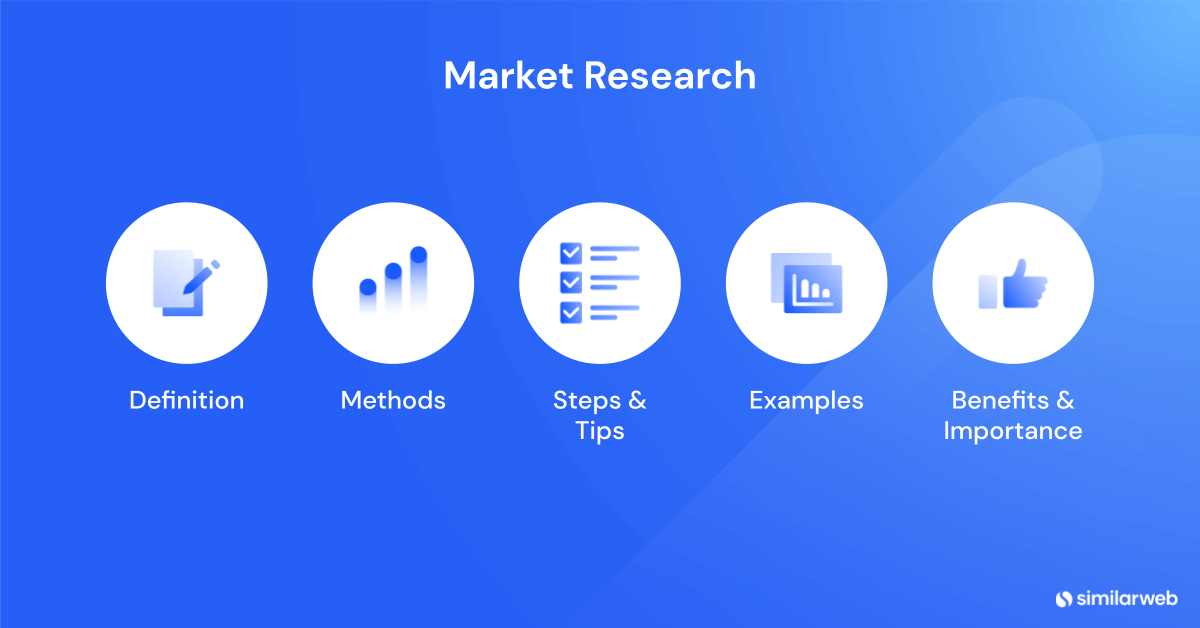
Do you want to gain a foothold in the market? Get to grips with the competition? Start thinking like your target audience? Introduce a new product or mobile app?
Whatever your goal, market research will help you understand all aspects of your industry, brand, potential customers, and rivals – good market questions can make a world of difference.
Below, we’ll walk you through 99 questions to ask for market research to succeed in the digital world. We started out as a research intelligence tool , so we know our stuff when it comes to defining a market, mapping key players, marketing strategies , and understanding trends , and target audiences.
So read on for all the questions your market research strategy needs – and how Similarweb can help you answer them.
How to choose market research questions
The market research questions you pick will depend on where your business is in its lifecycle. As we’ll get to in a moment, there are a lot of market research questions – so how exactly do you choose?
Pre-start-up – If you’ve not launched a business yet, and are just cultivating an idea – you’ll want to start with some formal market research first. Then, ask more general market research questions, and some targeted at start-ups. This will help you determine if there’s a financially viable market, whether it has blockbuster prospects, or is better off left in the cutting room.
Early start-up – If you’ve just started out, you’ll want to reach out to your target market with survey questions to help you tailor your products and services to them.
Established – If you’ve been around a little longer – and already have a few current customers – you’ll want to learn more about how you can keep improving your customer experience.
Finally, you can look at questions to ask for market research that focus on competitor analysis. These aren’t limited to any particular stage of your business’s journey. After all, getting clued up on the competitive landscape is always handy – whether you’ve just entered the market or are one of its most established players.

99 market research questions: discover, define, drill down
There’s no need to limit yourself! The best types of market research should – and do – include general questions and those addressing both existing and prospective customers. Indeed, an intelligent approach to market research should cover demographic questions all the way to those that’ll help you plan a product launch , drill down into your target market , and get the jump on your competitors.
Read on to see the best examples of market research questions in action!
Generic market research questions
These questions are most useful at the planning stage. They can apply to all businesses at any stage because markets shift, along with consumer behaviors, needs, and demands.
General market research is the process of figuring out how rich the soil is and whether the conditions are optimal to allow your business’s roots to take hold.
Some general market research questions you should be asking include:
1. How large is my product’s total addressable market (TAM)? 2. Will this market hold firm, or will it grow or decrease with time? 3. Are there already similar products or services out there? 4. If so, who’s offering them? (see the competitor analysis questions below for more) 5. Who are my buyer personas ? 6. What pain points does my product address? 7. How much market share is available for my business to take? 8. What external factors might affect the health and viability of my chosen market? 9. Which website demographics will I target? 10. Will I market my product internationally or target a specific geographical location or a single location (if so, why?) 11. Do I need to consider a website alone, or should I invest in a mobile app? (use mobile app intelligence to help to figure this one out) 12. Which suppliers or manufacturers operate in the space, and are they reputable? 13. Which marketing channels will I prioritize, and which affiliates or advertisers could I look to in order to expand my reach?
Market research questions for start-ups
Regardless of your sector, there are key things you need to establish before setting up a business. Read on to discover the fifteen market research questions all start-ups need to ask.
14. What is the total addressable market (tam), serviceable available market (sam), and share of market (som)? 15. What are the latest (and predicted) trends impacting your market? 16. Do you know who your direct and indirect competitors are?
Read through questions 71-99 for examples of market research questions to help you with this.
17. What’s your USP in the market? What’s the value-add that’ll make you stand out? 18. What do your competitors charge, and will you charge the same, more, or less?
You’ll also need to consider pricing models. For instance, pay-monthly, annual subscription, or other?
19. Do you know how much people are willing to pay for a product/service like yours? 20. Can you trial your product or service with a beta group before launch to get feedback and/or testimonials? 21. What are the most effective marketing channels for businesses like yours? 22. How active are your customers and competitors on social media? 23. How will you onboard/welcome new customers? 24. Do rivals offer new customer or loyalty discounts? 25. What kind of customer support will you offer? Look at your rival’s offerings and decide whether you want to stick with the same or do better. 26. Are potential customers driven by price, product, or service? 27. Are your competitors or market impacted by seasonal trends ? 28. What opening hours and service level agreements (SLAs) will you advertise on your site?
Market research questions for a new product
Whether established, pre-launch or newly set up, you may need to ask specific market research questions for a new product launch. Whether you simply want to test the water with an idea or concept or go a little deeper to get clearer insights, these questions will help.
29. Is there a specific pain point your product will address? (if you have already identified an ideal customer, what kinds of things do they struggle with?) 30. Is there a demand for your product in the market? 31. Are there any opportunities to partner with other companies to get referrals for your product? 32. How do you plan to market and launch your product? 33. Will you release a minimum viable product (MVP) to market first?
If you release an MVP or offer a free trial to a select group of people, you’ll need to follow this up with a survey or specific questions to get feedback around usage, benefits, and improvements. A few examples of market research questions like these could include:
34. Which feature of the product did you use the most? 35. What improvements would you like to see? 36. How much would you be willing to pay for this product? 37. Was the product easy to use? 38. Was there anything you experienced during the trial that may deter you from using our product in the future? 39. How often did you use the product? 40. Would you recommend this product to someone else? If yes, why? If no, why?
Market research questions for your target audience
Once you’re sure there’s a viable market for your business, it’s time to drill down into that market – your audience and website demographics .
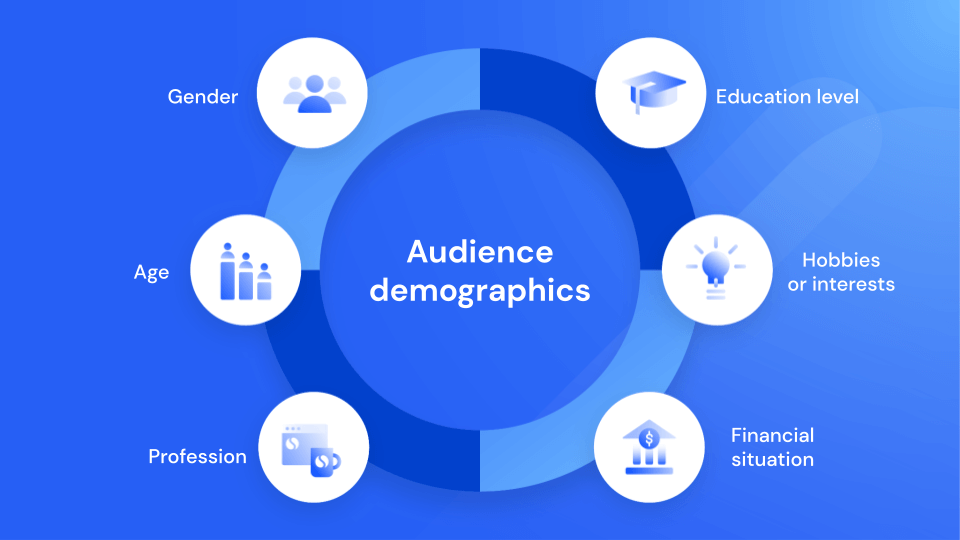
To begin, you’ll want to ask your respondents a few demographic questions to understand the basics. These might include:
41. How old are you? 42. Which gender do you identify as (if any)? 43. What’s your level of education? 44. What’s your profession? 45. What’s your household size? 46. What is your household income? 47. Which ethnic/cultural group do you identify with? 48. Where do you live? 49. Do you have any dependents? 50. What are your hobbies?
These questions provide a top-level understanding of your target audience . So, you can then utilize psychographic segmentation to dig a little deeper. These inquiries are designed to draw out your customers’ attitudes, lifestyles, likes, dislikes, motivations, and beliefs – particularly if they relate to your product or service.
The goal? To match your business with its ideal customer . Examples of these types of market research questions include:
51. Do you actively seek out new experiences or prefer to stick with what you know? 52. What do you most enjoy doing in your free time? 53. What was the last big-ticket item you purchased? 54. Have you ever boycotted a brand? If so, which brand – and why? 55. Which matters more when you make a purchase – price or quality? 56. Would you rather have more time or money? 57. How do you like to make purchases – do you prefer apps or web-based services? 58. How do you prefer to seek customer support? 59. What’s your main source of information?
For a more detailed deep dive into the above, see our guide on the what and why of market segmentation – and how to become a pro at it!
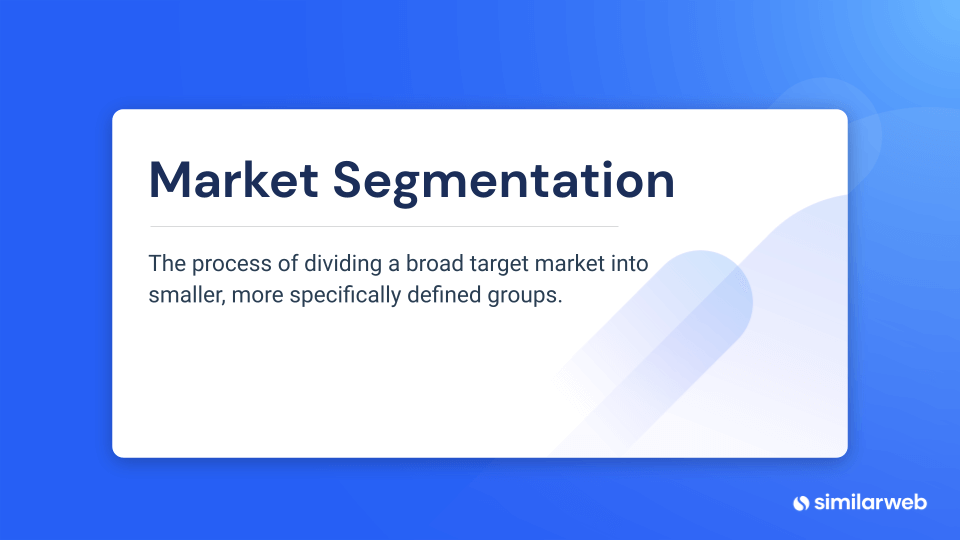
Market research questions for your customers
So, you’ve established the market for your product, nailed your target audience, and now… you’ve got customers! Congrats – that’s a surefire sign that you’re on the right track.
But simply having new customers isn’t enough. To be truly successful, you’ll need to maintain engagement , foster loyalty to your product, and keep your customers coming back for more – in other words, build your brand.
Fortunately, this is where market research can help. By asking your existing customers a few questions, you can find out what you’re doing well, what you could be doing better, and – crucially – what your brand means to them. With this knowledge, you can do more of what your customers love, and identify key areas for improvement.
Here are some of the market research questions you can ask your customers to get useful feedback:
60. How did you first hear about our brand? 61. What made you choose us? 62. How long have you been a customer? 63. How would you rate your most recent experience with us? 64. Did we answer all your questions and requests for support? 65. Would you use us again? 66. How likely are you to recommend us to a friend? 67. What do you wish our product could do? 68. Do you believe our product is priced fairly? 69. What’s the maximum you’d pay for this kind of product? 70. What do you like most about our product?
Explore our complete guide to audience development for more tips, tricks, and strategies around this type of customer analysis.
Market research questions for competitor analysis
Death, taxes, and… competition .
Yep – no matter how original or innovative your idea is, pretty soon, there’ll be hordes of wannabes targeting the same space with similar products, and guess who they’ll be targetting? Your customers.
So how do you keep your friends close and your competition even closer?
Well, a SWOT analysis is a good place to start. It involves swotting up on your business’s strengths, weaknesses, opportunities, and threats. It’s a heady mix of evaluating your business and the external factors that could affect it. So it’s naturally a great place to get your competitor analysis and benchmarking off the mark.
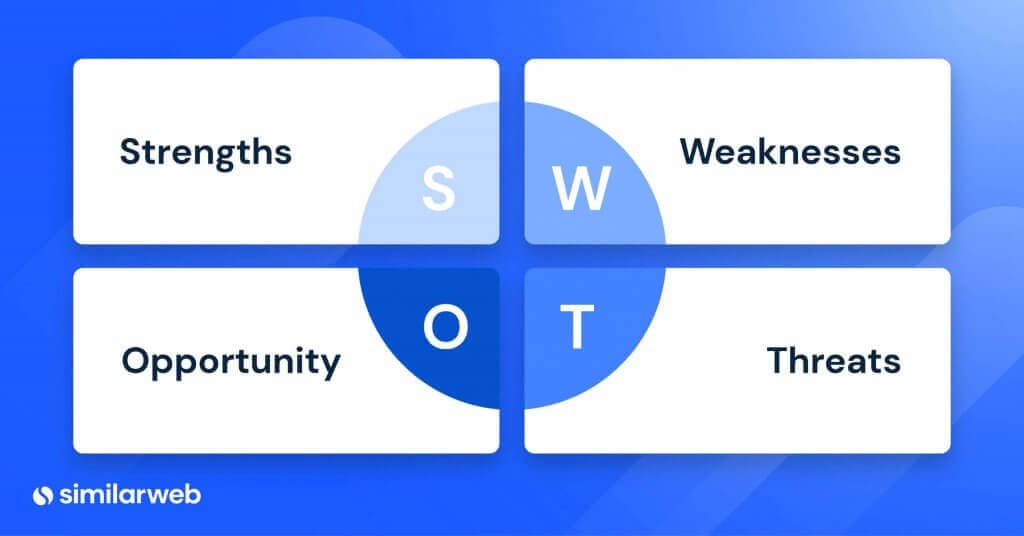
You could also begin by asking yourself the following market research questions:
71. Who are our main competitors? 72. What are they doing that we’re not? 73. What’s our unique value proposition? 74. How much web traffic do our competitors receive? 75. Do they have a mobile app? If so, is it on iOS or android? How many monthly or daily active users do they have? 76. What’s their bounce rate ? 77. Which keywords and search terms do they target? 78. Which marketing channels do they prioritize, and how frequently do they advertise? 79. How do the backlink profiles of our competitors compare to our own? 80. Are our competitors seen as more authoritative in the space? 81. What kind of content do our competitors produce? 82. How do our competitors attract customers? 83. What are the unique selling points of our competitors? 84. What do our competitors charge? 85. What social media channels do our competitors use? 86. What kind of discounts and promotions do our competitors run? 87. Which sources and affiliates drive traffic to our competitors’ sites? 88. How does our business model compare to those of our rivals?
Remember, your customers are a potential goldmine of information about your competitors . Reach out to your client base with the following market research questions:
89. Who do you seek advice from when shopping for this kind of product? 90. Are you loyal to a particular brand in the space? 91. If so, what do you love most about this brand? 92. Is there anything that this brand could do better? 93. How did you find the last product you bought in the industry? 94. Is there anything you see our competitors doing that you’d like us to do? 95. What’s most likely to make you buy a product from another brand? 98. Can you tell us the top three things that made you choose us over a competitor? 99. What one thing matters most to you when deciding between brands that offer the same product?
You may also consider including some open-ended questions so you can hear from your loyal customers in their own words. Market research surveys are a great way to uncover and collect this type of data.
If you’re unsure where to start, learn about the seven types of competitor analysis frameworks – and how to use them to get your strategy off the ground.
Similarweb Competitor Analysis Frameworks
Whether you're B2B or B2C, get started with our free and easy to use template
How to answer these questions with Similarweb
Now that you’re armed with the 99 research questions you need to succeed in your market research endeavors, how do you answer them?
Similarweb Digital Research Intelligence is a great place to start. With these tools (which you can try for free) you can effortlessly do market sizing, gauge your audience’s loyalty and engagement rate , uncover mobile app intelligence for your market, improve your site’s retention rates, and more.
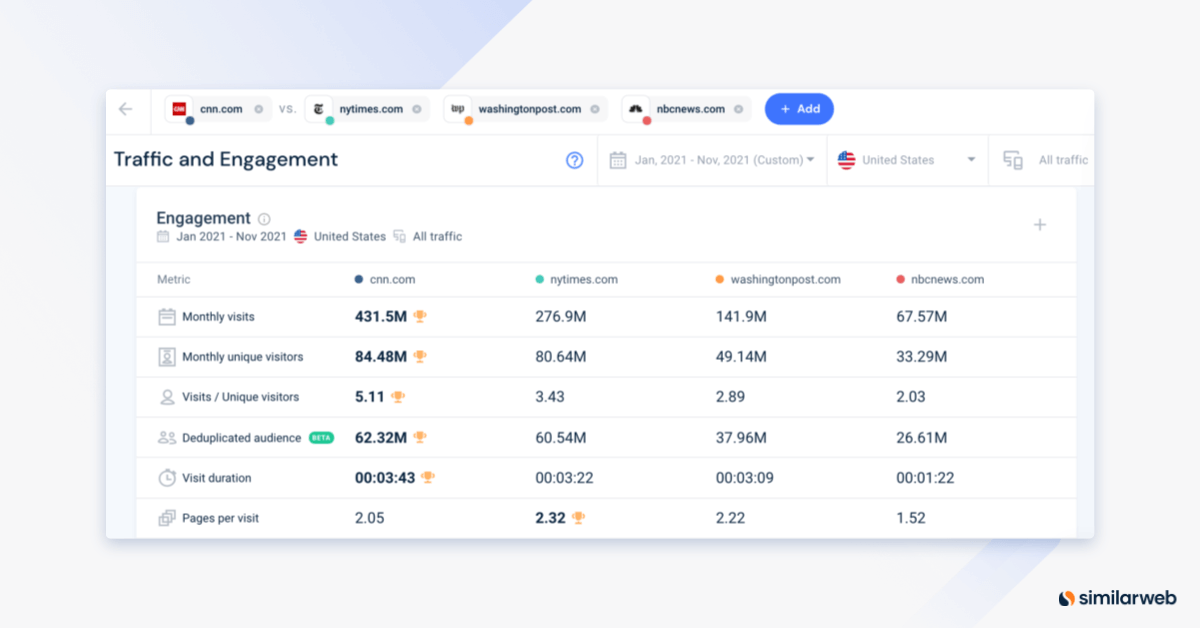
In the same vein, Similarweb can also help you conduct that all-important competitor analysis . You can build a picture of which rival sites your customers frequent and form a data-driven understanding of why.
With Similarweb Digital Research Intelligence, you get an entire suite of market research and analysis tools at your fingertips. You can monitor your industry in real time via a personalized dashboard with on-demand access to industry, company, and consumer trends. With a broad view across web and mobile app intelligence, you can clearly understand the digital landscape that matters to you ( and your customers ) most.
Don’t just take our word for it, though. Check out what Similarweb can do for you today, and start tackling those big questions now!
Level up your market research
Get the data you need to adapt to market changes and industry trends.
What is market research?
Market research assesses the viability of a product or service by reaching out to its target market. It can include primary research – such as interviews, focus groups, and questionnaires – and secondary research , like articles and white papers.
What is the best way to ask market research questions to customers?
Because they’re quick to set up, relatively low-cost, and easy to use, market research surveys are a great tool to use if you want to ask a group of people market research questions.
What’s the difference between qualitative and quantitative market research?
While qualitative data is typically mined through close observation with participants – such as in focus groups or face-to-face interviews – quantitative processes tend to involve larger-scale data grabbing. This could use forms, surveys, polls, or questionnaires to collect opinions en masse, often via emails or social media.
Qualitative data captures people’s thoughts and feelings – the prevailing sentiment around a product or service. Its quantitative counterpart, however, is more concerned with the cold, hard facts. That could be traffic metrics, engagement levels, bounce rates: anything that paints a data-driven picture!

by Liz March
Digital Research Specialist
Liz March has 15 years of experience in content creation. She enjoys the outdoors, F1, and reading, and is pursuing a BSc in Environmental Science.
Related Posts

How to Conduct a Social Media Competitor Analysis: 5 Quick Steps

Most Popular Messaging Apps Worldwide 2023

Market Sizing: Measuring Your TAM, SAM, and SOM

How to Research a Company: The Ultimate Guide

How To Create Better Competitive Analysis Reports
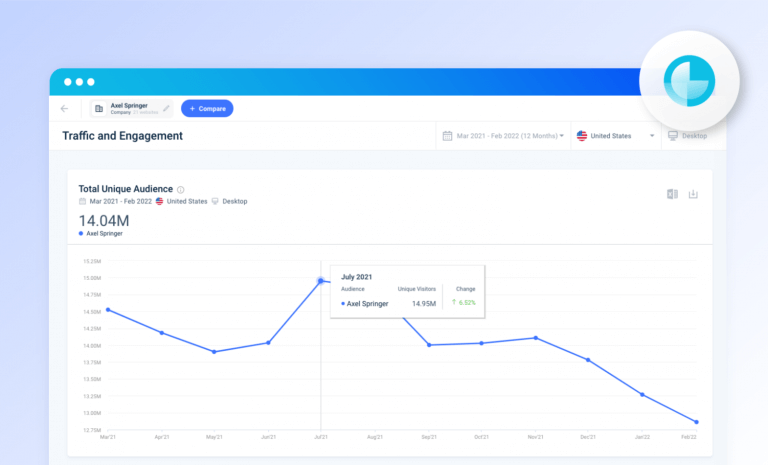
Fresh Updates: Analyze Entire Companies With Company Analysis
Wondering what similarweb can do for your business.
Give it a try or talk to our insights team — don’t worry, it’s free!
2021 Global Insights Report
In the games industry, innovating with the latest insights is critical for finding success around the globe. at google, we believe world-class games should be powered by world-class insights..
What is Google for Games?
We offer solutions throughout the lifecycle of your gaming business.
With a collection of great tools that help you across the entire lifecycle and access to billions of users each day, google is your partner in taking your game to the next level..
Search trends
- They searched for hardware and accessories
- They sought competitive communities
- They escaped into immersive genres
- They used gaming to learn new things
As more people stayed at home earlier in the year, gaming has become a growing way to socialize for existing and new gamers alike. This shift can be seen in an increase of downloads from January to June. 3
In the gaming world, success is often defined in billions of dollars of revenue or tens of millions of downloads. The reality is that most games on the market never come close to that level. They’re not Call of Duty or Candy Crush. Yet, even the smallest studios can enjoy long-term success if they take the right approach to scaling their business...
In the gaming world, success is often defined in billions of dollars of revenue or tens of millions of downloads. The reality is that most games on the market never come close to that level. They’re not Call of Duty or Candy Crush. Yet, even the smallest studios can enjoy long-term success if they take the right approach to scaling their business. Of course, on the whole, game developers are pioneering some of the most innovative strategies and technology we’ve seen in years, and they’re at the forefront of one of the fastest-growing industries. But if your idea of success is just being popular in a large gaming market, you’re not considering the full nuanced picture.
My team and I spend a lot of time thinking about how every game developer — whether they have 50,000 downloads or 50,000,000 — can find ways to succeed in this highly competitive market. When I talk to different companies, the question I get asked most is, “How do we compare to other game developers? Are we doing well?”
Here’s the thing: Long term success is about understanding where you are right now, and taking measured steps to build on that. While it’s of course important to pay attention to what your competitors are doing, sometimes growing game developers can get so caught up in beating their rivals that they leave things on the table that could help them build a more sustainable business. In other words, don’t let your competitive spirit get in the way of your own best interests. Sure, I understand the impulse to shoot for the stars and imagine success as releasing a AAA title or being a top-grossing app in the Google Play store. But that’s over-simplifying it. What will make you successful in your own arena depends on how you pair your titles with market demand, and the way you assemble and operate your company.
The road to measured growth starts with asking the right questions, even if getting to the answers is hard. Here are a few to consider:
“How are your games resonating with your audience?”
Are you seeing good engagement within the first few minutes of game play? Is retention strong? These are all good signals as to whether you're gaining traction in the market. On the other hand, if you’re having trouble getting people to stay in the game, things will only get harder down the line. If you don’t have a solid base of players that represent a game’s value (for example, reaching the desired level of in-app purchases), and ideal playing frequency, then you shouldn't focus on growth until you find a better fit. Which is why it's completely counterproductive to believe that a successful game is simply some brilliant idea with off the charts retention. What you're looking for initially is not so much a great idea for a game, as a game that could move through growth phases, in the midst of all of this technology disruption.
“How expensive is the game to promote?”
Is your marketing spend justified by the conversion rates? Are people discovering your game in new or unexpected ways? You should be able to clearly and confidently say where you’re looking to invest more resources, and why it would help you grow. Develop an investment “thesis” that you stick with. Conventional thinking, says product makes the game, marketing, markets it. The best gaming companies work tirelessly to integrate the two.
“Is your business model realistic?”
Are you sufficiently staffed to scale as your market grows? A five-person studio that publishes a game every two years may not be learning fast enough to build a sustainable business.
“Is your target market too small?”
Many developers don't think they can afford to expand beyond their local market. Or they believe success means getting big in the US or China, when they could drive substantial revenue by focusing on expanding to a wider variety of smaller countries.
Growing developers who don’t closely consider more focused questions like these risk attempting to scale when they might not be ready. As the leader of a gaming company, the more you think of your organization as a constantly evolving organism, the more you will test your products, the effectiveness of your marketing, and the value of your design — and the more you test (and fail), the more you learn. Remember: When you’re scaling your company in one growth phase and anticipate the next, the healthiest mindset is “what got you here won’t get you there.”
Eventually, every game hits the limit of the markets and players it was designed for. Game studios will then have to decide whether they want to grow by launching new titles. The ability to create another game whose growth line ascends as the other game descends is the dynamic of all successful, transcending gaming companies that truly scale. It’s important to keep in mind that not all gaming companies aspire to do this, and that doesn’t mean that they’re not successful. You have to decide what’s best in your specific case, based on the games that you offer. It’s about finding the right balance for you — deciding how many growth curves you want to balance, and accepting the trade-offs.
One of the great things about the games industry is that there are relatively low barriers to entry, especially for mobile games, and opportunities for winners in all kinds of markets and genres. You can go from zero to 100 at the intersection of market and genre. And the industry continues to expand. There are more gamers than there were a year ago, and revenue is growing at nearly 10 percent per year 1 . That trend shows no sign of slowing. There's great talent and great opportunity for smaller developers, and more than enough room for many to thrive. But it starts with understanding what success means to you — not the market at large — and thinking even more deeply about how your own team, culture, and product play a part in it.
1 https://www.reuters.com/article/esports-business-gaming-revenues/report-gaming-revenue-to-top-159b-in-2020-idUSFLM8jkJMl/
Female gamers
For instance, the gaming market in China continues to expand, and female gamers are stepping up . As of 2019, China is home to one of the highest populations of female gamers in the world, making up 45% of total Chinese gamers. 4
China has long been a powerful player in the global gaming ecosystem. While Chinese consumers have traditionally been receptive to games from the United States, South Korea, and other overseas markets, Chinese publishers have been surging ahead of their international competition in recent years across a wide variety of genres...
China has long been a powerful player in the global gaming ecosystem. Today, the country easily falls within the top 3 countries in the world with the highest gaming revenue. 1 While Chinese consumers have traditionally been receptive to games from the United States, South Korea, and other overseas markets, Chinese publishers have been surging ahead of their international competition in recent years across a wide variety of genres.
In fact, some of the world’s most innovative games are now coming out of China. While titles like Tencent’s PUBG Mobile and NetEase’s Knives Out are delivering cutting-edge gaming experiences in the battle royale category, Mihoyo’s Genshin Impact has been lauded for its revolutionary approach to AAA game development. If you’re an overseas publisher trying to crack the Chinese market, you need to be aware of what it takes to succeed over there. Here are five strategies to consider when entering and succeeding in China:
Continually innovate and improve
Over the years, Chinese developers have excelled at creating high-quality mobile games, like Honor of Kings . At the same time, they haven’t slept on their laurels. To illustrate, Chinese developers have been working on improving mobile gameplay quality to the point that it matches PC and console experiences. The takeaway? It’s not enough to create a high-quality game. You also need to commit to continually improving it and adding new content. You can do that by prioritizing continuous iterations to improve fundamental gameplay and collaborating with IP owners and brands to add engaging content and real-time support capabilities to your titles.
Capitalize quickly on popular trends
Chinese companies move rapidly to identify trends within the gaming community and incorporate them into their newest titles. For years, multiplayer online battle arena (MOBA) games didn’t exist on mobile. In large part, that was because traditional developers didn’t believe the genre would work on smartphones. Tencent believed otherwise, and proved the concept with titles like Honor of Kings — thereby making the seemingly impossible possible. In gaming, time to market is crucial. If a project is delayed by months or even weeks, competitors can get substitute options out faster, quickly pulling ahead.
Chinese publishers understand this notion perfectly, which is why top publishers employ teams of developers around the clock to get titles into app stores as quickly as possible. Beyond that, many even have implemented an internal competition mechanism that rewards the fastest teams with the best-performing titles. To keep pace in China, overseas publishers need to operate with speed and agility, and be able to quickly capitalize on current popular trends.
Plan your marketing budget for the long term
While U.S. and Japanese game publishers invest more heavily in design and development, Chinese publishers are more focused on marketing and user acquisition. To this end, they rely on data-driven business models that calculate the time needed to see a return on their investments — and then use those calculations to determine the marketing budgets for future releases. Overseas publishers that wish to compete in China need to plan their marketing budgets for the long term and make a conscious effort to continuously engage users and add more value.
Integrate social networking and influencers
Embedding social elements into games helps increase player engagement and improve long-term retention statistics. When players see people they know promoting the games they love, they’re more likely to continue playing. If you’re trying to enter the Chinese market, take advantage of short-form apps and live streaming platforms like Douyin (China’s version of TikTok) to promote your games. Whenever possible, partner with key opinion leaders to help create momentum ahead of a launch.
Find a local partner
Since there isn’t a Google Play store in China, developers must work directly with a number of OEMs, many of which have their own app stores. If you’re coming into the market from the outside, this can be a difficult situation to navigate. The easiest way to do it successfully is by finding a knowledgeable partner that has relationships with the OEMs you’re looking to work with and can negotiate agreements with each of them. As an added bonus, the right partners may also be able to help studios navigate the challenging licensing process required to publish games in China.
Ten years ago, nobody would have predicted that mobile gaming would be as popular and exciting as it is today. Looking into the future, I predict cloud gaming will be the same way in 10 years: the era of downloading games will be over. Gamers will just click to play with their friends, and the accessibility of gaming and excitement of gameplay will be greater than ever before. More importantly, I believe that as the nature of technology and entertainment continues to evolve, China will remain a bustling hub of gaming innovation in the future as it has been in years’ past — a source of opportunity that continues to open doors for game developers and gamers around the world.
1 https://newzoo.com/insights/rankings/top-10-countries-by-game-revenues/
Global watch time hours of gaming content in 2020
Communities have become more interconnected with each other outside the games themselves by creating and consuming related content. On YouTube, gaming content continues to grow year over year. Globally, there were over 100 billion watch time hours of gaming content and 40 million active gaming channels on YouTube between October 2019 and September 2020. 5
From events that pivoted to digital to live streams to an ever-growing library of VOD content, YouTube Gaming was home to all forms of video game content. 6 Here are some of the global top videos from 2020:
As a kid, the last thing I wanted to do was watch someone else play a game. I wanted to be in the action myself, so the idea of watching content about something I could engage with myself seemed backwards. And yet, when I became a commentator at Major League Gaming in 2008, something clicked for me: I quickly realized that esports and livestreaming was not only gaining momentum, but would take the games industry by storm...
As a kid, the last thing I wanted to do was be a spectator, watching someone else play a game. I wanted to be in the action myself, so the idea of watching content about something I could do myself seemed backwards. As I got older, my interest in sports pushed me to be incredibly competitive off the field as well, as I discovered the world of video games. I found myself falling in love with esports in 2002 when I played Counter-Strike matches competitively in a league, which then led to becoming a content creator myself -- streaming on Justin.TV and posting my gaming videos on YouTube. What I quickly learned was that I wasn’t alone, and other people shared this same passion. It truly clicked for me when I became an esports commentator at Major League Gaming in 2008: I realized that watching people play video games was not only gaining momentum, but would take the games industry by storm. It wasn’t a matter of if; it was just a matter of how soon.
When I joined YouTube as the Global Head of Gaming more than six years ago, the business of gaming videos was still in its infancy. Back then, we didn't even have a dedicated games destination on the home page — it was still a subcategory under Media and Entertainment. Today, YouTube is the best place for watching and creating gaming content. We have pages upon pages devoted to the most popular video games, brimming with content from our gaming creators, making gaming one of YouTube's most popular categories. We’re seeing people from all around the world come to YouTube to connect more deeply with gaming creators, watch live video game content, learn how to play new games, or simply master the ones they already love. In fact, more than 200 million people come to YouTube every single day to watch video games content, making it one of the largest gaming video platforms in the world.
“Watching people play video games was not only gaining momentum, but would take the games industry by storm. It wasn’t a matter of if; it was just a matter of how soon.”
In 2020 alone, people around the globe watched over 100 billion hours of gaming content on YouTube, and we had over 40 million active gaming channels. Live streaming on YouTube had an incredible year: We saw watch time from gaming live streams grow to over 10 billion hours. Creators like LazarBeam , Lyna , MortaL , CouRage , TheDonato , Felipe Neto and Typical Gamer are streaming exclusively on YouTube, and we’ve seen Valkyrae become one of the biggest female live streamers across all platforms since she started streaming exclusively on YouTube.
Live-stream content will always be an important piece of the pie, but in today’s reality, live watchtime is still only a small piece of the total pie when looking at gaming video consumption across all platforms. Directionally, I believe gaming is going to be multi-dimensional across not only games and platforms, but content forms too. Whereas VOD content allows edited videos to flourish and Live is great for telling stories in real time, we’re also focused on original short form content via Shorts and Clips, which directs viewers to an exciting or important moment in time. Mobile gaming is also on the rise as more people play mobile games and use their mobile devices to watch content on YouTube. All of this together makes YouTube Gaming a dynamic ecosystem that engages more than 200 million people around the world. But keeping fans coming back for more requires a huge volume of content.
“In today’s reality, live watchtime is still only a small piece of the total pie when looking at gaming video consumption across all platforms.”
One way developers and publishers are approaching this is by offering sandbox environments that turn players into creators, which extends the shelf life of their games and creates new revenue streams. A classic example is Minecraft: its sandbox offers infinite opportunities for creativity and is one reason why it’s been the biggest game on YouTube since its debut. By layering new, original content atop older games, top creators like Dream have found ways to capture and engage global audiences a decade after the game’s initial release.
Here’s what I know for sure: The games that have found long term success and a loyal fan base on YouTube are the ones that allow players to create their own narratives. These days, games are no longer pieces of content on their own. They have become jumping points for an ever-growing library of user-generated content – whether it's updated characters, maps, modes, or other digital extensions. Where there’s fresh content for games, you can be sure there will be more content about it. It's a virtuous circle that's growing at an exponential rate.
There’s a wonderful symbiotic relationship between making games, hardware for games, watching people play video games, and the content creator themselves. People watching other people play video games has inspired more people to play games and, in turn, spend more money on gaming. The relationships between these different groups of individuals continues to be complementary to each other, which I believe has been the catalyst for the remarkable growth that the industry continues to see.
“The games that have found long term success and a loyal fan base on YouTube are the ones that allow players to create their own narratives.”
This will only continue to get bigger as more people are choosing to play and watch video games. As mobile gaming continues in popularity, we see in parallel that of the top games watched on YT in 2020, four were games available on mobile devices 1 . Over the next five years, the lines between playing and watching will continue to blur through partnerships with games and an expansion of platforms. You could be watching a live stream on YouTube, click a button and jump right into the action yourself, or receive a digital item to use next time you jump into the game after watching. The ability for viewers, creators, and players to influence one another will open the door to types of gaming we haven't even imagined yet. And as mobile devices and infrastructure continue to improve, players around the globe who don't have access to PCs, consoles, or cloud platforms will be right in there with them. These trends show no signs of slowing down, setting mobile up for continued massive growth.
I firmly believe gaming videos will continue to engage both spectators and players in the same way the world of sports has captured audiences: with both athletes and fans actively participating. But what will set Gaming apart is that publishers, creators, and viewers will influence each other in ways traditional sports never could. There’s no doubt the gaming ecosystem has evolved since my days at Major League Gaming. Back then, the stereotype of gamers was some dude playing video games alone in a basement.. That cliche has proven to be misguided as billions across the world are not just playing, but choosing gaming video as their primary category of content to consume. Today, we see larger, more diverse audiences connecting and actively exploring rich, high-gloss alternative realities. And they’re looking for a different kind of experience — one that’s customizable and ignites curiosity, and at YouTube we will always ensure that we are the home for Gamers to do just that.
1 https://blog.youtube/news-and-events/youtube-gaming-2020/
Global insights
What should game developers make of ever-shifting preferences in both games and gaming content? When ideating, keep high-growth genres in mind to inspire your next creation. Here are genres gamers around the world are paying attention to as they search for their next experience: 7
Partner perspective
A considered, focused and responsible strategy: That’s the key to launching a game globally. Ethan Wang, Vice President of NetEase uncovers the process behind a global launch, using real-life case studies to do the talking. From product development to market segmentation, discover what goes into developing an internationally recognised game with Navigating Global Launches.
Player behavior
What's keeping gamers engaged?
Retention is a matter of keeping them engaged and delighted. Top games have a 45% higher day 7 retention rate than industry average, meaning they retain their community by understanding their differing preferences. Here are some key shifts in game engagement globally: 1,2
Over the last decade, APAC has become a gaming powerhouse, influencing developers in every other major market. Thanks to the widespread adoption of low-cost smartphones and affordable broadband, as well as a booming population, the audience and developer community for connected games in the region is surging...
Over the last decade, APAC has become a gaming powerhouse, influencing developers in every other major market. Thanks to the widespread adoption of low-cost smartphones and affordable broadband, as well as a booming population, the audience and developer community for connected games in the region is surging. Strong GDP growth also means people have more leisure time and more disposable income to spend on entertainment. As a result, the audience in Asia is rapidly shifting toward higher-quality gaming experiences, spurring continued innovation.
So, what do these converging trends mean? I’m often asked how game developers can stay ahead of the curve by finding success in the APAC market. To them, I say: the ever-evolving environment means ‘cracking the code' to success in APAC can be achieved in more avenues than ever before. While there is no one-size-fits-all approach, here are key insights to keep top of mind:
APAC is not a monolithic market and should be explored in detail
APAC is the biggest gaming market at a global level, and its sophisticated gamers and game ecosystem continue to raise the bar for continued innovation and product quality. However, it’s important to keep in mind that although the market is often spoken about as a region, audiences vary widely from one country to the next.
In mature markets like Japan and Korea, for example, players tend to prefer hard core genres like roleplaying or simulation due to their long PC/console history. They have more money to spend, and their expectations for game play and new features are high. Emerging gaming markets like Southeast Asia and India continue to experience high growth as a larger number of consumers go online via smartphones while Australia and New Zealand are also seeing increased growth as game studios and user acquisition knowledge continue to mature. In those markets, key played genres tend to be casual and hyper casual games. Players are not willing to spend as much money as in mature markets, therefore studios tend to be making money through alternatives to in-app purchases (IAP) like in-app advertising. In China, we see a mix of both: higher paying hard-core gaming fans in the largest cities, more casual and price-sensitive players in suburban areas.
Developers must put in the effort to understand their target audiences and what they're looking for. In order to succeed, studios must deeply understand the audience they’re targeting before trying to win it over and be innovative in capturing their attention. They must master localization, game design and mechanics, preferred transaction methods and revenue models for each audience if they wish to be successful. A recent trend I’ve noticed that is an excellent example of innovating for a new audience is the rise in genre-mixing: when a game mixes new gameplay with traditional methods to improve retention and attract new players (i.e. combining a puzzle game with an anime art style).
Monetization strategies should evolve not just per region, but per country
Ten years ago games were sold almost exclusively as if they were physical goods; today this accounts for perhaps 5% of total revenue. Developers need to combine multiple ways of making money, whether via a diverse games portfolio with different revenue models for each, or by mixing up different streams in a single game based on player behavior.
Game developers should combine as many revenue streams as possible, and to keep doing so as long as it remains effective — whether it’s a varied portfolio of games with different monetization streams in every game, or different streams in a single game, the more diversified a developer is, the higher its likelihood to be successful in maximizing the lifetime value (LTV) of its users. For example, if I am the CEO of a Japanese studio launching an IAP-only game in India or Vietnam, I may be leaving money on the table given the payer percentage is very low in emerging markets vs mature ones. I should know my markets and users, and adopt a hybrid monetization approach that combines both in-app advertising and IAP. This way, I will be capturing the most value from non-payers (in Vietnam and India, a larger proportion than in Japan or Korea), and from potential purchasers (via IAP).
Remember: revenue may be king, but engagement is the kingdom. As players become more engaged (emotionally and socially) with a title, they are naturally more willing to spend (or engage with brand activations) further down the line. Experimenting with how your content can bring your community joy is key to sustainable success.
Growth in female gamers continue to outpace that of male gamers
As of 2019, China is home to one of the highest populations of female gamers in the world: 45% of Chinese gamers are women and this segment continues growing at a rate of nearly 14.8% per year — nearly double the male growth rate at 7.8%. When considering this insight, it’s also important to call out that this growth isn’t limited to age range, either. In fact, a particular segment I find fascinating is the rise of the female/senior player in China (银发族).
Korea, Japan and Southeast Asia have also high female player populations, with 40% share of audience 1 . This growth is also accounted for from a revenue standpoint. In 2019, female players accounted for 35% of the mobile games revenue, and in 2020 we’re expecting that number to increase up to 39% 2 . The pandemic was one factor that accelerated this growth, and we expect to continue seeing strong growth among women gamers.
Collaborate with local members of the gaming community
One of the most amazing things about the gaming ecosystem in Asia is the evolving sense of community and the role communities play. At the start of our industry, developers were working independent of each other. Now developers would go out of their way to help each other, even when they compete in some areas. The drive to stay competitive is seen as a communal challenge and is at the core of the region’s innovation over the last decade.
With so many opportunities continuing to unveil themselves every year, we've been urging developers to expand their horizons. If you make casual games, consider making hard core titles or creating hybrids that combine genres to appeal to different types of players. If you rely mostly on ad revenue, consider introducing IAPs. Not every industry embraces community the way game developers do — turn towards it and let inspiration, experimentation, and collaboration guide your next big hit. At Google APAC, our mission is to support our developers throughout their lifecycle — whether you are an independent game developer, or part of a big game studio. I look forward to continuing our commitment to maintain and grow a healthy gaming ecosystem and content creators.
1 https://services.google.com/fh/files/misc/levelup_asiagamingindustryreport_2020.pdf
2 https://services.google.com/fh/files/misc/levelup_asiagamingindustryreport_2020.pdf
They’re problem solvers. Forward-thinkers. People-focused. Niantic is evolving the player experience for gamers across the globe. Vice-President of Games, Greg Borrud, taps into the creative process behind Niantic’s success to reveal the mechanics of building captivating, immersive and uniting worlds. Evolve the Player Experience answers the questions of tomorrow, today.
Watchtime hours of live gaming streams on YouTube in 2020
The global pandemic has had an enormous impact on the gaming industry, and games have had a huge impact on us. More than ever, gaming has become a source of connection and community for people around the world while we sheltered in place...
The global pandemic has had an enormous impact on the gaming industry. More than ever, gaming has become a source of connection and community for people around the world while we shelter in place. Over the last year, we’ve seen how staying at home has meant the number of people playing games increased dramatically. The kinds of games people play changed significantly. Mobile game downloads increased 75% in between Q1’ ‘19 - Q1 ‘20, and gaming livestream watchtime increased 45%. According to GameAnalytics , playtime hit a peak of 90M+ hours in the last 10 days of March, a 62% increase compared to the first 10 days of January.
The nature of this “new normal” is one of an integrated experience. As there are new limitations to the number of in-person experiences, players’ relationship to gaming has transformed. People are engaging with games more often during the day, but for shorter periods of time. They’re playing games for different reasons — often just to stay connected with distant friends and family. New audiences for games that developers may have ignored or minimized in the past are now demanding to be embraced as gaming becomes a fundamental part of socially connected experiences.
Games are becoming more integrated into daily lives
With gaming becoming more embedded in our lives, more people are experiencing games in a non-linear fashion. This is especially true for people who’ve been asked to manage kids kept home from school while also trying to get a little work done. Instead of going on six-hour raids, they might play for six minutes during downtime at work or between meals. Cloud-based platforms like stadia enable this by allowing players to stop a game and pick where they left off, or to start a game on one device and continue on another.
As a result of these smaller time increments, people are engaging in different types of activities when they play. Instead of advancing a game's narrative, for example, they might spend that time customizing a character or connecting with a guild mate.
In order to accommodate these changing behaviors, game developers should explore building less rigidly defined experiences. For example, creating more short demos for people to sample, or brief loops they can quickly complete within a longer game. Developers should also consider ways to make it easier for players to hop in and out of the action, by designing their games with cloud gaming platforms in mind.
Games are how people create and maintain connections
As has become clear over the course of the pandemic, people are using games to connect with family and friends they can’t see in person. This ability to play together while physically apart will only become more important over time. Gaming platforms have enabled the ability to engage much larger groups at once, enabling new communities to form and new types of gameplay to evolve.
Because the audience is broader, and playtime is more distributed over the day, there is also increased competition for players' attention. Game studios are no longer just competing against other games. They're competing against everything else people are doing with their free time, like watching Netflix or going for a bike ride.
Developers need to focus on what motivates this new breed of gamers — why they're playing, and what they hope to get out of it. They need to reward players more frequently and in more personalized ways to keep them engaged, and invest more effort into fostering communities that grow over time.
Games must not leave behind inclusion when searching for new audiences
Gaming should be something everyone enjoys, yet there is an enormous audience of potential gamers that remains largely untapped, whether it’s seniors or lower income people who don’t have the means to spend $3000 on a gaming PC. For example, there are between 300 and 400 million people worldwide who suffer from one or more physical impairments — whether sight, hearing, motor or cognitive skills. Until recently, there hadn’t been a big emphasis on supporting disabled gamers by the gaming industry. Now, companies like Microsoft and Unreal have begun focusing on accessible experiences, such as text to speech. It’s critical that the industry address this market directly by building accessibility into the core game experience, creating an opportunity to make gaming truly inclusive for everyone.
Games are the center of democratizing joy
By bringing vibrant and diverse experiences to people through gaming, we can achieve what some of my colleagues at Google have called ‘the democratization of joy.’ Ultimately we’re aiming for a world where anyone can play virtually any game they want, on any device, for as long as they want. Connection, personalization, and accessibility will be keys to success in the digital gaming world going forward.
Monetization
What are gamers purchasing?
Player-first strategies
Top game developers see a much higher retention than industry average, suggesting they are building games people love to keep playing. The best monetization experiences for you and your users are when you’re able to offer them something of value in return that is aligned with their preferences. These preferences and behaviors have continued to evolve within the past year. 1
Number of casual gamers who spent more money on games during COVID-19
Gamers who have made in-game purchases
Gamers who have bought a new game
Paid content
- Purchasing currency for in-game transactions
- Buying a special bundle with useful in-game items
- Unlocking special / collectible / rare items for characters
- Customizing a character’s appearance 2
Can we balance play and profit? Rovio has run the numbers, and they’re proving it’s possible. Rovio CEO, Alexandre Pelletier-Normand explores how creative monetisation can enrich games. From the developers behind The Angry Birds, discover how this global organisation is evolving their operations to stay ahead of the curve with Connecting Play and Profit.
Developers of free-to-play games often struggle to find the best ways to monetize their titles. Should they rely on interstitial or banner ads? Offer in-game currency as a reward for viewing video ads? Aggressively promote in-app purchases? Develop a tiered subscription model? If you ask me, the answer to those questions is “yes.”...
Developers of free-to-play games often struggle to find the best ways to monetize their titles. Should they rely on interstitial or banner ads? Offer in-game currency as a reward for viewing video ads? Aggressively promote in-app purchases? Develop a tiered subscription model?
If you ask me, the answer to those questions is “yes.”
When you rely upon a single revenue stream, you’re almost always leaving money on the table. Armenia-based game development company Rockbite Games, for example, offers both in-app purchases and in-app ads. By providing two options to earn in-game currency, and by dynamically customizing their digital store through Firebase Remote Config , they were able to further increase their revenue.
Developers who want to maximize revenue and grow their studios need to employ a hybrid monetization strategy. But to avoid alienating their audience, they need to do it by adapting revenue models to each player's personal preferences — the same way they create dynamic content within a game. The key to this strategy is the intelligent application of analytics, which requires a few crucial steps.
Adopt a player-first strategy
Just as you use data to guide how game play unfolds, you should also use it to determine the monetization strategies that resonate the best with each player. Tools like Firebase and Google Analytics can offer rich insight into player behavior and help you predict which players will spend money inside the game and identify those who will not. By segmenting users, you can find opportunities to personalize each player's ad experience, optimizing your monetization strategy.
So the first step is to understand and segment all of your players. Which ones are high spenders? Who is unlikely to ever make an in-game purchase? Players who don’t want to spend money in-game may respond well to rewarded ads, while players who purchase items during game play may find such ads distracting.
The key is to match players with offers tailored to their preferences and behavior. PeopleFun, developer of popular casual games such as Wordscapes, wanted to introduce rewarded ads without cannibalizing revenue from in-app purchases. Using Firebase Predictions , PeopleFun was able to identify players who were less likely to make in-app purchases, and show rewarded ads only to them. The result: A significant boost in the lifetime value of all Wordscapes players.
Use data to drive your decisions
It's important to remember that just because a game is free-to-play doesn't mean the people who've downloaded it are averse to spending money. Similarly, if a type of ad format doesn't resonate with a user (or doesn't appeal to you, personally), it doesn't mean that it won't resonate with others. Assumptions, biases, or models that worked in someone else's game are not viable indicators of how your players will respond. When it comes down to it, successful monetization strategies are built on a foundation of experimentation.
Once you've segmented players based on their purchase behavior, intent, session duration, and other factors, you can test different variables to determine which types of offers work best for each segment. For example, Pomelo Games used Firebase Remote Config and A/B Testing inside its free-to-play game Once Upon a Tower to measure the effect of interstitial ads on revenue and retention. After two weeks of testing, Pomelo found that interstitials boosted ad and in-game revenue by 25% to 35%, with no discernible impact on retention.
Make monetization a core element
Hybrid monetization models maximize revenue without sacrificing the affordability that fans of free-to-play games love.
But monetization is not a feature that can be bolted on after a game is nearly completed. Some studios make the mistake of splitting production into two phases -- first designing gameplay, then focusing on driving revenue. This is a mistake. Your monetization strategy needs to be a core part of the development process, while remaining flexible enough to be optimized later based on testing.
While running experiments in a live game with actual players may seem scary, tools like Firebase and Google Analytics can allow you to easily create experiments and get insights from them without disrupting the player experience or requiring you to publish new versions of each game. In turn, you'll see a boost in earnings, and highly-engaged players enjoying an improved user experience.
Preferences
The method of consumption changes the experiences of gamers, and trends show the world is looking for more ways to experience the fun.
Gaming has changed tremendously since I first began designing games in 1999. The industry has gone from a niche hobby to a global juggernaut that's larger than music, movies, and books combined. And it shows no sign of slowing down. At the same time, game design has also evolved...
Gaming has changed tremendously since I first began designing games in 1999. The industry has gone from a niche hobby to a global juggernaut that's larger than music, movies, and books combined. And it shows no sign of slowing down. At the same time, game design has also evolved. The sheer number of designers has grown exponentially, and expanded into so many niches that there is rarely a single job title called 'game designer'. People who create free-to-play mobile games have little in common with developers working on AAA console or PC titles. And designers of those titles have become hyper-specialized by subgenre.
When the pandemic hit, the changes that were already underway went into overdrive. The need to shelter in place changed how and where game designers do their work. Downloads and cloud-based gaming surged. The types of games that were popular shifted almost overnight, as did players’ reasons for playing them.
Designers who want to succeed in the industry today need to be fluent in these macro trends. But some things that haven't changed: The need to tell a compelling story and to build a community around that storyline. If you can do those things consistently and well, you will thrive.
Innovation under pressure
Thanks to the pandemic, we have seen dramatic shifts in the industry over the past 12 months. But not all of the changes have been negative. It also drove huge innovation across the gaming space. For example, the need to work remotely led to a surge in distributed teams. Writers, artists, developers, and designers no longer have to be in the same place or even the same city to work on the same game. That’s especially true with cloud-based games, where people are already collaborating online.
When game development is more geographically distributed, the cost of producing a game decreases. People don’t have to live in expensive places like the Bay Area to be part of a team, so their overhead is lower. Studios can spend more money on design talent and support. And the people on those teams are likely to be from more diverse backgrounds, which almost invariably leads to greater creativity and innovation in game design.
The ability to work remotely and design games for cloud platforms like Stadia will ultimately allow smaller boutique studios to compete with the majors on a nearly equal basis. And that will benefit everyone.
A different kind of game
These days, the universe of gaming has expanded to include people who otherwise might never consider themselves ‘gamers.’ They may be older than your stereotypical gamer, or from different cultural backgrounds. And more of them are playing casual and mobile games than ever before.
They’re also playing games for different reasons. It’s less about competition and more about connection. In a time when people are still largely living apart, shared gaming experiences are helping to fulfill our need for community. Here, too, cloud-based games that can support larger numbers of players at once have an advantage.
We’ve also seen huge growth of nonviolent ‘feel good’ games that offer feelings of warmth and optimism. This concept of ‘hygge,’ a Danish word that translates roughly into ‘coziness or comfort,’ is a gaming trend we see growing stronger over time.
Story and community above all
Despite all the changes, a few constants remain. For example, two big influences on me as a young player and later as a designer were Sid Meier's Pirates and World of Warcraft . Both embodied universal truths that remain true today.
Pirates showcases how an intricate game still lives or dies on the strength of its storytelling. If I ever designed a game that weaves together mechanical systems with player-driven storytelling as elegantly as Pirates , I could die happy.
For its part, World of Warcraft demonstrated the power and potential of online connections. It created a community that was both so big and yet so closely interconnected that it has influenced every modern multiplayer game that followed. If the last couple of years have taught us anything, it’s the importance of play as a means of connecting with each other.
One of my favorite quotes often repeated by Grace Hopper is “a ship in port is safe, but that’s not what ships are built for”. I recently learned that this is from a book of adages by J. A. Shedd, and there is a phrase that precedes it: “When it is rose leaves all the way, we soon become drowsy; thorns are necessary to wake us.” I think about this a lot lately.
It seems to be a deep part of human nature that sometimes we need thorns to wake us. There can be no question that the coronavirus pandemic has been a tragedy the scope of which we will spend generations fully understanding. But our species is at its best, its most innovative, when challenges like this appear. The silver linings are bittersweet, but we carry on. And often, what these thorns reveal is our most human core -- the ways in which we are all connected.
As walls between platforms break down, the gaming industry’s leading minds answer your questions: How do we develop games for the future? What does the future of gaming sales look like? Is equality across platforms important? Join Kim Dae-Hwon, Vice President of New Development at Nexon as he takes a deep dive on The Multiverse of Multi-Platform.
As devices have become more powerful and connectivity more ubiquitous, the type of audiences playing games, the devices they use to play them, and the kinds of games they play has rapidly evolved. Game developers now need to develop experiences for a wide range of devices, with back-end services that support cross-play and cross-progression across devices....
As devices have become more powerful and connectivity more ubiquitous, the type of audiences playing games, the devices they use to play them, and the kinds of games they play has rapidly evolved. Game developers now need to develop experiences for a wide range of devices, with back-end services that support cross-play and cross-progression across devices. Prior to this change, high-fidelity games like Call of Duty required a dedicated gaming console or a high-end PC; now they can run on a mobile phone.
This emerging capability to enjoy titles across the device ecosystem has elevated players' expectations. Players now want engaging high fidelity experiences across a variety of platforms. This allows them to easily interact with friends and family, even if one player in the group uses a high-end console or gaming PC and the other is on her mobile phone. Players want to start a game at home on a console and bring it with them on the road with a mobile platform. Throughout all of this, players expect their purchases, rewards, and progression to be reflected and available across platforms.
Although this concept of cross-device play seemingly democratizes access globally to tier one titles, there are inhibitors limiting the reach to new audiences. First, high-fidelity experiences require high-end devices with powerful processors and GPUs and sufficient memory. These devices are affordable and available in developed markets to modestly large populations of gamers. However, these high-end devices are beyond the reach of people in many parts of the world, greatly limiting high quality game content reach to players globally.
“This emerging capability to enjoy titles across the device ecosystem has elevated players' expectations.”
Game streaming offers a solution to this problem, transforming a computationally demanding game into a stream of video bits that can be easily consumed by any commodity device. This is accomplished by moving the powerful processors, GPUs, and memory from the device into a cloud data center and delivering the game as a stream. A key requirement to make streaming work is low latency and consistent bandwidth between the consumer device and the cloud data center. This introduces a challenge, though: many of the places in the world that could most benefit from this democratization of gaming content — rural areas and emerging markets such as South America, Africa, and Eastern Europe — are too distant from cloud data centers for streaming to work as intended.
The solution to bringing the democratizing benefits of game streaming to global audiences is through edge computing. Edge computing shifts powerful CPUs and GPUs from large centralized cloud data centers to decentralized locations much closer to players all around the world, including telco and enterprise edge locations. This shift to the network edge of these powerful computing resources truly opens up the benefits of game streaming to many more locations.
Edge computing brings great promise for players, by delivering high quality streams to all types of devices. However, this shift from a centralized model with tens of cloud data centers to a decentralized model with thousands of edge locations introduces new levels of complexity for game developers. Without a centralized and standardized framework to manage edge computing resources, a game developer would need to interact with dozens of edge providers around the world, each with diverse technology stacks.
“This shift to the network edge of these powerful computing resources truly opens up the benefits of game streaming to many more locations.”
Google’s Anthos platform is designed to solve this problem by providing a centralized control plane for compute resources that run both in the cloud and at the edge. This enables game developers large and small to realize the combined benefits of cloud and edge computing without taking on all of the massive operational overhead of dealing with dozens of different providers and tech stacks. Games which run out of tens of cloud locations today serving primarily large metros and the developed world can run from hundreds or thousands of locations tomorrow serving a truly global audience — bringing an entirely new and more inclusive generation of players into the world of gaming and interactive experiences.
The proliferation of high-fidelity game experiences to a global audience is only the beginning of the potential that edge computing provides. Take for instance, today’s multiplayer gaming experiences. They’re optimized for network latency of about 50 - 250 milliseconds between the player and cloud data centers. That’s sufficient to power games which run entirely on screens in your living room, on your gaming PG, or on your phone. However, there are whole new classes of interactive experiences that exclusively become possible with the lower latency that only edge computing can provide. This ultra low latency (think 1 - 20 milliseconds) could enable new augmented reality and virtual reality experiences that are simply not possible in today’s world.
“Games which run out of tens of cloud locations today can run from hundreds or thousands of locations tomorrow.”
Imagine that you are attending a sporting event in a 5G-enabled stadium. You hold up your phone and real-time statistics are composited over video of players as they move around the field. Ball-tracking is rendered into the live video to assist visually impaired spectators more easily keep track of the action. And perhaps even 3D models of historical all-star players run plays along with real players on the field. These use cases become possible with the introduction of low-latency rendering and streaming of 3D content from the edge.
Or consider the possibilities at a 5G-edge enabled theme park: why wait for an appointment or trek across the park to meet with your favorite character, when that character can join you and your family at the lunch table interactively streamed to your device? Characters can react and interact instantaneously when the content is delivered at ultra low latency deployed in the theme park. Once unlocked at the theme park, these interactive experiences can be taken home extending the experience and engagement.
Edge computing and streaming present compelling new opportunities to create entirely new types of interactive experiences via virtual reality, augmented reality, and interactive streaming. Cloud providers, telcos, and private operators are busy building out the edge compute infrastructure to power these experiences. As this infrastructure deployment progresses, Google Cloud for Games is excited to partner with game developers and enterprises to unleash developer creativity with these new capabilities and deliver next-gen experiences to players and users globally.
Pitching is an art form unto itself. Whether you're promoting your game to publishers, investors, potential team members, journalists, or platforms like Stadia, the best pitches all have similar things in common. Here's what separates a truly memorable pitch from an ordinary one....
As Director of Business Development at Stadia, my job is to identify the world's best games and bring them to our platform. Over my career I've been fortunate enough to meet with thousands of game developers and publishers from around the world to get an early look at games during the creation process. What I love about my job is that just when I think I've seen it all, someone comes into my office (or nowadays, joins the video call) and shows me something I've never seen before.
Pitching is an art form unto itself. Whether you're promoting your game to publishers, investors, potential team members, journalists, or platforms like Stadia, the best pitches all have similar things in common.
Here's what separates a truly memorable pitch from an ordinary one:
Bring the passion
It’s important to see game developers bring as much energy and passion to the pitch session as they do to creating the games, as well as the same storytelling and design skills. This is your opportunity to give voice to your creation and help people understand why you’re so excited to bring it to the world of players. Translating the magic is key to creating a lasting impression.
I’ll give you an example: when id Software was showing us DOOM Eternal for the first time, I wondered if it was possible to top their previous masterpiece in 2016, which had re-invented one of the world’s most beloved game franchises, and had become one of my favorite games of all time. They could have easily rested on their laurels and reiterated their previous success, but the team communicated their vision for the game in such a crisp and powerful way that the excitement in the room was palpable. They were able to take their enthusiasm for what they were creating and make it infectious — as if it were their first. That is the power of true storytelling.
Tell me why your game is unique
Why does this game need to exist? What does it offer that no other game has? Give me a crisp, high-level description of what your game is about and who it's for. Once you’ve established this, frame why your specific team is the perfect one to bring this concept to life. An investment in any game is really an investment in the people behind the game, yet this is the one thing many developers leave out of their pitches.This is especially important if you’ve already got a track record building games. Build the belief in your team and you’ll have an easier time getting buy-in, whether you’re looking for money, marketing, or help with resources.
Don't just tell — show
There's no substitute for a hands-on experience. I highly recommend bringing something playable or showable with you to the pitch session, to make it real and prove you’ve really found the fun. If it's a video, consider sending it ahead of your pitch session so we have a chance to look at it and come to your session with a memorable impression. This is especially helpful during a time where everyone is working from home and unable to experience your game in person. In order to prevent potential technical difficulties and keep the presentation flowing, I’ve seen demos with recorded voiceover to the video. That way their voice continues to engage with the audience as the video plays.
Tailor the pitch to your audience
While the fundamentals of your pitch won’t vary much from one meeting to the next, you’ll want to fine tune it for the people in the room. If you’re pitching to me, I’ll want to know more than whether it delivers a great gaming experience. I’ll want to know why it’s a great gaming experience on our platform . If you’re creating a game that takes advantage of unique Stadia features like Crowd Play, Crowd Choice, State Share, or Stream Connect, that needs to be central to your pitch. When we see game developers use these features (called Stadia Enhanced Features or "SEFs") in new and innovative ways, that almost always catches our attention, as it can help both the game and YouTube creators engage audiences like never before, and naturally highlights features that make playing games on Stadia unique.
If you’re pitching to a publisher or a design director, you’ll want to go deeper on game play and character creation, the game engine you’ll be using or the end user devices you’re targeting. If you’re seeking funding, you need to talk about where you are in the development process. If you want help with marketing or getting coverage, you’ll need to discuss the audience for your game: who will be playing it? Are you targeting a specific gaming community? What’s your strategy for attracting content creators?
Be clear about what you want
Making an impression is one thing, opening up a conversation is another. Through all the bells and whistles of crafting a memorable pitch, there have been teams whose asks get lost in translation: What is it you’re looking for? What do you hope to get out of this meeting? It could be funding, platform support, coverage, or something else. If getting a positive reaction to your pitch is step 1, what is step 2? Approach your pitch from a micro level (what happens in the room) and a macro level (what happens afterward). The best pitches speak directly to me and the others in the room, where it’s clear the developers have done their homework and understand what we’re trying to do as a business.
I hope this advice leaves you energized and inspired to tell the story of your game with as much energy and enthusiasm as you put in to create the game itself. Take the time to understand the wants and needs of your audience, keep the material and your delivery engaging, and close with what it is you are looking for. With this in mind, remember that pitching is an art form, so have fun with it, get creative, and good luck out there - you got this!
Explore how Google’s solutions can help you across the entire lifecycle —today and tomorrow.
Root out friction in every digital experience, super-charge conversion rates, and optimize digital self-service
Uncover insights from any interaction, deliver AI-powered agent coaching, and reduce cost to serve
Increase revenue and loyalty with real-time insights and recommendations delivered to teams on the ground
Know how your people feel and empower managers to improve employee engagement, productivity, and retention
Take action in the moments that matter most along the employee journey and drive bottom line growth
Whatever they’re are saying, wherever they’re saying it, know exactly what’s going on with your people
Get faster, richer insights with qual and quant tools that make powerful market research available to everyone
Run concept tests, pricing studies, prototyping + more with fast, powerful studies designed by UX research experts
Track your brand performance 24/7 and act quickly to respond to opportunities and challenges in your market
Explore the platform powering Experience Management
- Free Account
- Product Demos
- For Digital
- For Customer Care
- For Human Resources
- For Researchers
- Financial Services
- All Industries
Popular Use Cases
- Customer Experience
- Employee Experience
- Net Promoter Score
- Voice of Customer
- Customer Success Hub
- Product Documentation
- Training & Certification
- XM Institute
- Popular Resources
- Customer Stories
- Artificial Intelligence
Market Research
- Partnerships
- Marketplace
The annual gathering of the experience leaders at the world’s iconic brands building breakthrough business results, live in Salt Lake City.
- English/AU & NZ
- Español/Europa
- Español/América Latina
- Português Brasileiro
- REQUEST DEMO
- Experience Management
- Market Research Questions
Try Qualtrics for free
Market research questions: what to ask and how.
9 min read Whether you’re looking for customer feedback, product suggestions or brand perception in the market, the right market research questions can help you get the best insights. Learn how you can use them correctly and where to begin.
What is market research?
Market research (also called marketing research) is the action or activity of gathering information about market needs and preferences. This helps companies understand their target market — how the audience feels and behaves.
For example, this could be an online questionnaire , shared by email, which has a set of questions that ask an audience about their views. For an audience of target customers, your questions may explore their reaction to a new product that can be used as feedback into the design.
Why do market research?
When you have tangible insights on the audience’s needs, you can then take steps to meet those needs and solve problems. This mitigates the risk of an experience gap – which is what your audience expects you deliver versus what you actually deliver.
In doing this work, you can gain:
- Improved purchase levels – Sales will improve if your product or service is ticking all the right buttons for your customers.
- Improved decision making – You can avoid the risk of losing capital or time by using what your research tells you and acting with insights.
- Real connection with your target market – If you’re investing in understanding your target audience, your product and service will more likely to make an impact.
- Understand new opportunities – it might be that your research indicates a new area for your product to play within, or you find potential for a new service that wasn’t considered before.
Get started with our free survey maker
Who do you ask your questions to?
Who to target in your market research is crucial to getting the right insights and data back. If you don’t have a firm idea on who your target audiences are, then here are some questions that you can ask before you begin writing your market research questions:
- Who is our customer currently and who do we want to attract in the future?
- How do they behave with your brand?
- What do they say, do and think?
- What are their pain points, needs and wants?
- Where do they live? What is the size of our market?
- Why do they use us? Why do they use other brands?
We’ve put together some questions below (Market research questions for your demographics) if you wanted to reach out to your market for this.
With the answers, you can help you segment your customer market, understand key consumer trends , create customer personas and discover the right way to target them.
Market research goals
Give yourself the right direction to work towards.There are different kinds of market research that can happen, but to choose the right market research questions, figure out your market research goals first.
Set a SMART goal that thinks about what you want to achieve and keeps you on track. SMART stands for Specific, Measurable, Attainable, Relevant and Timely. For example, a good SMART business goal would be to increase website sales for a top product by 10% over a period of 6 months.
You may need to review some strategic business information, like customer personas and historical sales data, which can give you the foundation of knowledge (the ‘baseline’) to grow from. This, combined with your business objectives, will help you form the right SMART targets tailored to your teams.
Types of market research questions
Now that you have your SMART target, you can look at which type of market research questions will help you reach your goal. They can be split into these types:
- For demographics
- For customers
- For product
Market research questions for your demographics
Demographic information about your customers is data about gender, age, ethnicity, annual income, education and marital status. It also gives key information about their shopping habits.
Here are some questions you can ask in your market research survey:
- What is your age / gender / ethnicity / marital status?
- What is the highest level of education you have achieved?
- What is your monthly income range?
- What methods of shopping do you use?
- What amount do you spend on [product/brand/shopping] each month?
- How regular do you shop for [product/brand]?
Learn more about the demographic survey questions that yield valuable insights .
Market research questions for your customer
These questions are aimed at your customer to understand the voice of the customer — the customer marketing landscape is not an one-way dialogue for engaging prospects and your customer’s feedback is needed for the development of your products or services.
- How did we do / would you rate us?
- Why did you decide to use [product or service]?
- How does that fit your needs?
- Would you recommend us to your friends?
- Would you buy from us again?
- What could we do better?
- Why did you decide to shop elsewhere?
- In your opinion, why should customers choose us?
- How would you rate our customer experience?
Learn more about why the voice of the customer matters or try running a customer experience survey.
Market research questions for your product
These questions will help you understand how your customers perceive your product, their reactions to it and whether changes need to be made in the development cycle.
- What does our [product or service] do that you like or dislike?
- What do you think about [feature or benefit]?
- How does the product help you solve your problems?
- Which of these features will be the most valuable / useful for you?
- Is our product competitive with other similar products out there? How?
- How does the product score on [cost / service / ease of use, etc.]?
- What changes will customers likely want in the future that technology can provide?
There are also a set of questions you can ask to find out if your product pricing is set at the right mark:
- Does the product value justify the price it’s marketed at?
- Is the pricing set at the right mark?
- How much would you pay for this product?
- Is this similar to what competitors are charging?
- Do you believe the price is fair?
- Do you believe the pricing is right based on the amount of usage you’d get?
Have you tried a pricing and value research survey to see how much your target customers would be willing to pay?
Market research questions for your brand
How does the impact of your products, services and experiences impact your brand’s image? You can find out using these questions:
- What do you think about our brand?
- Have you seen any reviews about us online? What do they say?
- Have you heard about our brand from friends or family? What do they say?
- How likely are you to recommend our brand to a friend?
- Have you read the testimonials on our own channels? Did they have an impact on your decision to purchase? How?
- When you think of our brand, what do you think/ feel / want?
- How did you hear about us?
- Do you feel confident you know what our brand stands for?
- Are you aware of our [channel] account?
Learn more about brand perception surveys and how to carry them out successfully.
How to use market research questions in a survey
For the best research questionnaires, tailoring your market research questions to the goal you want will help you focus the direction of the data received.
You can get started now on your own market research questionnaire, using one of our free survey templates, when you sign up to a free Qualtrics account.
Drag-and-drop interface that requires no coding is easy-to-use, and supported by our award-winning support team.
With Qualtrics, you can distribute, and analyse surveys to find customer, employee, brand, product, and marketing research insights.
More than 11,000 brands and 99 of the top 100 business schools use Qualtrics solutions because of the freedom and power it gives them.
Get started with our free survey maker tool
Related resources
Market intelligence 10 min read, marketing insights 11 min read, ethnographic research 11 min read, qualitative vs quantitative research 13 min read, qualitative research questions 11 min read, qualitative research design 12 min read, primary vs secondary research 14 min read, request demo.
Ready to learn more about Qualtrics?
🔥 Upgrade to a new style of analyzing VoC with sentiment checks, video clips, custom reports & more!
.png)
Product Management
80 Market Research Questions for More Valuable Insights (+tips)

Content Writer
Created on:
April 15, 2024
Updated on:

Transform Insights into Impact
Build Products That Drive Revenue and Delight Customers!
There are different types of market research, with 85% of researchers regularly using online surveys as their go-to tool , allowing them to reach broad target audiences in a cost-effective way.
Online surveys can break down geographical barriers and uncover profound customer insights, but only if you come up with the right market research questions.
Your questions shape the data you get, influencing your understanding of customer behavior and key consumer trends.
In this article, you'll find many examples of market research questions organized by categories, followed by tips for creating and analyzing your own market research survey.
80 market research questions to ask for more valuable insights
Demographic questions.

Learning more about your existing customer base can help you identify your ideal customers and adjust your marketing strategy accordingly. During the process, you may also discover that you have different customer personas, and you can later segment your audience.
Also, having detailed demographic data allows you to create targeted marketing campaigns that will convert better.
Here are some questions to explore your target audience:
- What is your age and gender?
- Where do you live?
- Do you have a partner or children?
- What is your highest level of education?
- In what industry do you work?
- What is your current job title?
- What is your annual income?
- What's the category you spend the most money on (e.g., groceries, technology, clothes)?
- What's the average amount you spend on _____ (mention a particular category relevant to your industry)?
- What websites, newspapers or magazines do you use to stay informed?
Product opportunities
Almost half of the startups fail because they're building products for which there's no real market need . That's why it's essential to do a product opportunity assessment before you invest time and money into building a product that may not have a big enough target market.
The following market research interview questions will help you discover burning issues and problems that your new product or service can solve.
- What challenges and problems do you currently face in _____ (name specific area) that you can't find an adequate solution for?
- Are there any existing products that you find close to meeting your needs but still fall short in some aspects, and which?
- How do you currently cope with the absence of a dedicated solution for that problem?
- Hypothetically speaking, what would an ideal solution for that problem look like?
- What features would you like this product to include?
- Would you purchase this product if it was available today? If not, why?
- What is the one feature that would make our product a must-have for you?
- Are there any untapped market segments or niches where our product could solve the existing problems?
- If you were to brainstorm about a product that anticipates future needs in your industry, what would be its main features?
- How would you prioritize the importance of the following features? (you can provide them with a list of features they need to rank from the most important to the least important)
If you've already started developing your product, read this article on how to get feedback for early-stage products and validate your product.
Customer feedback

If you've already launched a product or service, you should ask your existing customers for feedback and suggestions for improvement. This is an essential component of continuous product discovery , which is the best way to increase customer satisfaction by anticipating their needs.
Here are some questions you can use:
- How long have you been using our product?
- How often do you use our product?
- What made you decide to purchase our product?
- Describe how you use our product and what problems it solves for you.
- Which features of our product do you use the most?
- Which features of our product do you use the least or not at all?
- What is the best feature of our product in your opinion?
- What might be the weakest feature or the biggest area for improvement in our product?
- Have you had any issues or problems with our product?
- What would you miss the most if our product was no longer available?
Click here to discover 13 proven ways to collect customer feedback . Also, here are some additional questions for your product feedback survey .
Brand awareness
Market research surveys can help you see how existing and potential customers perceive your brand and whether you need to raise brand awareness or adjust your brand image.
- Have you heard about our brand before?
- How did you hear about us?
- What is the first thing that comes to mind when someone mentions our brand?
- What emotions or feelings do you associate with our brand?
- How would you describe our brand in one sentence?
- Are you currently using our products, and how often?
- How likely are you to purchase our products again?
- Are you aware that we also offer _____? (this can be an excellent opportunity for up-selling)
- How often do you see our posts or ads on social media?
- You can also calculate the Net Promoter Score by asking your current customers: On a scale of 0 to 10, how likely are you to recommend our product to a friend or colleague?
Pricing analysis

The following market research survey questions will help you explore the balance between product quality, features, and cost and assess the perceived value of your product.
- What is more important to you: product quality or price?
- In your opinion, what's a fair and reasonable price for a product like this?
- What is the price range within which you'd feel comfortable purchasing this product?
- What is the maximum amount you'd be willing to spend on this product?
- If you think the price is too high, what additional features or improvements would justify the current price of our product?
- Are there specific payment options or financing plans that would make you consider purchasing our product?
- Do you find our pricing information clear and easy to understand?
Customer preferences
This set of questions will help you learn more about consumer preferences and their purchasing habits so that you can adjust your strategy accordingly.
- What factors are influencing your purchasing decisions the most?
- Where do you look for products you want to buy?
- Do you prefer offline or online shopping, and why?
- Do you read customer reviews, and on which websites?
- Are you looking for recommendations from your friends and family?
- Do you use social media to follow brand accounts, and which platforms do you use the most?
- What is your preferred way to receive information and updates about a brand (e.g., social media, email newsletter, SMS)?
- How do you prefer to consume information: through video, audio or reading?
Customer concerns
Understanding why people are not buying from you is essential for adjusting your offer and marketing. This set of questions will help you uncover potential objections you can address on your website.
- Is there anything that's preventing you from buying our product?
- What would need to happen for you to purchase our product today?
- If now is not the right time to buy it, why is that?
- Do you have any doubts or questions about our product?
- What was your biggest concern before purchasing our product?
- What is the main reason for canceling your subscription / not ordering again?
- Did you encounter any problems or challenges when using our product?
- If there was one thing about our product that would have made your decision-making process faster, what would it be?
Competitive analysis
It's important to research your competitors and learn both about their unique selling points and their weaknesses from users’ perspectives, which can help you discover your own competitive advantage and do a thorough market opportunity analysis.
- How are you currently dealing with the problem that our product solves?
- Are you already using a product with similar features?
- Which products or brands would you consider as an alternative to ours?
- Why did you choose our product over other options?
- Did you consider any other options?
- Does our product miss some features that our competitors' products have?
- Are our prices higher, lower or similar to those of other companies?
- Which of these products have you tried? (provide a list of your competitors' products)
- What is your preferred brand?
- If our product was no longer available, what other product would you choose instead?
The following market research questions can be applied to your website, landing page, social media platforms or any other channel you use to share information about your product or service or communicate with your customers.
- Was it easy to find information on our website?
- Is our website easy to navigate and user-friendly?
- Is some information missing on our website?
- Is product information clear and transparent?
- Do you think we should add any features to our website, and which ones?
- What kind of content would you like to see on our blog?
- Did you have any difficulties using our website?
Market research questions: Best practices
Here are a few tips to consider when creating your own market research questions:
- Define clear objectives: Before starting, you have to be clear on what you want to get out of the market research. Learning more about your potential customers? Identifying your competition? Evaluating a new product idea? Identifying different customer segments?
- Use neutral language: If you want to get unbiased results to drive customer-led product growth , use neutral language to avoid leading participants toward a particular response.
- Use different types of questions: You should combine multiple-choice questions, Likert scales and open-ended questions, as each of them helps you gather different types of data. While close-ended questions are great for collecting and analyzing large amounts of quantitative data, the open-ended format can be better when creating interview questions for market research as it provides you with deeper customer insights .
Writing questions and conducting market research is just the first step. The second and even more important step is to analyze the data you've gathered so you can uncover insights and patterns.
The best way to do so is through a customer feedback platform like Zeda.io, which provides you with a centralized workspace to collect and manage feedback and analyze data from all customer interaction points in one place.

Our platform helps you transform customer feedback into actionable insights that can help you decide which product to build or how to prioritize product features .
Thanks to advanced AI algorithms, we can help you spot product opportunities by uncovering the features users desire the most.
It can also help you analyze customer feedback to detect issues and frustrations reported by users so that you can enhance customer experience by promptly fixing them.
We can also spot trends in user feedback and calculate a potential revenue impact from adding new features.
We hope you were able to pick some ideas for creating your next customer survey or interview questions for market research.
After conducting research, it's crucial to thoroughly analyze your market research questionnaire using the right user feedback tools .
Zeda.io is an AI-powered tool that transforms raw customer data into actionable insights, helping you better understand your customers and spot emerging trends before competitors.
It helps you take the guesswork out of product discovery and confidently create products your target market will love.
Sign up today, and let's uncover burning issues and market gaps together.
Join Product Café Newsletter!
Sip on the freshest insights in Product Management, UX, and AI — straight to your inbox.
By subscribing, I agree to receive communications by Zeda.
How do you write a good market research question?
Good market research questions are the ones that are clear, concise, specific and aligned with your goals. To get unbiased data, avoid leading questions and suggesting particular answers to your target audience.
What questions should I ask for market research for a new product?
You should ask target customers about their pain points, struggles, challenges and desires. See how they're currently solving those problems, whether they're using any other similar product and whether some features of that product could be added or improved.
What are the 7 basic questions in market research?
Here are the key market research questions: What problem is our product solving? Who is our target audience? What product features are the most important for them? What influences their purchasing decisions? How much are they willing to pay? What's preventing potential customers from buying our product? Who are our main competitors?
What are the elements of market research?
The main elements of market research are researching your target audience, their needs and problems, doing a competitor analysis and spotting market trends.
IN THIS ARTICLE:
Latest articles

17 Product Prioritization Frameworks and How to Use Them
Lets look at the various product prioritization frameworks which offer a clear roadmap to deliver product features more efficiently.

How to Craft a Product Vision to Drive Your SaaS Forward
How do you craft a product vision statement? And how exactly will product vision help your product succeed? We’ll answer these questions (and more) in this article.

The 5 Stages of User Journey in Product Management
Understanding the user journey while purchasing the product is crucial. Let us look at the five important stages of the customer lifecycle.
AI-powered product discovery for customer-focused teams
Get the Reddit app
The subreddit covers various game development aspects, including programming, design, writing, art, game jams, postmortems, and marketing. It serves as a hub for game creators to discuss and share their insights, experiences, and expertise in the industry.
Here's how I did market research for my next game for Steam
I recently had to do market research for my studio's next game, targeted for Steam, and I thought I would share how I did it. Here's the post, then a summary, then some thoughts.
http://adrian.gaudebert.fr/blog/post/how-i-did-my-market-research-on-steam
Figure out what your game is: what genre, what tags.
Search your competition using Steam tags, Steam "More like this" feature, or tools like GameDataCrunch .
Estimate revenue of your competition using tools like Games-Stats.com and draw conclusions for your own game.
Some thoughts and questions
It's the first time I'm doing market research for a game, and thus I did it with whatever tools and knowledge I currently have. By no means do I intend to say that this is the correct way of doing it — but is there even such a thing? I'm sharing because it was not an easy process to learn, and I guess it could be useful to some of you. But I'm also sharing because I would be super interested in learning more about this process. How do you do market research for Steam? Do you have other tools or resources to share? Let everyone know here or in the comments of my blog!
Cheers, Adrian
By continuing, you agree to our User Agreement and acknowledge that you understand the Privacy Policy .
Enter the 6-digit code from your authenticator app
You’ve set up two-factor authentication for this account.
Enter a 6-digit backup code
Create your username and password.
Reddit is anonymous, so your username is what you’ll go by here. Choose wisely—because once you get a name, you can’t change it.
Reset your password
Enter your email address or username and we’ll send you a link to reset your password
Check your inbox
An email with a link to reset your password was sent to the email address associated with your account
Choose a Reddit account to continue

Summer is here, and so is the sale. Get a yearly plan with up to 65% off today! 🌴🌞
- Form Builder
- Survey Maker
- AI Form Generator
- AI Survey Tool
- AI Quiz Maker
- Store Builder
- WordPress Plugin
HubSpot CRM
Google Sheets
Google Analytics
Microsoft Excel
- Popular Forms
- Job Application Form Template
- Rental Application Form Template
- Hotel Accommodation Form Template
- Online Registration Form Template
- Employment Application Form Template
- Application Forms
- Booking Forms
- Consent Forms
- Contact Forms
- Donation Forms
- Customer Satisfaction Surveys
- Employee Satisfaction Surveys
- Evaluation Surveys
- Feedback Surveys
- Market Research Surveys
- Personality Quiz Template
- Geography Quiz Template
- Math Quiz Template
- Science Quiz Template
- Vocabulary Quiz Template
Try without registration Quick Start
Read engaging stories, how-to guides, learn about forms.app features.
Inspirational ready-to-use templates for getting started fast and powerful.
Spot-on guides on how to use forms.app and make the most out of it.
See the technical measures we take and learn how we keep your data safe and secure.
- Integrations
- Help Center
- Sign In Sign Up Free
- 50+ Must-ask questions for your market research surveys

Şeyma Beyazçiçek
Market research is an essential part of finding answers to your questions. For this reason, market research surveys have a big importance. So, market study survey questions, too . These types of questions help you get essential data about the target audience, conduct competitive analysis, get new ones, or protect existing customers .
We have gathered the most essential data to help you gather information on the target market or target customer. In this article, you will find 50+ market research survey questions and examples about customers, products, social media, etc. You need to seriously consider these business survey questions for market research and learn more!
- What is a market research survey?
A market research survey is a document that asks demographic questions or any type of market research questions that aim to collect vital customer feedback to make you better in marketing . The critical point of a market research survey is to learn customer experience and make marketing plans according to it.
A report by Statista shows that since 2008 , the market research sector’s global revenue has increased by more than twice, surpassing $81 billion in 2022 . So, the importance of market research is getting more realized, and you need market analysis survey questions. Good survey questions for market research collect data to help you create definite strategies for a better marketing plan.
- 50+ Market research survey questions you must ask in your surveys
Each company has its own unique priorities and needs. For this reason, companies should choose questions carefully for their survey. 50+ market research survey questions might differ according to the needs and requirements of a company. Nevertheless, we have gathered the most essential and basic ones to make you grow faster.
If you want to access all these privileges we have discussed so far, you need to have a look at these 50+ must-ask questions for your market research surveys:
Customer survey questions for market research questions
The primary reason for selling a product or service is for customers . Finding the target audience for your company is one of the most important parts of your market research survey. For that reason, you need to have a look at these customer survey questions for market research questions:
1. How often do you shop from us?
- Once a week
- Twice a week
- Once a month
- Twice a month
- Once every two months
- Once every three months
- Once every six months
- Once a year
2. What is your favorite product/service?
3. What is your least favorite product/service?
4. Why do you choose us?
- Your reputation for quality products and services
- Your competitive pricing
- Your commitment to customer service
- Your convenient location
- Your wide selection of products and services
- Your knowledgeable staff
- Your experience in the industry
- Your commitment to innovation
- Your commitment to sustainability
5. Would you recommend us to your friends/family?
6. Since when do you choose us?
- Two Years Ago
- Three Years Ago
7. Overall, from 1-10, how do you rate us?
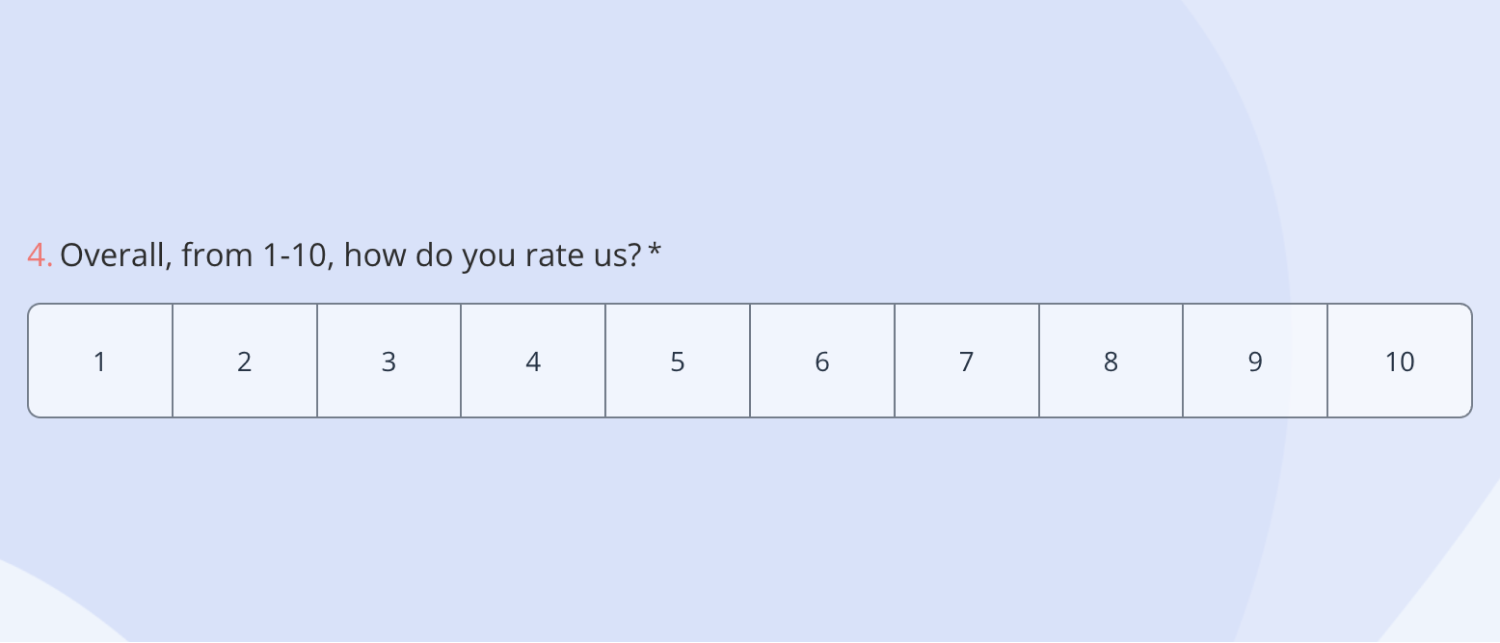
An opinion scale question example about satisfaction
Market research questions for a product
A market research question for a product is an excellent helper for companies to understand and collect data about existing. If you want to learn how your customers are satisfied with your exciting product, you only need to ask them these questions. Here are your market research questions for a product:
8. Have you ever heard of this product before?
9. From 1-10, how would you rate this product?
10. Do you believe this product is useful/helpful for you?
11. What is the likelihood of buying this product again?
- Very Likely
- Very Unlikely
12. What do you like about this product?
- It is easy to use
- It is cost-effective
- It is reliable
- It has great customer service
- It has a wide range of features
13. What do you dislike about this product?
- Functionality
14. Would you recommend this product to your friends or family?
You can replace the word “ product” with the name of your own product.
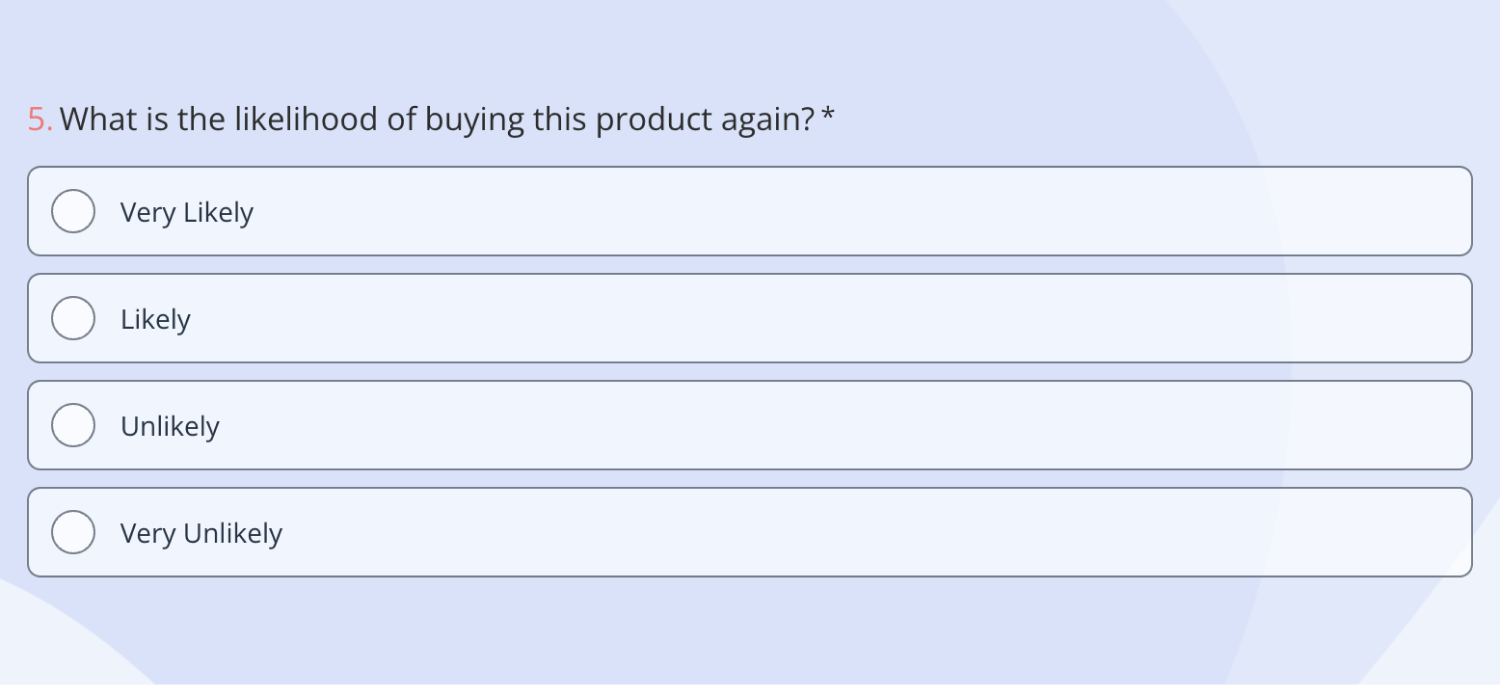
A question example about purchasing behavior
New product market research survey questions
New product market research survey questions are perfect for your company if you plan for a new product. Imagine that you are about to launch a new product. You can take fewer risks if you ask questions about the new product before launching it. So you might need these market research questionnaire questions for your new product:
15. Have you seen a similar product?
16. How likely are you to use this product for your business activities?
17. What do you think is the best feature of this new product?
18. What do you think is the least favorite feature of this new product?
19. Do you find the price reasonable?
20. Are you excited about this product?
21. Overall, from 1-10, how do you rate this new product?
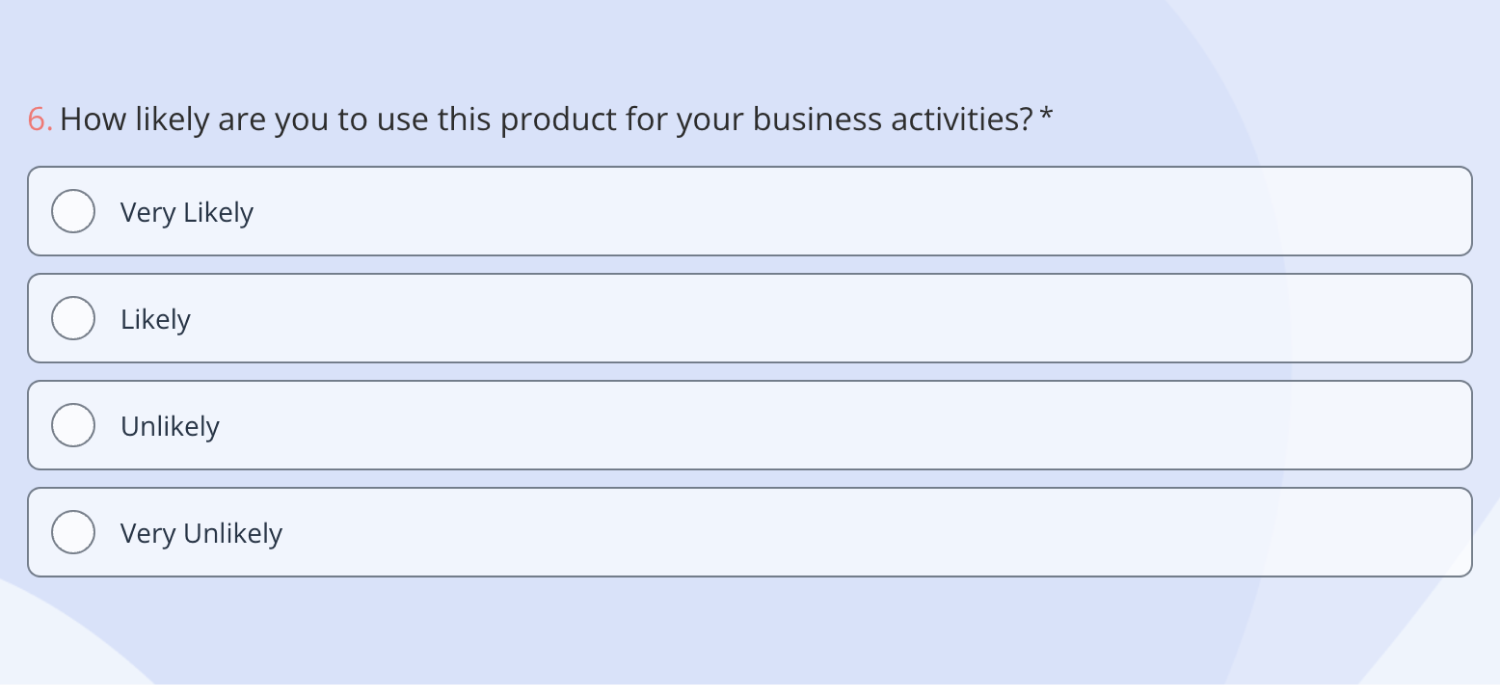
A question example about later use
Social media survey questions for market research
Social media is an excellent way of collecting helpful data from your customers because, today, nearly everybody has a social media account. You can have insightful data as long as you know which platform to use and how to use it. So, here are your social media survey questions for market research:
22. Which social media platforms do you use? ( you can choose more than 1 )
23. In which social media platforms do you spend time the most?
24. Do you follow us on your social media accounts?
25. What do you think about our company’s social media account?
- It's great!
- It could use some improvement.
- I haven't seen it
26. Do you believe we can use social media effectively?
27. What can we do to improve our social media accounts?
- Post regularly
- Run contests and giveaways
- Use relevant hashtags
- Optimize profile information
- Respond to comments
- Collaborate with influencers
28. Which influencers do you relate to us the most?
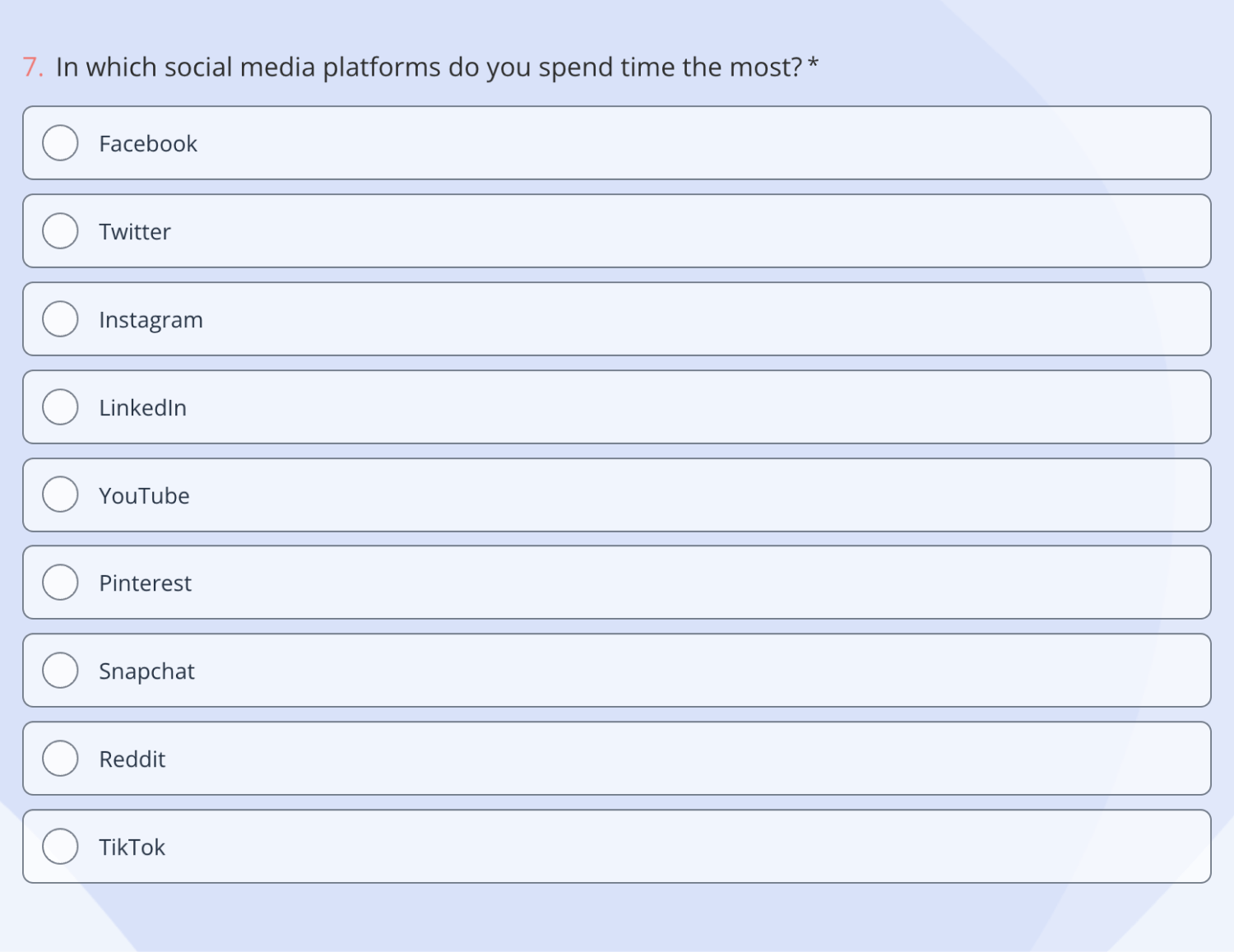
A market research survey question example about social media
Market research questions to ask potential customers
As much as trying to hold your existing customers, you should also try to find potential customers and expand your network. Because only in this way you can grow your business. When you have good market research questions to ask potential customers, as given below, you can easily get what you need:
29. Have you ever heard us before?
30. When you think of our brand, what comes to your mind first?
31. Who is our rival for you?
32. What is your minimum budget?
33. What is your maximum budget?
34. Would you consider choosing our product/service?
35. What are your best aspects, you think?
Market research questions for B2B companies
Just like any sector, B2B companies need to do their best to run market research. As for their market research survey, the questions will be different because they need to aim at businesses directly. If you need them, here are your market research questions for B2B companies:
36 . Who is your ideal customer?
37. What really matters to your ideal customer?
38. Do you think you know your customers?
39. How can you know your customers better?
40. What is your customers’ annual income?
41. What do your customers do in their free time?
42. What attracts your customer?
Demographic questions for your market research survey
Demographic questions allow your company to understand your customer’s background better. Also, if you want to understand the certain characteristics of your target audience, demographic questions are the best option for you. Have a look at these demographic questions for your market research survey:
43. What gender do you identify as?
- Genderfluid
44. How old are you?
- 65 or Above
45. What is your marital status?
46. Can you please specify your ethnicity?
- African American
- Asian American
- Hispanic/Latino
- Native American
- Pacific Islander
- White/Caucasian
47. Where are you located?
- United States
- United Kingdom
48. What is your education level?
- High School
- Associate's Degree
- Bachelor's Degree
- Master's Degree
- Doctorate Degree
49. What is your annual income?
- $0 - $25,000
- $25,001 - $50,000
- $50,001 - $75,000
- $75,001 - $100,000
- $100,001 - $150,000
- $150,001 - $200,000
- $200,001 and above
50. What is your current employment situation?
- Employed full-time
- Employed part-time
- Self-employed
- Not looking for work

A market research survey question example about income
- How can I create a market research survey?
In order to collect essential data for your market research, if you want to handle it the fastest way, you will need an online form builder. Also, if you want to build your form with lots of options and create just like you wish and want to do all of them for free, there is only one option left: forms.app .
As long as you follow some basic steps, you can easily create your market research survey and here are the steps:
1. Login or create an account
Firstly, you should log in to your existing account if you do not have one; no worries, you can easily and quickly create an account . Also, do not forget that you have the opportunity to log in via Google, Facebook, and Apple accounts.
2. Start from scratch, choose a temple, or generate with AI
You have access to a wide range of options thanks to forms.app . You must begin from scratch if you wish to pick every aspect of your survey. The site offers pre-made market research survey templates if you do not want to spend too much time on it. However, if you stay current with the latest technology, artificial intelligence can create your survey in seconds!
3. Add your market research survey questions
Based on your company’s primary needs and essential requirements, you should choose your market research survey questions very carefully. Each company’s priorities can differ. For that reason, you need to pay attention while adding them.
4. Customize your survey form
In this step, you can easily change and personalize your online survey . To give an example, you can change the size and type of the font, colors, and order of questions, add your brand’s logo, etc.
5. Share your market research survey
In the final step, you can share your survey with your target via many platforms . You can choose the link to be public, limited, or private while sharing. Additionally, you can preview the link to see whether it has any meta titles, descriptions, or images.
- How can I write good market research questions?
One can randomly create market research questions for the survey; however, if you want to be one step ahead of your rivals and be good at writing market research questions, you need to follow the points given below:
- Consider your company’s needs : You need to have a moment and consider what your company needs the most. What are your priorities or urgent needs? Or what are your urgent deficiencies to be covered? After answering these questions, you can create better questions.
- Think like the customer: The key point is listening to your customers and trying to think like them. When you think like them, you can come up with better market research questions and collect more valuable data for your survey.
- Be direct: Questions asked directly are definitely better , instead of asking too many indirect questions or long and complex sentences that might be confusing. So, you need to pay attention at this point.
- Key points to take away
As we have discussed so far, the importance of market research is undeniable. If you want to increase your market share and be more successful in your sector, there are some key points for your company to take away. You should not ignore these points:
- Design of the survey: Do not forget that the more you pay attention to your market research survey design, the more you will seem professional.
- Pay attention to the context: Design is an important factor, but context is the exact reason you run a survey. So, you need to be careful with your questions.
- Check the result: At the end of the survey, checking and analyzing the results is a key point. If you will not do that, there is no need to share the survey, isn’t it?
Now that you have read so far, you know all the critical points about the issue and where to start. Take action now and start finding your own effective data collection methods for market research !
Şeyma is a content writer at forms.app. She loves art and traveling. She is passionate about reading and writing. Şeyma has expertise in surveys, survey questions, giveaways, statistics, and online forms.
- Market Research
- Form Features
- Data Collection
Table of Contents
Related posts.
-min.png)
The top 11+ AskNicely alternatives (pros & cons)

The best features to use for creating more customized online forms
forms.app Team

5 awesome tips to create exquisite forms on mobile
68 market research questions to ask (and how to ask them)
Example market research questions, market research questions to ask customers, market research questions for product development, market research questions for brand tracking, pricing survey questions for market research, how to write your own market research questions.
No two market research projects are alike, but happily there are some tried-and-tested questions you can use for inspiration to get the consumer insights you’re looking for.
It’s all about asking questions that are most relevant to the goals of your research. Every so often the best questions are actually quite straightforward, like asking consumers where they do their grocery shopping.
If you’re creating a customer profile, you’ll ask different questions than when you’re running creative testing with your target audience, or getting insights on key consumer trends in your market.
The right market research questions are the ones that will lead you to actionable insights, and give you a competitive advantage in your target market.
Let’s kick this off and get straight into some questions, shall we?

Where do we even begin with this?! There are so many types of research and we’ll get into which questions work for each below, but here are some classic example market research questions to get you started.
These particular questions are good for surveys that you might run when you’re running some essential consumer profiling research.
- Which of these products have you purchased in the last 3 months?
- Which of the following types of >INSERT YOUR PRODUCT/SERVICE CATEGORY< do you buy at least once a month?
- Approximately, how much would you say you spend on >INSERT YOUR PRODUCT/SERVICE CATEGORY< per month?
- What is stopping you from buying more of >INSERT YOUR PRODUCT/SERVICE CATEGORY<?
- When was the last time you tried a new >INSERT YOUR PRODUCT/SERVICE CATEGORY<?
- Please rank the following on how important or unimportant they are when deciding which >INSERT PRODUCT CATEGORY< to buy?
- Which of these brands are you aware of?
- Which of these brands have you purchased from in the last 3 months?
- How do you prefer to shop for >INSERT YOUR PRODUCT/SERVICE CATEGORY<?
- Why do you prefer to shop online?
- Why do you prefer to shop in-store?
- Thinking about the following, how often do you use/listen/watch each of these media?
- Where do you go to keep up to date with the news?
- Which social media platforms do you use daily?
- What mobile phone do you currently own?
Surely you want to talk to your current customers to understand why they buy from you and what they think about your products?
Correct! But your consumer research should definitely not end with current customers!

Here’s why you should think about broadening your research to include other groups and different market research methods :
- Current customers: This is a must! Running research to your current customers will help you understand how you can make your product or service better. These are the people who’ve spent their hard-earned cash on your products so they have a unique perspective on what kind of value you offer. In addition, understanding why your existing customer base chose your brand over others can help you create messaging that resonates with people who are still on the fence.
- Previous customers: People who used to buy your products but don’t anymore can give you valuable insight into areas you might need to improve. Perhaps your brand perception has shifted making some customers buy elsewhere, or maybe your competitors offer customers better value for money than you currently do. These are the kinds of areas you can learn about by running research to previous customers.
- Non-customers: You should also ask people who haven’t bought your products why they haven’t. That way you’ll learn what you need to improve to bring new customers in. You should ideally ask the same kinds of questions, so that you can learn about what product features you need to work on but also things like the messaging you should be putting out there to win people over.
Here are some questions that are perfect for competitive market analysis research. Some of these questions might sound similar to some from our previous section on consumer profiling—that’s because there’s often some crossover between these types of research. Consumer profiling often refers to a more general type of research that covers similar ground to market analysis. If you’re wondering how to calculate market size , questions like these would be a great starting point.
- How often do you usually purchase >INSERT YOUR PRODUCT/SERVICE CATEGORY<?
- Why do you buy >INSERT YOUR PRODUCT/SERVICE CATEGORY<?
- What types of >INSERT YOUR PRODUCT/SERVICE CATEGORY< do you buy?
- How often do you buy the following types of >INSERT YOUR PRODUCT/SERVICE CATEGORY<?
- Where do you buy your >INSERT YOUR PRODUCT/SERVICE CATEGORY<?
- Where do you find out about >INSERT YOUR PRODUCT/SERVICE CATEGORY<?
- Which of these brands have your purchased in the last 12 months?
- How would you feel if you could no longer buy >INSERT YOUR PRODUCT/SERVICE CATEGORY<?
- How important or unimportant do you find the following topics? (e.g. sustainability, diversity and inclusion, ethical supply chain)
- What could be improved about the products you currently use?

By involving consumers in the product development process, you can make sure that your products are designed to meet—and ideally exceed—their needs.
Product market research can be done at several points in the product development process, by asking potential customers in your target market questions about existing products (yours or competitors’), prototypes, or just your own early-stage product ideas.
You can dive into the customer experience, specific product features or simply find out if the product quality matches the value proposition you’re putting out there.
Sometimes you even get a surprising answer to the question: how does our product or service help people?
You might learn from the survey responses that customers are using your product in a different way than you intended, opening you up to new target markets and different product types in the future.
Asking these questions also allows you to get feedback on your designs, so that you can make necessary changes before the product is released. Here’s some inspiration for when you’re conducting product market research.
There are different types of new product development research. A key type is Jobs to be done research. This research digs into the practical reasons people buy products—the jobs they need to get done with a specific product. You use these insights to help you create products that will genuinely help consumers, and that they’ll ultimately want to buy.
- How many times have you carried out [INSERT ACTIVITY] in the last 12 months?
- How much time would you typically spend on this [INSERT ACTIVITY]?
- How important or unimportant is carrying out this [INSERT ACTIVITY]?
- How satisfied or unsatisfied do you feel when carrying out this [INSERT ACTIVITY]?
- What is the best thing about carrying out [INSERT ACTIVITY]?
- How does carrying out [INSERT ACTIVITY] make you feel? Please select all that apply
- What particular problems or challenges do you run into while carrying out [INSERT ACTIVITY]?
When you’re cooking up your brand’s next product, you’ll want to go through a concept testing phase. This is where you ask consumers what they think about your idea and find out whether it’s likely to be a success. Here are some of the questions you could ask in your concept testing research.
- To what extent do you like or dislike this idea/product? [ATTACH IMAGE]
- What do you like about this idea/product?
- What do you dislike about this idea/product?
- Is easy to use
- Sounds tasty
- Is good quality
- Is Innovative
- Is different from others
- Purchase this product
- Replace the product I currently own with this
- What other products this idea/product reminds you of? Please provide as much detail as possible including the product name.
- What feature(s), if any, do you feel are missing from this product?
- How would you improve this idea/product? Be as descriptive as possible!
- What issues do you solve through the use of this product?
- When can you see yourself using this product? Please select all that apply.
- The price for this product is $25.00 per item. How likely or unlikely would you be to buy this product at this price?
Get inspired with NPD survey templates
Our in-house research experts have created New Product Development (NPD) survey templates to give you the perfect starting point for your product research!
Does the perspective of new customers change over time? How do you compare to other brands, and how do you become the preferred brand in your market and increase that market share?
Brand perception and brand awareness are super important metrics to track. These insights can be used to improve customer experience and satisfaction on a higher level than just product: the relationship you have with your customers.
This research can also help you understand how to reach the holy grail of branding: turning loyal customers into brand ambassadors.
You should also remember to ask marketing research questions about your brand to existing and potential customers.
Existing customers might have a different view after having interacted with your team and products, and you can use that to manage the expectations of your target customers down the line. And potential customers can help you understand what’s holding them back from joining your customer base.
Top tip: it’s completely fine (and super beneficial!) to run brand tracking into your competitors’ brands as well as your own. Replicating research for different brands will give you a tailored benchmark for your category and position.
Here are some key questions to ask in your brand tracking research.
- Which of the following, if any, have you purchased in the past 12 months?
- Thinking about >INSERT YOUR CATEGORY<, what brands, if any, are you aware of? Please type in all that you can think of.
- Which of these brands of facial wipes, if any, are you aware of?
- Which of these facial wipe brands, if any, have you ever purchased?
- Which of these facial wipe brands, if any, would you consider purchasing in the next 6 months?
- e.g. Innovative
- Easy to use
- Traditional
- We’d now like to ask you some specific questions about >INSERT YOUR BRAND<.
- When did you last use >INSERT YOUR BRAND<?
- What do you like most about >INSERT YOUR BRAND<?
- What do you like least about >INSERT YOUR BRAND<?
- How likely would you be to recommend >INSERT YOUR BRAND< to a friend, family or colleague?
- Why did you give that score? Include as much detail as possible
- In newspapers/magazines
- On Instagram
- On Facebook
- On the radio
- Through friends/family/colleagues
- When did you last use >INSERT MAIN COMPETITOR BRAND<?
- How likely would you be to recommend >INSERT MAIN COMPETITOR BRAND< to a friend, family or colleague?
Kick off your brand tracking with templates
Track your brand to spot—and act on!—how your brand’s perception and awareness affects how people buy. Our survey templates give you the ideal starting point!
When it comes to pricing your product, there’s no need to wing it—a pricing survey can give you the insights you need to arrive at the perfect price point.
By asking customers questions about their willingness to pay for your product, you can get a realistic sense of what price point will be most attractive to them and, not unimportant, why.
Top tip: good pricing research can be tough to get right. Asking how much people would theoretically be willing to pay for a product is very different from them actually choosing it in a shop, on a shelf next to competitors’ products, and with a whole load of other economic context that you can’t possibly test for. Price testing is useful, but should sometimes be taken with a pinch of salt.
Here are some questions you could use in your pricing research.
- Which of the following product categories have you bought in the last 12 months?
- How often do you currently purchase >INSERT YOUR CATEGORY<?
- At what price would you consider this >INSERT PRODUCT CATEGORY< to be so expensive that you would not consider buying it? (Too expensive)
- At what price would you consider this >INSERT PRODUCT CATEGORY< to be starting to get expensive, so that it is not out of the question, but you have to give some thought to buying it? (e.g. Expensive)
- At what price would you consider this >INSERT PRODUCT CATEGORY< to be a bargain—a great buy for the money? (e.g. cheap)
- At what price would you consider this >INSERT PRODUCT CATEGORY< to be priced so low that you would feel the quality couldn’t be very good? (Too cheap)
- How much do you currently pay for >INSERT PRODUCT CATEGORY<? Please type in below
- Thinking about this product, please rank the following aspects based on how much value they add, where 1 = adds the most value 10 = adds the least value.
- Thinking about the product category as a whole, please rank the following brands in order of value, where 1 is the most expensive and 10 is the least.
Formulating market research questions can be tricky. On the one hand, you want to be specific enough that you can get tangible, useful answers. But on the other hand, you don’t want to ask questions that are so difficult or unclear that respondents will get frustrated and give up halfway through.
Think about what answers you need and what actions you are hoping to take based on those answers.
We’ll help you get started with a list of steps to take when formulating your own market research questions, and putting them together in a survey that makes sense.
1. Define your research goals and link them to actions you can take
Before you can write great market research questions, you need to know what you want to learn from your research.
What are your goals? What do you want to find out? Once you have a clear understanding of your goals, you can start brainstorming questions that will help you achieve them.
2. Know your target market and the language they use
Who are you conducting market research for? It’s important to know your audience before you start writing questions, as this will help you determine the best way to phrase them.
For example, if you’re conducting market research for a new product aimed at teenagers, you’ll want to use different language than if you were conducting research for a new financial planning service aimed at retirees.
3. Keep it simple, and break things into smaller pieces
Don’t make your questions too complicated. Stick to simple, straightforward questions that can be easily understood by your target audience.
The more complex your questions are, the more likely it is that respondents will get confused and provide inaccurate answers.
If you feel a question is too difficult, see if you can break it up into smaller pieces and add follow-up questions on top.
And don’t ever load two questions into one! This falls into Consumer Research 101, but it’s amazing how often it happens. Instead of ‘What’s your favorite chocolate bar, and why?’ ask two questions: ‘What’s your favorite chocolate bar?’ and ‘Why is this your favorite chocolate bar?’
4. Be super specific
Make sure your questions are specific enough to get the information you need. Vague questions will only lead to vague answers.
For example, instead of asking ‘What do you think of this product?’, ask ‘What did you think of the taste of this product?’ or ‘What did you think of the packaging of this product?’.
5. Avoid leading questions
Leading questions are those that suggest a particular answer or course of action. For example, instead of asking ‘Do you like our new product?’, which suggests that the respondent should like the product, try asking ‘What are your thoughts on this product?
This question is neutral and allows the respondent to answer freely without feeling pressured in any particular direction. It’s also brand-neutral: people answering this question will have no idea who’s asking, and their opinion won’t be biased as a result.
6. Make sure your question is clear
It’s important that your question is clear and concise so that respondents understand exactly what they’re being asked. If there is any ambiguity in your question, respondents may interpret it in different ways and provide inaccurate answers.
Always test your questions on a few people before sending them to a larger group to make sure they understand what they’re being asked.
7. Avoid loaded words
Loaded words are those with positive or negative connotations that could influence the way respondents answer the question. For example, instead of asking ‘Do you love this product?’, which has a positive connotation, try asking ‘What are your thoughts on this product?’
This question is neutral and allows the respondent to answer freely without feeling pressured in any particular direction
8. Make sure the question is answerable
Before you include a question in your market research survey, make sure it’s actually answerable. There’s no point in asking a question if there’s no way for respondents to answer it properly. If a question isn’t answerable, either revise the question or remove it from your survey altogether.
9. Use an appropriate question type
When designing your market research survey, be sure to use an appropriate question type for each question you include. Using the wrong question type can lead to inaccurate or unusable results, so it’s important to choose wisely. Some common question types used in market research surveys include multiple choice, rating scale, and open-ended questions.
10. Pay attention to question order
The order of the questions in your survey can also impact the results you get from your research. In general, it’s best to start with more general questions and then move on to more specific ones later on in the survey. This will help ensure that respondents are properly warmed up and able to provide detailed answers by the time they reach the end of the survey.
Make smart decisions with the reliable insights
To make sure you make smart decisions that have real impact on your business, get consumer insights you can rely on. Here’s our rundown of the top market research tools.
Survey questions for market research are designed to collect information about a target market or audience. They can be used to gather data about consumer preferences, opinions, and behavior. Some common types of market research survey questions include demographic questions, behavioral questions and attitudinal questions.
There are many different types of market research questions that companies can use to gather information about consumer preferences and buying habits. They can be divided into different categories, like a competitive analysis, customer satisfaction or market trends, after which you can make them more specific and turn them into survey questions. These are some of the things your research questions can help you answer: – What is the target market for our product? – Who is our competition? – What do consumers think of our product? – How often do consumers purchase our product? – What is the typical customer profile for our product? – What motivates consumers to purchase our product?
When conducting market research, surveys are an invaluable tool for gathering insights about your target audience. But how do you write a market research questionnaire that will get you the information you need? First, determine the purpose of your survey and who your target respondents are. This will help you to write questions that are relevant and targeted. Next, craft clear and concise questions that can be easily understood. Be sure to avoid ambiguity, leading questions and loaded language. Finally, pilot your survey with a small group of people to make sure that it is effective. With these tips in mind, you can write a market research survey that will help you to gather the crucial insights you need.

Elliot Barnard
Customer Research Lead
Elliot joined Attest in 2019 and has dedicated his career to working with brands carrying out market research. At Attest Elliot takes a leading role in the Customer Research Team, to support customers as they uncover insights and new areas for growth.
Related articles
5 beverage branding ideas (with examples you can learn from), survey vs questionnaire: what’s the difference and which should you use, what does inflation mean for brands, consumer profiling, subscribe to our newsletter.
Fill in your email and we’ll drop fresh insights and events info into your inbox each week.
* I agree to receive communications from Attest. Privacy Policy .
You're now subscribed to our mailing list to receive exciting news, reports, and other updates!
- (855) 776-7763
All Products
BIGContacts CRM
Survey Maker
ProProfs.com
- Get Started Free
FREE. All Features. FOREVER!
Try our Forever FREE account with all premium features!
100+ Market Research Questions to Ask Your Customers
Expert Writer
Dwayne Charrington shares insights on creating effective surveys, improving navigation, and using A/B testing for smarter decisions. Additionally, he focuses on optimizing mobile experiences and champions privacy-by-design, ensuring users feel satisfied, secure, and valued.

Asking the right market research questions can help you understand your target customers and map their behavior and preferences.
But what does it actually mean?
Let’s look at a sample from a market research survey report for mapping brand awareness:
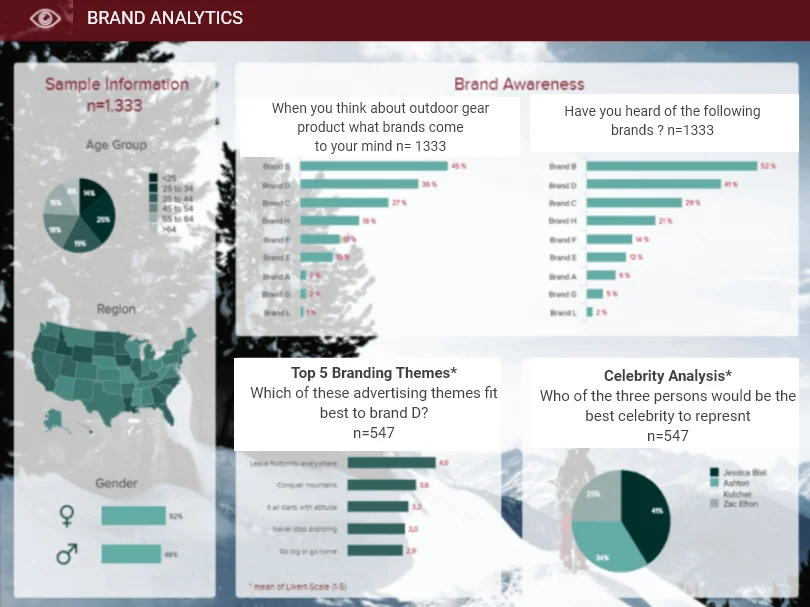
From this simple Q&A report, you can:
- Visualize the proportions of demographic segments among your audience.
- Measure how your brand is performing in comparison to others.
- Pick the top preferred brand among the customers, explore what makes it stand out, and apply the same techniques to your brand.
- See how your target market perceives brand advertisements and promotional efforts.
Now imagine if this type of data set is available for different aspects of your business – product development, marketing campaigns, optimization plans, and more.
That’s what market research does for you.
With the evolution of customer interaction points and constantly changing market trends, more and more businesses are fueling efforts to do in-depth market research, as evidenced by the steady increase in the revenue of the market research industry worldwide.
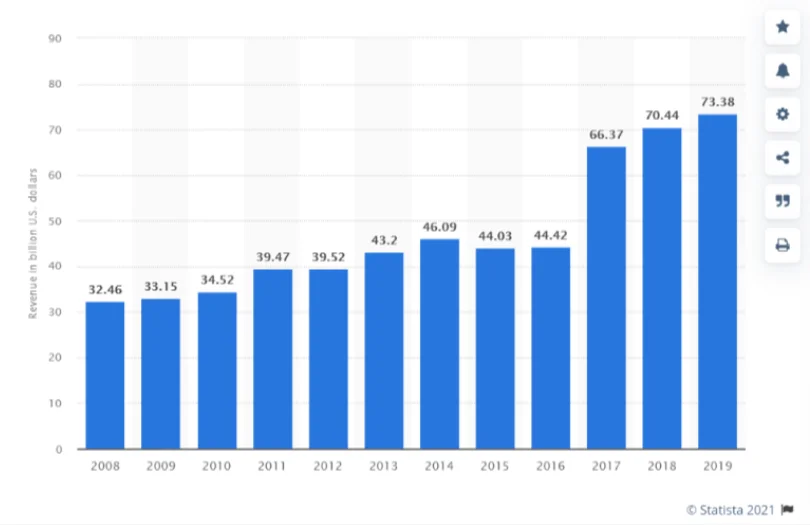
Market research can help you develop essential business strategies and maintain a competitive advantage over other brands to increase conversions and customer base.
And it all starts with asking the right questions to the right audience.
That’s why we have created this collection of 100+ market research questions to ask your target market. Each question aims to uncover a specific attribute about your customers. You can use a combination of these customer research survey questions, interviews, and othe marketing questionnaires for customers.
We have also added key tips to help you write your own effective market analysis questions if the needed.
100+ Great Market Research Questions to Ask Your Customers
The main challenge while designing and conducting research is – “What questions should I ask in my customer research survey?
That’s why we have a carefully curated list of market research questions to help you get started.
To Explore New Product Opportunities

- What was your first reaction to the product?
- Would you purchase this product if it were available today?
- What feature would you like to see on the website/product?
- Which feature do you think will help improve the product experience for you?
- Of these four options, what’s the next thing you think we should build?
- What’s the one feature we can add that would make our product indispensable for you?
- Would implementing [this feature] increase the usability of the [product name]?
- Please let us know how we can further improve this feature.
- What problem would you like to solve with our product?
To Collect Feedback on Existing Products
- Have you heard of [product name or category] before?
- How would you feel if [product name] was no longer available?
- How disappointed would you be if you could no longer use [Product/feature name?]
- How often do you use [product name]?
- How long have you been using [product name] for?
- When was the last time you used [product name]?
- Please rate the following product features according to their importance to you.
- According to you, In which area is this product/service lacking the most? Specify below.
- How does the product run after the update?
- Rate our product based on the following aspects:
- Have you faced any problems with the product? Specify below.
- What feature did you expect but not find?
- How are you planning to use [product or service]?
- How satisfied are you with the product?
To Segment the Target Market

Please specify your age.
- Please specify your gender.
- Select your highest level of education.
- What is your current occupation?
- What is your monthly household income?
- What is your current marital status?

- What is the name of your company?
- Where is your company’s headquarters located?
- Please specify the number of employees that work in your company.
- What is your job title?
- In which location do you work?
- Which activity do you prefer in your free time?
- Which other physical activities do you take part in?
- Where is your dream holiday destination?
- Please rate the following as per their priority in your life – Family, work, and social life?
- Are you happy with your current work-life balance?
- Do you describe yourself as an optimist or a pessimist?
- How often do you give to charity?
- How do you travel to work?
- How do you do your Holiday shopping?
To Conduct a Competition Analysis

- Which product/service would you consider as an alternative to ours?
- Rate our competitor based on the following:
- Have you seen any website/product/app with a similar feature?
- How would you compare our products to our competitors?
- Why did you choose to use our [product] over other options?
- Compared to our competitors, is our product quality better, worse, or about the same?
- Which other options did you consider before choosing [product name]?
- Please list the top three things that persuaded you to use us rather than a competitor.
- According to you, which brand best fits each of the following traits.
To Gauge Brand Awareness
- [Your brand name] Have you heard of the brand before?
- How do you feel about this brand?
- How did you hear about us?
- Describe [brand name] in one sentence.
- If yes, please tell us what you like the most about [your brand name]?
- If no, please specify the reason.
- How likely are you to purchase a product from this company again?
- If yes, where have you seen or heard about our brand recently? (Select all that apply)
- Do you currently use the product of this brand?
- Have you purchased from this brand before?
- Of all the brands offering similar products, which do you feel is the best brand?
- Please specify what makes it the best brand for you in the category.
- Which of the following products have you tried? (Select all that apply)
- On a scale of 1 to 10, how likely would you recommend this brand to a friend or colleague?
To Map Customers’ Preferences
- Have you ever boycotted a brand? If so, which brand and why?
- What influences your purchase decision more – price or quality of the item?
- How many hours do you spend on social media like Facebook, Instagram, etc.?
- How do you do your monthly grocery shopping – online or through outlets?
- How do you search for the products you want to buy?
- Rate the factors that affect your buying decision for [product].
- What persuaded you to purchase from us?
- How likely are you to purchase a product from us again?
- Please rate the following aspects of our product based on their importance to you.
- What is the most important value our product offers to you?
- Which of the following features do you use least?
- How well does the product meet your needs?
To Map Customers’ Reservations
- Is there anything preventing you from purchasing at this point?
- What’s preventing you from starting a trial?
- Do you have any questions before you complete your purchase?
- What is the main reason you’re canceling your account?
- What are your main reasons for leaving?
- What was your biggest fear or concern about purchasing from us?
- What is the problem that the product/service helped to solve for you?
- What problems did you encounter while using our [product]?
- How easy did we make it to solve your problem?
- What is your greatest concern about [product]?
- Have you started using other similar products? If yes, what made you choose that product?
To Perform Pricing Analysis
- Would you purchase the product at [price]
- According to you, what should be the ideal price of the [product name]?
- Is our product pricing clear?
- According to you, what is the ideal price range for the product?
To Collect Feedback on Website Copy
- Please rate the website based on the following aspects:
- How well does the website meet your needs?
- Was the information easy to find?
- Was the information clearly presented?
- What other information should we provide on our website?
- How can we make the site easier to use?
- What could we do to make this site more useful?
- Is there anything on this site that doesn’t work the way you expected it to?
- How easy was it to find the information you were looking for?
- Have feedback or an idea? Leave it here!
- Help us make the product better. Please leave your feedback.
To Assess Website/Product Usability
- Are you satisfied with the website layout?
- What features do you think are missing on our website?
- What features do you not like on our website?
- Was our website navigation simple and user-friendly?
- How much time did it take to find what you were looking for on our website?
- Was it easy to find the products you are looking for?
- Was the payment process convenient?
To Uncover Market Trends and Industry Insights
- Did you purchase our product out of peer influence or individual preference?
- How do you form your opinion about our product?
- Do you follow trends of the product, or do you prefer to go with what you know?
- Do discounts or incentives impact your decision-making process?
Market Research Survey Templates
One of the easiest ways to conduct market research is to use survey templates. They can help you save time and effort in creating your own market research surveys.
There are many types of market research survey templates available, depending on your objectives and target audience. Some of the most popular ones are:
- Demographic Templates: These templates help you segment your customers based on their location. It can help you tailor your marketing strategies and offers to different customer groups.

- Consumer Behavior Templates: These templates help you keep your pulse on your target market.
Industry Insights Templates: These templates help you get detailed information about your target industry and business.

Case Study:
Check out how AWA Digital increased revenue per customer for Avis by understanding the market and promoting add-on products.

Read Full Story Here
Breakdown of Different Market Research Questions
The answer choices in a market research survey question can significantly impact the quality and reliability of the response data you collect from the audience.
Some answer types help categorize the audience, while others measure their satisfaction or agreement.
So, before listing the customer research survey questions to ask your target audience, let’s understand their types:
Multiple Choice
A multiple-choice question type lets users select more than one answer from the given options. These questions are great for collecting multiple data sets using the same question and gauging people’s preferences, opinions, and suggestions .
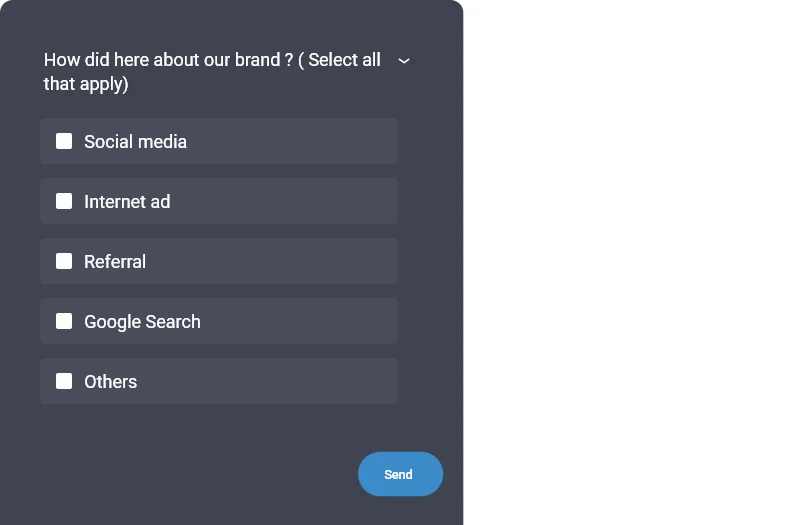
Single Choice
In a single-choice question, the respondent can select only one answer from the given options. This question type is great for:
- Segregating the users.
- Prioritizing product updates based on user consensus.
- Disqualifying irrelevant respondents by placing the question at the start of your customer research survey.
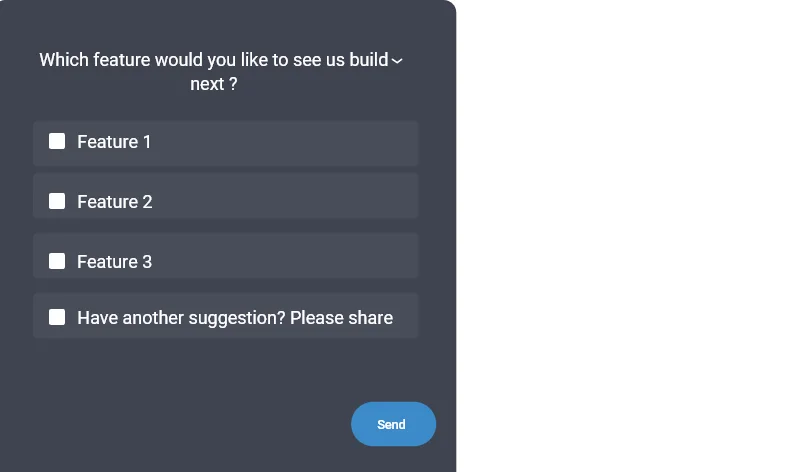
Matrix Match
A matrix matching grid can combine multiple market research questions into one to make the survey shorter . There is only one condition – the individual questions should have the same response anchors as shown in the image below:
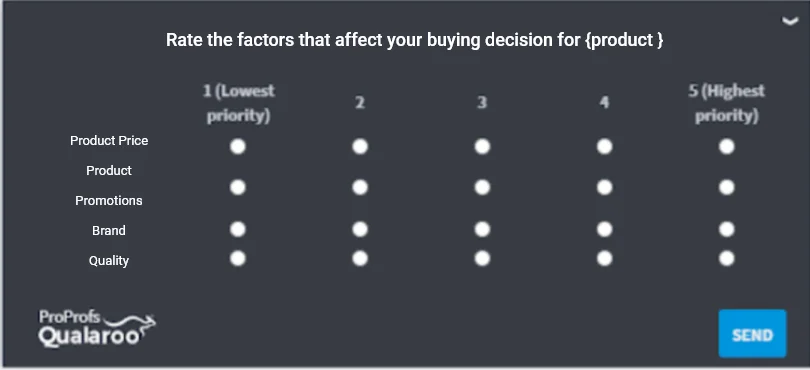
The questions are arranged in rows while the answer options occupy the grid columns.
Ranking Question
A ranking question can help map customers’ preferences and set priorities for product development . This question type asks the respondent to arrange the given options in their decreasing/increasing preference.
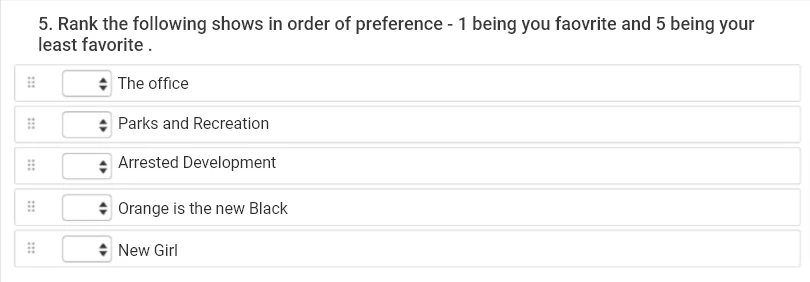
Dichotomous
A dichotomous question poses a simple yes or no scenario to the respondent. These question types can help disqualify irrelevant people from the survey and categorize the users into two groups .

Likert Scale
Likert scale market research questions can help you measure the extent of respondents’ agreement/disagreement with the given statement . The answer options are arranged from positive to negative sentiments or vice-versa, with the neutral option in the middle.
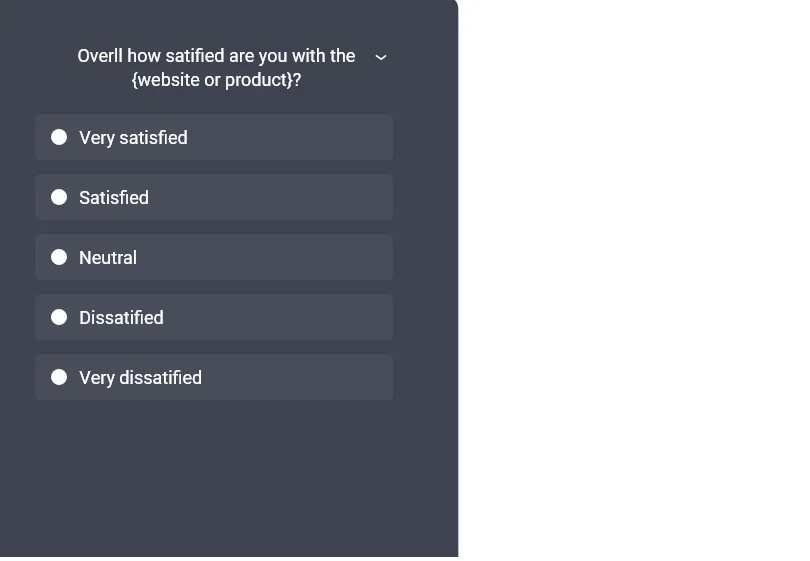
There are two types of Likert scales: 5-point and 7-point .
Open-ended market questions let you explore the respondents’ minds without adding any restrictions to the answer . This question type is followed by a blank space for the respondent to add a free-text response.

You can add an open-ended question as a follow-up after the first question to explore the reasons for the customer’s previous answer. It also lets you collect more in-depth information about their issues, pain points, and delights.
Tools like Qualaroo offer tons of different question types for your surveys. Just pick the question and match its answer option type from the drop-down. To make it more effective, you can add branching to the survey.
How to Write Your Marketing Research Questions
It’s imperative to have a dedicated repository of market research questions for your surveys. But nothing’s better than crafting your questions.
For this, you need to sit with your team and discuss what information you require from the customers. It lets you analyze and document how much data you already have in your system, which can help set the market research scope.
We have listed some questions you need to ask yourself before asking market research questions to your potential customers or target market:
Audience Segmentation Questions
Audience segmentation questions help to size up your target market and provide a granular view of the audience . Not all customers are equal, and audience segmentation makes it possible to focus on each group individually to address their issues, fears, and expectations.
Here’s what you need to know before you start writing customer research survey questions to understand your audience:
- Do we understand the demographics of the new market we are trying to target? (Age, location, ethnicity, education, company, annual income, etc.)
- What are the locations that drive the most customers to our business? How are these locations different from others?
- What are the interests, preferences, and fears of people from our new target market? Have we addressed these situations for our current customer base?
- What are the psychographics attributes of the current customers and potential market? Are we targeting these in our campaigns?
- What are the most popular engagement channels for our customers? Which channels drive the most traffic to our website?
- Do we have enough data to perform value segmentation to separate high-value customers from low-value customers?
- How often do these high-value customers make a purchase?
Product-Based Market Research Questions
Product-based market research questions can produce precious insights to channel into your product development and optimization strategies . You can see how changing technology affects customers’ behavior, what new features they want to see in your product, and how they perceive your products and services over the competition.
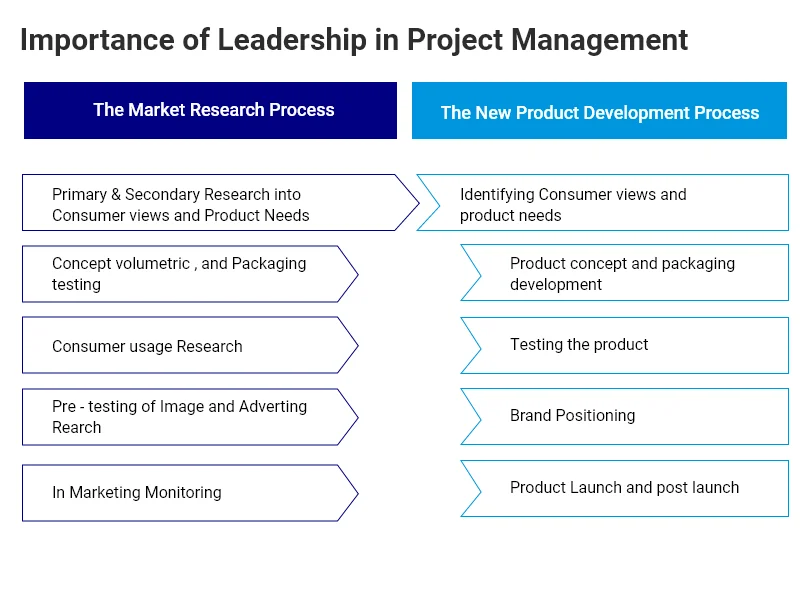
Start by gathering information about the following:
- How does our product compare to the competition based on the features?
- What products do our competitors offer?
- What new features do customers want to see in our products? Do we have a product roadmap to deliver these updates?
- What unique solutions do our products offer? What is the value proposition that reflects this offering?
- Does our product incorporate the latest technological advancements?
- What channels do we use to collect product feedback from our users?
- What are customers’ preferences while choosing our products over competitors?
Pricing Market Research Questions
Pricing analysis can help you make your product more affordable to different customer segments while maintaining the desired gross margin. It also lets you restructure the pricing tiers to provide features depending on the customers’ requirements and company size .
Watch: (1/5) Supercharge Your Revenue With Data-Driven Pricing
Your sales and marketing team can help you hone in on the market research questions to ask your customers for running pricing analysis:
- Do the customers ever complain about the difficulty in finding the pricing information?
- What is the pricing structure of our competitors for the same products? What features do they include for a specific price?
- How do customers find our pricing when compared to the competitors?
- Do our products provide value for money to the customers? Does the sales pitch reflect this point?
- Can we restructure the pricing, and how will it affect the revenue?
- Are there any customer segments that have high-value potential but find the current pricing unaffordable? What are the plans for such customers?
- Are we in a situation to offer a basic free plan to encourage customers to try our product before upgrading?
- What promotions can we run to attract more customers?
- Should we target customers based on income, company size, or type of solution to set our product prices?
Brand Reputation Market Research Questions
A brand reputation questionnaire for marketing research gives you information on how well your target market knows about your brand. You can uncover previously unidentified channels to increase brand awareness and find potential customers to promote your brand .
Start by gauging what customers are saying about your brand:
- Which channels receive mentions of our brand? Are these posts positive or negative?
- Do we have a system in place to analyze and monitor these reviews and posts?
- What are the reviews of our brand on different sites? What is the overall impression of our brand in the market?
- How are we currently addressing the negative reviews and complaints? What do our customers think about the handling process?
- What is the impression of our brand in our target market?
- What brand awareness campaigns are our competitors running?
- Is our brand among the top choices of our target customers?
Advertisement & Campaign-Based Questions
These customer research survey questions let you assess the effectiveness of your current value propositions and campaigns . You can channel the customer insights into your advertising strategies to design targeted campaigns for different customer segments to reduce the overall acquisition cost and increase conversions.
Ask the following questions to collect information about the different marketing campaigns that are performing:
- What are the best modes to run the advertisement campaigns to reach our target audience?
- What is the estimated lifetime value of customers acquired from current campaigns? Is it higher or lower than the acquisition costs?
- Which campaigns bring the most ROI and why?
- How well do our advertisements present our value proposition to the customers? Do they address customers’ fears and expectations to attract them?
- Are we running A/B tests to improve our online campaigns? How are we gathering data to build the A/B test hypotheses – surveys, heatmaps, eye tracking, etc.?
- What advertisement campaigns do our competitors run?
7 Question Types to Use in Market Research Surveys
We mentioned earlier that market research questions provide important data for different operations like product development, marketing campaigns, sales pipeline and more.
But to what extent?
Let’s break it down to individual processes and understand how insights from customer research surveys can impact them:
To Know Your Target Market
Understanding your target audience is the fundamental aspect of market research, be it a new target market or existing customers. If you know what marketing research survey questions to ask your target market, you can identify different customer types’ unique traits and preferences.
The data can help you segment the users based on demographic, psychographic, geographic, and other attributes. These include their behavior, purchase preferences, age, location, habits, delights, frustrations, and more.
You can then create various customer personas and fuel your sales strategies to maximize ROI.
Case study – How Avis increased its revenue per customer
Avis, a leading car rental company, was looking to enhance customer experience by offering useful car add-ons like navigation systems, child seats, insurance, etc., to customers with their booking. So, it reached out to AWA Digital to find a way to promote these products and increase their sales.
AWA digital implemented customer research campaigns using targeted surveys to determine which add-ons were popular among the customers and why.
Using these insights, the team added an interstitial pop-up just before the booking page to show relevant add-ons to the customers.
This simple update dramatically increased the sales of add-on items and helped Avis generate more revenue per customer.
Read the entire case study here .
To Plan the Product Roadmap
A product roadmap is a visual representation of the current status of your product and planned updates over time. It shows a high-level summary of planned activities and priorities for different teams to take the product to the next level. Understanding different types of summary can help you create more effective and concise roadmaps that clearly communicate your vision and strategy.
Steve Jobs famously said – “You’ve got to start with the customer experience and work backward to the technology. You can’t start with the technology then try to figure out where to sell it.”
And market research helps to align your product strategies with the customer demand. Using targeted marketing survey questions, you can gauge what new features or functionality customers want to see in your products.
It helps to plan product development strategies based on customers’ consensus to prioritize the ideas that can have the most impact on customers and replace intuition-based approaches with data-backed decisions.
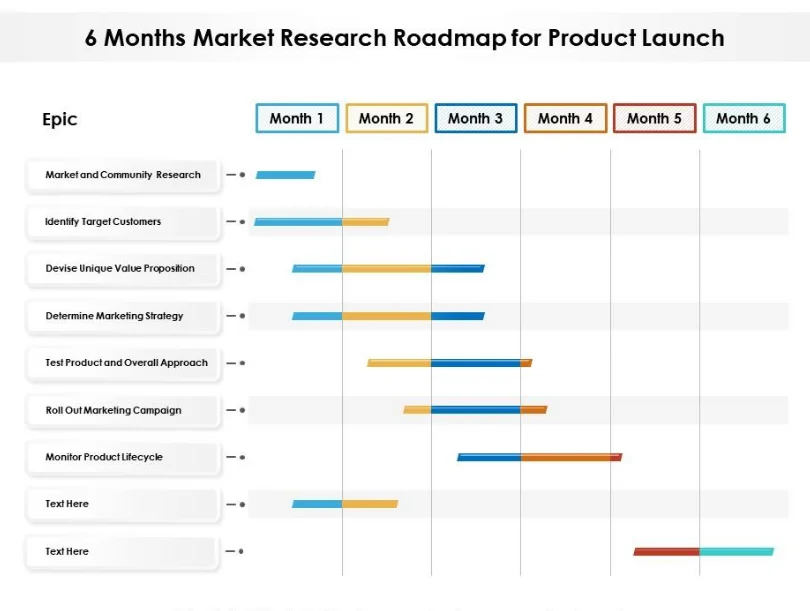
Customers’ demands change with market trends and technological advancements. That’s why your product map also needs to evolve constantly with time to reflect these changes in your product development cycle.
By designing targeted market research questions to ask the customers, you can uncover their expectations to deliver optimal product solutions.
That’s what our next case study demonstrates.
Case study – How customer research drives Twilio’s operations
Twilio, a cloud communications platform places customer discovery and research at the core of their product development strategies. It helps its teams to anticipate customer needs in a constantly changing market.
Lack of time and budget are the two biggest challenges that the company faces in its product development cycle. So, the team uses targeted market research questionnaires for a product to understand the challenges the customers face today and the ones they will face tomorrow.
With an abundance of ideas and no time to test them all, the feedback data from surveys is used to prioritize the hypotheses to run the tests. It makes the process more efficient and effective in producing positive results.
This data-backed approach is used across 18 different teams at Twilio to release new functionality every week and deliver optimal solutions to the clients.
Read the complete case study here .

To Reduce Acquisition Costs
Your customer base consists of multiple customer segments with different preferences and purchase potential. That’s why you cannot sell to everyone and need to find the right audience for your products.
If an acquired customer doesn’t bring in more revenue than it costs to acquire them, it will increase your acquisition costs over time.
We don’t want that, do we?
For example, let’s say you are targeting the entire market population using the same campaign. If your acquisition cost per customer is $300 and you acquire 20 customers from one campaign, you need to make more than $6000 to register profits.
The difficulty is you don’t know about these customers’ purchase behavior and capacity, so you cannot be sure if you will reach your goals. It adds unnecessary risks to your marketing ventures.
But, if you were targeting a specific segment with high income, regular shopping habits, or proven history of brand loyalty, You can obtain better results.
Now, the question is –
How will you separate these potential long-term customers from one-time buyers and high-value targets from other segments?
One way to do this is by building customer personas using the data from the market research survey questions. A buyer persona defines different attributes of a particular customer segment so you can hone in on the right audience to funnel your marketing efforts.
Here’s what a typical persona includes:
- Target regions
- Target demographic (age, marital status, gender)
- Ideal psychographics (hobbies, social channels, activities they indulge in, goals)
- Preferred interaction channels
- Favorite brands and products
- Total revenue till date
- Estimated lifetime value
Once you have a clearer picture of different customers, you can find high-value prospects with the potential to be long-term customers looking for product solutions that your business offers.
You can then design the correct pitch using the market research data to bring in these customers and control the overall acquisition costs.
For example:
- Plugin the demographic and psychographic data into CRM software like BIGContacts or Salesforce to convert high-value targets.
- Use your CRM to create segmented lists of prospects based on estimated value, location, current status, and more. Then target these groups individually with personalized value propositions to increase conversion rates.
- Identify their preferred mode of communication and technographic inclinations to find the right opportunities to pitch your product offering at the precise moment.
Even if acquiring and retaining such customers costs more, their overall revenue can balance the acquisition costs to deliver higher profits.
To Design Targeted Marketing Campaigns
By knowing how your target audience behaves and interacts with your business, you can find the exact opportunities to target them with personalized campaigns.
- You can use mail campaigns to target website users with app-exclusive offers to encourage them to download your app and improve app adoption.
- Add in-app broadcast messages about upcoming offers, exclusive membership benefits, and other incentives for new users to push them towards the end of the funnel.
- Create multiple landing pages to target different customer types.
- Design location-based ad campaigns with personalized value propositions based on audience preferences and problems at each location.
Case Study – How Canon’s campaigns generated 700% ROI
AWA digital was tasked by Canon, one of the biggest electronics companies worldwide, to assess and increase the demand for their products in different geographies. So, the AWA team conducted customer research using target market survey questions and discovered the following attributes about customers’ purchase behavior and reservations:
- In some regions, people were reluctant to spend money on a Canon camera as they weren’t sure if Canon was an authoritative brand.
- In other regions, authority was not as important to the users.
Using these insights, AWA optimized the ads campaigns’ messaging for different locations to include what consumers deemed important purchase factors.
The results?
With in-depth customer feedback, Canon generated an overall ROI of 700% in all regions using personalized campaigns to target the audience.
To Improve Brand Awareness
Whether you are into soft drinks or not, You probably would have heard of Coca-Cola’s 2011 Share-A-Coke ad. This single campaign put the Coke brand back on the map and reversed the 10-year steady decline in sales in the US.
Coke understood what motivates their customers and delivered a product offering that appealed to the masses to increase its brand equity- the excitement to get a Coca-Cola bottle with their name on it.
How did they do it?
In 2011, Coca-Cola rolled out its share-a-coke campaign in Australia. The company debranded the traditional Coke logo from the bottle and replaced it with the phrase “Share a Coke with” followed by a name.
The campaign used the list of the country’s most popular names (nicknames). The purpose was to make people go out and find the Coke bottle with their name on it and share it with their friends. The campaign was subsequently rolled out in 80 countries.
How did it impact Coca-Cola as a brand:
- In Australia, it’s estimated that the campaign increased Coke’s share by 4% and increased consumption among young adults by 7%.
- #ShareACoke became the top trending hashtag on Twitter globally and received over 1 billion impressions.
- In the USA, the campaign increased Coke’s market share by over 2% and brought 11% more sales compared to the previous year.
It’s not limited to big brands only.
Understanding the customers and placing your product’s value offering along with their habits, lifestyle, and behavior can help you extend your brand’s reach.
Today, there are multiple touchpoints to connect with your customers and map their journey to uncover their issues, motivations, and fears to address in your campaigns.
- Monitor brand mentions on social media and engage with the users to cultivate an online community and promote your brand.
- Reach out to satisfied customers and turn them into your brand ambassadors.
- Use targeted ad campaigns that connect people’s emotions and general behavior to imprint your brand’s image in their minds.
Quick Tips for Writing Awesome Market Research Survey Questions
With the inter-team research complete, you are ready to write your own market research questions to ask your target audience. Keep these general dos and don’ts in mind to ensure that the market survey fulfills the purpose without affecting the data quality or response rate.
Use Mutually Exclusive Response Options
If you are using response anchors with specific ranges like age group or income, check that the options do not overlap . Otherwise, it will produce an irregular data set.
Please specify your age:
In the above example, the respondent lying on either extremity of the given age ranges may get confused on which option to choose. For example, a 28-year-old respondent can choose from both second or third options.
Plus, two different respondents of the same age may select different options, which will skew your demographic data.
You can avoid this confusion by creating mutually exclusive groups as shown below:
Always Add A “Not Applicable” Or “Rather Not Say” Option
Since market research questions extract personal information, some respondents may not want to share such details with you. These include questions about age, income, gender, hobbies, social activities, and more.
Forcing such questions on the customers without allowing them to skip can irate them and lead to survey abandonment .
That’s why you can also use Qualaroo’s skip and branching logic to create smart surveys that only ask relevant questions to your respondents based on their previous answers.
Calculate the Required Sample Size
Sample size plays a vital role in your market research questions to determine the reliability of your response data.
If the response volume is low, the results may not be conclusive to point towards customers’ consensus. On the other hand, a larger sample size than required means a waste of the company’s valuable resources and time.
That’s why it’s important to calculate the required sample size to estimate the number of responses you need for your market research survey questions.
You can use any survey sample size calculator available online to get started. Just fill in the required details to get the required sample size.
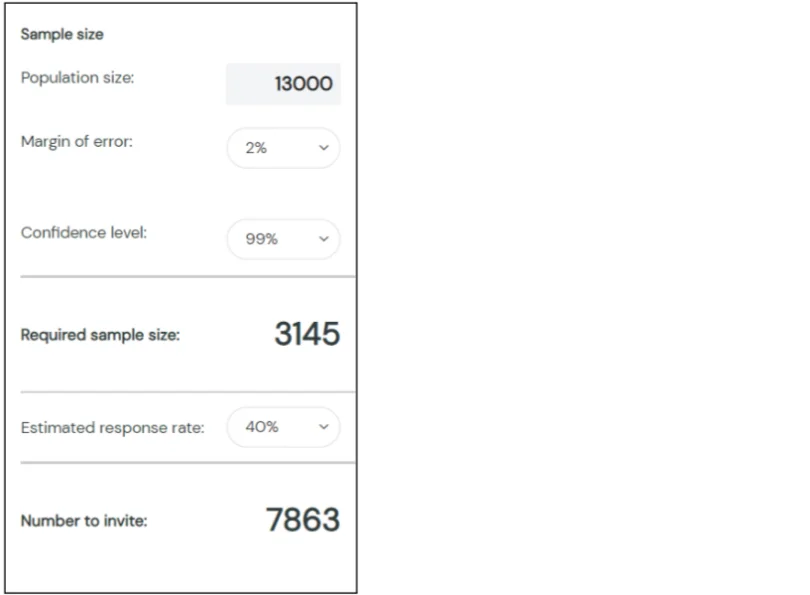
For example, to reach a statistical significance of 99%, you need at least 3145 responses to your market research questionnaire.
Consider Adding Incentives
Studies show that incentivized customer research surveys or questionnaires fetch higher response rates than general surveys.
The incentives encourage customers to invest their time in a survey and get something in return.
It means creating a gated questionnaire for market research can help you reach the required sample size quickly . The incentive can be a simple discount code, free shipping coupon, free ebook, or other freebies.
However, there is a possibility that irrelevant respondents may fill out the survey randomly just to get to the offer, which may skew the results. You can use screening questions to filter out unsuitable respondents.
Avoid Double-Barreled Market Research Questions
A double-barreled question poses two questions into one. The problem with such questions is that the respondent may have opposing views about the two statements in the questions. It makes it harder for them to choose one answer from the options .
“Please rate the [product name] on a scale of 1-10 based on overall quality and price?”
Here, the respondent may find the product quality appreciable while thinking it to be overpriced at the same time. In such a case, they may skip the question or select any option randomly.
You can easily sidestep this hurdle by breaking your double-barreled market research question into two to make it less confusing for the respondents.
Importance of Market Research
We mentioned earlier that market research questions provide important data for different operations like product development, marketing campaigns, sales pipeline, and more.
Understanding your target audience is the fundamental aspect of market research, be it a new target market or existing customers. If you know what customer research survey questions to ask your target market, you can identify different customer types’ unique traits and preferences.
AWA Digital implemented research campaigns using targeted customer research surveys to determine which add-ons were popular among the customers and why.
Case study – How customer research drives Twilio’s operations
Twilio, a cloud communications platform, places customer discovery and research at the core of its product development strategies. It helps its teams to anticipate customer needs in a constantly changing market.
Lack of time and budget are the two biggest challenges that the company faces in its product development cycle. So, the team uses targeted market research questionnaires for a product to understand the challenges the customers face today and the ones they will face tomorrow.
With an abundance of ideas and no time to test them all, the feedback data from customer research surveys is used to prioritize the hypotheses to run the tests. It makes the process more efficient and effective in producing positive results.
AWA Digital was tasked by Canon, one of the biggest electronics companies worldwide, to assess and increase the demand for their products in different geographies. So, the AWA team conducted a customer research survey using target market questions and discovered the following attributes about customers’ purchase behavior and reservations:
- In other regions, authority was not so important to the users.
Whether you are into soft drinks or not, you probably would have heard of Coca-Cola’s 2011 Share-A-Coke ad. This single campaign put the Coke brand back on the map and reversed the 10-year steady decline in sales in the US.
Coke understood what motivates its customers and delivered a product offering that appealed to the masses to increase its brand equity- the excitement to get a Coca-Cola bottle with its name on it.
- In Australia, it’s estimated that the campaign increased Coke’s share by 4% and consumption among young adults by 7%.
It’s not limited to big brands only.
Market Research: A Key to Your Business’ Success
Market research is a vital process for any business wanting to understand its customers and market better. By asking the right questions and using the right tools like Qualaroo, you can gain valuable insights that can help you improve your products or services, enhance your customer experiences, and grow your business.
In this blog, we have shared some of the best market research questions to ask your customers, as well as some of the best customer research survey templates to find market trends and industry insights. We hope that this blog has helped you learn more about market research and how to conduct it effectively.
About the author
Dwayne Charrington
Dwayne Charrington is an expert writer in customer feedback management, UX design, and user research. He helps businesses understand user intent and enhance the customer experience. Dwayne covers feedback management, lead generation, survey accessibility, and the impact of AI and VR on user interaction. He shares insights on creating effective surveys, improving navigation, and using A/B testing for smarter decisions. Additionally, he focuses on optimizing mobile experiences and champions privacy-by-design, ensuring users feel satisfied, secure, and valued.
Related Posts

60+ Website Usability Survey Questions to Ask Your Customers

Product Testing Surveys: 45+ Questions to Ask for Product Growth

9 Android Survey Apps to Enhance Your In-App Experience

9 Must-Try iOS Survey Apps to Collect In-App Feedback

10 Best Website Feedback Widgets to Collect Actionable Insights

5 Key UX Metrics & 8 KPIs to Measure User Experience
Zonka Feedback gets smarter with AI: Build smarter surveys, unlock deeper insights ➝
Trusted Security
- Measure and track experiences across all customer touchpoints
- Track crucial metrics to improve Customer Experience
- Restaurants
- Financial Services
- Customer Experience
- Product Experience
- Website Feedback
- Helpdesk Feedback
- Patient Feedback
- Employee Engagement
- Market Research
- Lead Capture

- Schedule a Demo --> Schedule a Demo
- Try for Free

- Schedule a Demo
Book a Demo with Zonka Feedback
Not you? Click here to reset
Get Started for Free

- Your account is being created in the US Data Server EU Data Server Two
- Latest Posts
- Surveys & Feedback
- News, Events & Updates
- Metrics & Analytics
- Artificial Intelligence
- Digital & Product Experience
- Feedback Management
- Product Feedback
80+ Market Research Questions to Ask your Target Audiences

To remain competitive in the current business landscape, keeping up with the ever-changing market trends is not just an option but an absolute necessity. By adapting your customer interaction points and developing strategies that not only attract but also convert potential leads into loyal customers, you can solidify your standing in the industry.
But how can you achieve all of this effectively and efficiently? The answer lies in the power of market research and, more importantly, in asking the right survey questions .
Build & Send your Market Research Surveys🔥
Choose from over 30+ question types, add your own themes and create amazing surveys that people love answering.

Market research can navigate your company by helping you understand your audiences and customers better, identify shifting trends, and maintain that sought-after competitive advantage. In this blog, we'll throw light on the most compelling market research questions and best practices that can unveil valuable insights and give you a strategic edge in the ever-evolving market.
Table of Content
What are market research questions.
- For Customers
- For Startups
- For New Product Launch
- For Existing Product
- To Segment Target Market
- For Competitive Analysis
- To Check Brand Awareness
- Pricing Analysis
- For Concept Testing
- To Understand Online Visibility
- For Reputation Management
- For Messaging & Advertising
Best Practices for Market Research Questions
Why do market research, top 10 market research questions.
Market research questions are designed to gather specific information and insights about a target market or audience. These questions play a crucial role in conducting systematic research to understand consumer preferences, behaviors, and opinions, as well as to analyze market trends and competitors.
You can use a market research survey template offered by Zonka Feedback to make informed decisions, identify opportunities, and develop effective strategies to stay competitive. If you are looking for a ready-to-use market research survey template, here is one that can gain you customer insights, consequently increasing customer satisfaction .
Market Research Questions to Gather Insights
Market research questions can help to optimize the decision-making process for businesses across various stages, from product development to marketing and sales. However, choosing the right market research questions should be based on what you want to achieve through market research. You can leverage microsurveys like the Net Promoter Score or Customer Satisfaction Surveys to conduct market research or create a comprehensive survey to gauge various aspects. Let us look at market research questions aimed at different user personas and business goals.
1. For Customers
Understanding customers' preferences, concerns, and buying behavior are vital for your business to provide exceptional customer experiences . With this knowledge, you can focus on enhancing the aspects your customers love while working on areas that need improvement.
What factors influence your purchasing decisions the most? What improvements would you like to see in our offerings? How satisfied are you with our customer service? Would you recommend our product to others? Which specific features of our product/service do you find most valuable?
2. For Startups
For startups, market research is crucial to validate business ideas , identify target markets, and uncover potential opportunities and challenges. Seeking product feedback for your startup in the early stages of brand development can be especially valuable in refining your beta version of the product and can help to create a product that truly resonates with your target audience.
What challenges do you currently face in [relevant industry/problem area]? What features are most important to you when considering a [product/service]? Would you be willing to try a new [product/service] if it addresses your needs more effectively? What would be your primary reason for choosing a product over competitors? How much would you be willing to pay for a product/service that meets your requirements? What are your preferred communication channels to learn about new products/services? How do you prefer to purchase product/service - online, in-store, or through a mobile app?
There are certain questions that you should be establishing as a startup before entering the market. Consider these market research questions to refine your startup's value proposition and make well-informed decisions to position your venture for success.
What are the total addressable market (tam), serviceable available market (sam), and share of the market (som)? What is your USP? Are you planning to refine your beta version of the product with beta testing survey ? How would you onboard new customers? What are the potential barriers or challenges you may face in acquiring customers? How does the pricing of your product/service compare to the perceived value among customers?
3. For New Product Launch
Market research for new products helps locate potential demand, get product feature requests , and identify target markets, reducing the risk of launching a product with limited appeal. Consider these market research questions for new products that you can ask your customers.
How did you first hear about our new product? What is your initial impression of the new product based on the information provided? How interested are you in trying out this new product? What features or benefits of the new product appeal to you the most? How does the pricing of the new product align with your expectations and perceived value? Are there any specific concerns you have about the new product? Would you be open to participating in a trial or beta testing for the new product?
4. For Existing Product
For companies that thrive on product-led growth , customer feedback on the existing product is the key to success. Market research for existing products helps in understanding changing customer needs and market trends, ensuring that the product remains relevant and competitive.
On a scale of 1-5, how satisfied are you with our current product? What challenges are you facing in using our product? What additional features or improvements would you like to see in our product? How does our product compare to competitors in terms of performance and pricing?
5. To Segment Target Market
By asking market research questions, you can segment your target market based on various demographics, interests, behaviors, and preferences. Through user segmentation , you can create more targeted marketing campaigns, tailor products/services to specific needs, and effectively reach and engage your diverse user base. Here are some of the demographic survey questions that you can ask to segment your target market.
What is your age group? What is your gender? Where do you reside? What is your education level? Are you employed, self-employed, a student, or retired? What are your hobbies or interests? What are your preferred modes of communication? How do you prefer to make purchase decisions? What are your primary reasons for purchasing a specific product/service? Which media channels do you use most frequently for information and entertainment?
6. For Competitive Analysis
Understanding competitors' strengths, weaknesses, and strategies can help you dig deeper into market share and identify opportunities to stay ahead in the market. You can leverage survey collection software to perform competitive analysis and gather valuable analytics for marketing and conversion rate optimization. Consider these market research questions to ask your customers about competitors. Consider these market research questions to ask your customers about competitors.
Have you ever used products/services from our competitors? How would you rate the products/services of our competitors in terms of quality? What do you perceive as the main strengths of our competitors' offerings? What factors influence your decision to choose our products/services over those of our competitors? Are there any specific features or benefits offered by our competitors that you find appealing? How do you think our products/services compare to those of our competitors in terms of overall value? How likely are you to recommend our products/services over those of our competitors to others?
7. To Check Brand Awareness
Assessing brand awareness helps businesses measure the effectiveness of their marketing efforts and brand visibility in the market. Market research questions for checking brand awareness can include:
Have you heard of our brand before? How did you first learn about our brand? Which of the following products do you associate with our company? Have you ever used or purchased any products from our company? What feature do you like the most about our product? On a scale of 1 to 10, how likely would you recommend our brand to a friend or colleague?
8. Pricing Analysis
Determining the right pricing strategy is crucial to attracting customers while ensuring profitability. Market research questions for pricing analysis can include:
What price range do you consider reasonable for our product? How does our current pricing compare to competitors in the market? What factors do you consider when evaluating the pricing of a product? Would you be willing to pay more for additional features or benefits?
9. For Concept Testing
Before launching the final product, performing concept testing allows businesses to evaluate the viability of new ideas before investing resources in full-scale development. By doing so, you can tailor your product according to customer needs and assess the overall feasibility of your new product idea.
Please read the description of the new product/service concept carefully. How appealing does this concept sound to you? What specific aspects of the concept do you find most appealing or interesting? How likely are you to consider using or purchasing this new product/service based on the concept description? What would be your primary reason for choosing this new product/service over similar offerings in the market? Is there anything missing in the concept that you believe would make it more appealing or valuable? Is there anything you would change or improve in the concept to make it more appealing to you? How much would you be willing to pay for this new product/service, based on the concept description?
10. To Understand Online Visibility
In the digital age, online visibility is crucial to reach their target audience effectively. Whether you want to drive in-store customers or online, the route is by following online visibility. Conducting an online survey is the easiest way to understand this. Consider these market research questions to understand online visibility.
How did you discover our brand/company online? How frequently do you come across our brand/company while browsing the internet? Have you visited our website? If yes, what was your purpose for visiting? Are you following our brand/company on social media? If yes, which platforms? How do you perceive our brand/company's presence on social media? (e.g., active, engaging, informative) Do you find our website and online content (blogs, articles, etc.) easy to navigate and informative? What do you think about the overall user experience on our website? (e.g., website speed, design, functionality) How does our online presence compare to that of our competitors? Are there any specific online platforms or websites where you would like to see our brand/company more active?
11. For Reputation Management
Monitoring and managing your brand's reputation is essential for improving customer loyalty and business revenue. A major part of market research includes knowing what customers think and speak about your business. Including customer feedback and trends in your analysis will allow for more accurate predictions in your revenue forecasting software . Here are some market research questions for reputation management.
How would you describe your overall perception of our company? What do you think is our company's strengths? How likely are you to recommend our company to others based on your perception? Are there any specific aspects of our company's reputation that stand out to you? How do you feel about our company's responsiveness to customer feedback and concerns? Are there any specific incidents or experiences that have influenced your perception of our company?
12. For Messaging & Advertising
Crafting compelling messaging and advertising campaigns that resonate with the target audience is crucial for driving engagement and conversions. Your advertising should be in sync with your business goals and brand identity to communicate your unique value proposition.
Have you come across any of our recent advertising or marketing campaigns? If yes, please specify where you saw or heard them. How well do you think our advertising aligns with your needs and preferences as a customer? Are there any specific advertising channels or platforms where you believe our brand should have a stronger presence? How likely are you to take action (e.g., visit our website, make a purchase) after seeing our advertising? Which specific elements of our advertising (e.g., visuals, slogans, offers) do you find most memorable? Have you ever shared or engaged with our advertising content on social media? Do you find our advertising to be informative and educational about our products/services?
Before you start framing your market research, it is essential to follow these best practices to ensure the effectiveness and reliability of your data:
Things to Do
- Decide your Goals : Clearly define the objectives of your market research. Determine what specific insights you aim to gather and how they will support your business decisions.
- Segment your Audience : Understand that different customer segments may have distinct needs and preferences. Tailor your survey questions to target specific groups, allowing for a more focused analysis.
- Choose the Right Survey Question Type : Select appropriate question formats based on your goals. Use a mix of multiple-choice questions, open-ended questions , Likert scales , and rating scales to capture both quantitative and qualitative data.
- Incentivize your Survey : Offer incentives to encourage participation and increase the response rate. It could be in the form of discounts, gift cards, or entry into a prize draw.
Things to Avoid
- Avoid Double-Barreled Questions : Double-barreled questions combine two or more issues into one question, making it challenging for respondents to provide clear and accurate answers. Keep your questions focused on one topic at a time.
- Avoid Leading Questions : Leading questions are worded in a way that influences or biases respondents' answers. Aim for neutrality and objectivity in your questions to obtain unbiased data.
- Avoid Too Many Questions : Lengthy surveys can lead to respondent fatigue, resulting in incomplete or rushed answers. Keep your survey concise and relevant, ensuring it can be completed within a reasonable timeframe.
All the popular companies in the market currently, whether it is Apple, Zappos, or Spotify, rely heavily on market research. Let us look at the reasons why you must consider market research to drive growth.
- Identifying Market Opportunities : Market research helps identify emerging trends, unmet needs, and untapped market segments, providing valuable opportunities for businesses to expand and innovate.
- Testing Product Concepts : Before launching a new product or service, market research can be used to gauge customer interest and receive feedback on potential concepts, get product idea validation , and reduce the risk of product failure.
- Evaluating Marketing Campaigns : Market research allows businesses to assess the effectiveness of their marketing efforts, whether it is driving NPS campaigns or launching new advertising initiatives. It helps to refine messaging, targeting, and channels for better results.
- Measuring Customer Satisfaction : Understanding customer satisfaction levels and identifying areas for improvement is crucial for retaining customers and building brand loyalty.
Now that you know the power of market research and how it can improve your offering and enhance customer experience, let us quickly recall the top 10 market research questions that can drive your business forward.
- What are the primary factors influencing your purchasing decisions?
- How satisfied are you with our product?
- What are the most desirable features you look for in a product?
- How did you first hear about our brand/product/service?
- What do you consider a fair price for our product?
- What improvements or additions would you like to see in our offerings?
- On a scale of 1-5, how likely are you to recommend our brand to others?
- What are the main challenges you face when using our product?
- How well do you think our product compares to competitors in the market?
- Which aspects of our advertising or marketing message do you find most compelling?
From identifying market opportunities and testing product concepts to measuring customer satisfaction and tracking brand awareness, market research questions play a vital role in allowing you to adapt and innovate in a rapidly changing marketplace. By listening to your customers and gaining valuable feedback through market research, you can refine your products and marketing efforts to better meet customer expectations .
For creating a market research survey, it is important that you leverage an omnichannel survey software that enables you to create impactful surveys, share them across multiple channels with your target customers, and gather and analyze valuable feedback using reporting features.
Zonka Feedback is one such powerful market research software that can help you do all of that, along with offering survey logic & branching , segmenting your customers, measuring trends, and closing the feedback loop .
You can sign up for a 14 -day free trial to create effective market research surveys and see how it works for you.
Published on Jul 25, 2023. Updated on Jul 10, 2024.

Written by Kanika
Try zonka feedback today.
Customer Experience and Product Feedback Software.
- Name, Link 1
- Name, Link 2
- Name, Link 3
- Name, Link 4
- Name, Link 5
- Name, Link 6
- Name, Link 7
- Name, Link 8
- Name, Link 9
- Name, Link 10
Get Started with Zonka Feedback
Sign up now for free and start taking customer feedback in minutes!

Related Posts

How, When and Where to Collect Net Promoter Score Surveys?
by Kanika August 06, 2024

Customer Segmentation & NPS: Get Deeper Insights from Your NPS Data
by Kanika July 25, 2024

30 Health Survey Questions for Health Assessment & Patient Feedback
by Nikhil Dawer July 24, 2024

How to Craft the Perfect NPS Email Survey for Your Business? (With Examples)
by Kanika July 24, 2024

NPS Follow-Up Emails for Promoters, Passives & Detractors (With Examples)
by Nikhil Dawer July 22, 2024

16 Best Survey Apps to Collect Feedback in 2024 [Paid + Free]
by Kanika July 15, 2024

15 Best Anonymous Feedback Tools to Collect Unbiased Insights
by Kanika July 12, 2024

Patient Satisfaction Surveys: Building Loyalty and Delivering Better Care
by Nikhil Dawer July 11, 2024

Top NPS Survey Questions & Examples to Unlock Actionable Customer Insights
by Kanika July 09, 2024

Patient Feedback: Improving the Quality of Care and Healthcare Services
by Nikhil Dawer July 05, 2024
Get the latest from Zonka Feedback
Get the best of Feedback and CX News, Tips, and Tricks straight to your inbox.
Get Started Today
Sign up for a 15-day free trial or schedule a demo to know more.
Try for Free Schedule a Demo
Create your Free Account & start taking feedback in minutes!
Quick to setup. Highly engaging. 50% more responses. Transform customer experiences.
14 Days. Full Access. No credit card required.
You're just a few steps away! Please share the following details.
Download your free nps ebook, cx platform.
- Customer Feedback
- Product Feedback Tool
- Survey Software
- Enterprise Feedback Management
- Offline Survey App
- Surveys for Salesforce
- Surveys for Hubspot
- Surveys for Zendesk
- Surveys for Intercom
- NPS Surveys
- Customer Satisfaction Score
- Customer Effort Score
- Website Surveys
- Email Surveys
- SMS Surveys
- Feedback Button
- Mobile Forms
- iPad Surveys
- Android Surveys
- Kiosk Surveys
POPULAR TEMPLATES
- Survey Templates
- Feedback Form Templates
- Healthcare Survey Templates
- Customer Satisfaction Survey Template
- Smiley Survey Template
- 1 to 10 Rating Scale Template
- Restaurant Survey Forms
- Hotel Feedback Form
- Student Satisfaction Survey Template
- Voice of Customer Survey Template
- Website Feedback Form Template
- Blog & Insights
- Product Help
- Product Updates
- Help Center
- API Documentation
- Dev Documentation
- Net Promoter Score
- Customer Satisfaction
- NPS Calculator
- Customer Stories
Powerful Customer Surveys & Product Feedback Platform
- Privacy Policy
- Terms of Use
- Cookies Policy
Copyright © 2024 - Zonka Technologies Pvt. Ltd.
Net Promoter, Net Promoter Score, and NPS are trademarks of Satmetrix Systems, Inc., Bain & Company, Inc., and Fred Reichheld.
Small Business Trends
132 market research questions to ask.
Another market research example involves creating clear pictures of your ideal customers — called customer personas –for precise targeting. Other market research examples involve gathering feedback from existing customers to measure customer satisfaction.
Types of Market Research Questions
| Market Research Category | Description |
| Target Audience Description | Questions focused on understanding the size of the target market, customer personas, and key consumer trends. |
| Customer Survey Questions | Inquiries directed at customers to gather feedback on their experience, preferences, and satisfaction levels. |
| Pricing and Value Research | Queries aimed at assessing pricing strategies, value proposition, and competitor pricing in the market. |
| Product or Service Questions | Questions aimed at understanding product uniqueness, value proposition, and competitive offerings in the market. |
| Online Visibility Questions | Inquiries focused on assessing the online presence and visibility of the business in search engines and online platforms. |
| Reputation Management | Questions aimed at monitoring and managing the business's reputation by addressing reviews and customer feedback. |
| Messaging and Advertising | Inquiries focused on understanding customer needs, emotional triggers, and advertising effectiveness. |
Market Research Questions
Questions to ask customers.
Use the following as survey questions, either post sale or as post-support surveys. Or use these market research questions to conduct a focus group, interview individual customers, or engage potential customers during the sales process.
Pricing and Value
Doing research may also require you to gather information internally. For example, meet with Sales to discuss feedback they receive from possible customers.
Product or Service Questions
Online visibility questions, reputation management.
A big part of market research today is to find out what customers think and say about your business (and also about your competitors). You want answers to the following market research questions:
Messaging and Advertising
63 Insightful Market Research Questions to Ask in 2023
Better understand your target customer with these must-ask questions.

Understanding your target market, and how they respond to your product, is the key to successful promotional campaigns. Even if you feel like you understand your market perfectly, markets do change over time. Your customers’ opinions, needs, and wants will change along with current trends in society, politics, pop culture, and other influences. Asking the right market research questions can help you stay on top of your changing market.
The market research questions below will help you understand your market’s most pressing concerns , along with potential pain points.
Market research questions to understand customer demographics and psychology
Aside from basic demographic questions, like age, gender, income, and location, you can create a more specific customer profile. Ask these questions to get to know your customers better:
- How do you primarily spend your time?
- In which industry do you work?
- What kind of hobbies do you regularly participate in?
- What are your main interests?
- If money or time were not an issue, what do you prefer to spend money on?
- What draws you to one brand over another?
- How do you choose between brands and products?
- Who makes the primary purchasing decisions in your household?
- How many people do you shop for on a regular basis?
- What’s your preferred method of shopping? Why?
- What makes you decide to avoid a brand in the future?
- How do you feel about available products in [your product category]?
- How often do you shop for [your product category]?
- How much do you spend on [product category] on a monthly basis?
- How do you use [product type] in your everyday life?
Market research questions for new products
If you’re gathering information to create or launch new products, these questions can provide valuable insight:
- What do you look for when purchasing [new product or service]?
- What is the most important feature for a [product type]?
- How does [product type] make your life easier?
- How often do you use [product type]?
- Describe how you use [product type].
- How much would you prefer to spend on a similar product or service?
- What features would encourage you to pay more for a product or service?
- Are there any features in [similar product or service] that you wouldn’t use?
- Do you feel [competing products] are priced fairly?
- What would convince you to try a new product or service in this category?
Market research questions for pain points
Understanding how your customers are responding to your current offerings, whether product, service, advertising, or customer service, can help you understand where your business can improve. Ask these questions to learn more:
- When was the last time you purchased from [company]?
- Describe your experience with your last purchase.
- Where did we succeed in meeting your expectations?
- Where did we fail in meeting your expectations?
- What would make your experience with [product] better?
- Are there any features you don’t use?
- What would your ideal product or service include?
- Have you ever talked to our customer service team?
- Describe your reason for needing customer service assistance.
- Describe your experience with our customer service team.
- Was your issue resolved?
- How quickly was your issue resolved?
- Were you satisfied with the outcome?
- What would have made the experience better?
- What’s the most difficult part of using our products or services?
- Do you use our website? How do you use it?
- Have you experienced any problems contacting us for assistance? What were they?
- Have you experienced any problems on our website? What were they?
Market research questions for pricing and placement
Understanding how your product pricing and placement compare to those of your competitors can be helpful. Use these questions to refine your pricing and promotional strategies:
- How much do you currently pay for [product type]?
- Do you think our product is priced fairly?
- Have you found [product or service] for less? Did you purchase it? Why or why not?
- What is a reasonable price range for [product or service]?
- What is the ideal price for [product or service]?
- Is [price point] too low or too high for a similar product/service?
- Have you seen our products in stores before?
- Where have you seen our products mentioned/placed/advertised?
- Where would you like to see our products or services mentioned/placed/advertised?
Market research questions for advertising and brand awareness
Advertising, marketing, and branding create an image in your customers’ minds. While brand awareness is its own market research niche, these questions will help you understand how customers perceive your brand and advertising campaigns:
- Are you familiar with our brand?
- How did you find our brand/company?
- Have you ever seen any reviews of our brand/product/company? How did they influence your purchase?
- Have you ever seen advertisements for our brand/product/company? How did they influence your opinion of us?
- Who do you think our target customer is?
- When you think of our brand, how do you feel?
- Does our advertising and branding accurately reflect your experience with our company?
- What should potential customers know about our products and services?
- What do you think our brand/company stands for?
- Have you ever followed any of our social media channels? Which ones? How do you feel about our social media presence?
Ask the insightful questions with Voiceform
When it’s time to ask the market research questions that will get you the insight you desire, Voiceform will make the process simple. Our feature-rich, innovative multimedia survey platform empowers companies to get the answers they need. From voice and video functions to AI transcription and analysis , this powerful survey platform can help you create, launch and distribute multiple survey types. Learn more about our products today by scheduling a demonstration.
We make collecting, sharing and analyzing data a breeze
Get started for free. Get instant access to Voiceform features that get you amazing data in minutes.

Brandon the Game Dev

How to Find an Audience for Your Board Game & Make Them Happy
A couple of months ago, I asked the readers of this blog to send in answers to the question “ what confuses you most about board game development ?” I got a lot of responses, and one of them was about how to find an audience for a board game. That’s what I’ll be talking about in this post.
Need help on your board game? Looking for more resources to help you on your board game design journey?
This week, I want to respond to a comment by Chris Helm. In it, he states that he is most confused by finding a buying audience. How do you identify an audience? Do their tastes change over time?

This is an excellent question, and it’s right up my alley. I run a marketing agency as well as a separate blog dedicated to talking about the discipline of marketing . Finding an audience and determining how to please them is primarily a marketing question.
Game Design Principles & Finding An Audience
At this point, many game designers will balk at the idea of doing market research. Marketing research, they fear, will inhibit creativity and be an act of “selling out.”
That’s not the way I see it. In truth, marketing ultimately comes down to creating good experiences for people so that they are willing to exchange something of value for something else. If we lived in a world without money, marketing would still exist.
Game designers market without even meaning to when they design their games. Game designers tend to play a lot of games and interact with a lot of gamers. They almost always want to make games that their gaming groups will enjoy, just by nature. Intuitively, game designers are marketing to themselves and to their closest gaming friends.
By purposefully undertaking marketing research, and identifying it as such, game designers can get ideas on how to make a great game. Therefore, market research is how game designers can find an audience, identify their needs, and make them happy!
Marketing Research for Board Game Creators
First, let’s go over the basic ideas behind market research. The five main objectives of marketing research are to:
- Gather data about people and companies to understand what people need.
- Determine the feasibility of a business (or, in your case, the desirability a board game idea).
- Identify and develop new markets (in your case, player bases).
- Test demand.
- Boost the success of promotions.
Marketing research can be conducted in a number of different ways. The simplest is observation. Either online or in-person, you watch people play board games and listen to or read their reactions to games. This includes listening to reviews, reading threads on Board Game Geek, browsing social media, and so on.
Observation is likely how you are going to find an audience. That is, how you are going to select a group of gamers to create a game for.
Play-testing is market research, too. In fact, play-testing is nothing more than assembling a focus group around a specific product, which is in your case, a game.
Play-testing is largely how you are going to make sure your game is pleasing to your intended audience.
Other marketing research tools include interviews, surveys, and reading the websites of competitors. This is just scratching the surface, too, but I’m trying to keep it high-level for this post. For more details on market research methods, most of which you can adapt to board games, I’ve got three more posts you can check out:
- 14 Cheap Ways to Do Market Research for Your Small Business
- 23 Excellent Questions to Ask Your Customers
- 15 Ways to Use Market Research to Grow Your Small Business
How to Use Marketing Research to Make a Better Board Game
As you can see, the basic applications for marketing research in board game development are easy enough to understand. Read reviews, watch people play games, pick an audience to design for, look at similar games, and play-test to make sure your game is good.
All of this is pretty traditional wisdom. Yet what is often missing is the bigger picture – the reason for doing all these things in the first place.
When doing market research in the board game industry, you have seven objectives:
- Figure out which gamers you want to serve.
- Make sure you are making a game for gamers who actually exist. (Failing to do so actually led to the collapse of a game project I did in 2018.)
- Find ways to please those gamers.
- Figure out where those gamers hang out, online and offline.
- Prove there is real demand for your game.
- Find similar projects to imitate and reference if you decide to run a Kickstarter.
- Refine your pitch using real market data if going to a publisher .
Tastes Change Over Time, So This Process Never Ends
It’s tempting to think that once you have found an audience – a group of gamers you really connect with – that you don’t have to do market research anymore. This is not the case.
People’s tastes change over time. Certain board game design trends fall out of favor or become cliche. Art styles wax and wane in popularity. The industry moves quickly and many gamers keep up with trends.
This doesn’t mean that you have to become a trend-chaser, always trying to make a game based on the latest hype cycle. It does mean, however, that before you initiate each project, you need to make sure that you are meeting a need that is still likely to exist in a year.
Keep in mind, board games take a while to develop. That’s why it makes sense to chase, say, a three-year-long trend toward science fiction themed games and not the latest current event.
Final Thoughts
Finding an audience for your board game is straightforward. By observing people’s behavior online and paying attention to their likes, interests, and needs, you can create games that gamers are more likely to enjoy. Through play-testing, you can refine your ideas and make sure that they live up to their promise.
Market research is how creators and companies identify people’s needs. That way, they are always making relevant, high-quality games to be enjoyed for years to come.
| | | |
Leave a Reply Cancel reply
Your email address will not be published. Required fields are marked *
This site uses Akismet to reduce spam. Learn how your comment data is processed .

Use the power of intrinsic engagement, play, and games to revolutionise how we conduct research, collect data, and change the world.
Buy now from
Games and Gamification in Market Research is available through several outlets. For the full list, check out the Buy Now page .
With special Foreword by industry thought-leader and author, Dr Annie Pettit, PhD . (I love you Annie. Thank you for helping me make this book happen!) and contribution from Jane Frost, CEO, Market Research Society .
Games and Gamification in Market Research is available through several outlets, including Waterstones, Barnes & Noble, Foyles, and the Harvard Book Store. For the full list of outlets and to pre-order now, check out the Buy Now page .
“essential reading for the researcher seeking to use the engagement techniques of gaming to maximise survey participation and consumer insights”.
– Mike Cooke, Legal Affairs Committee Chairman, ESOMAR
Now published in 3 languages! English, Spanish, and Portuguese (print and audiobook available)

Press and media

Featured article for QRCA magazine
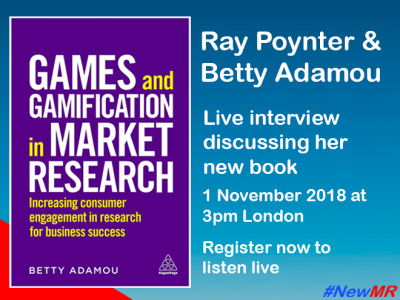
Ray Poynter interviews Betty Adamou

Data - the new little black dress in fashion

Bob Lederer interviews Betty Adamou

On retaining Millennials through Game Thinking

Contribution of paper to Online Market Intelligence in Russia 4.0
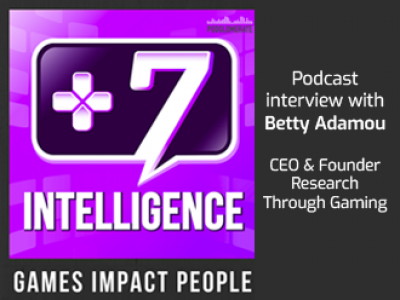
Betty Adamou interviewed by the +7 Intelligence podcast
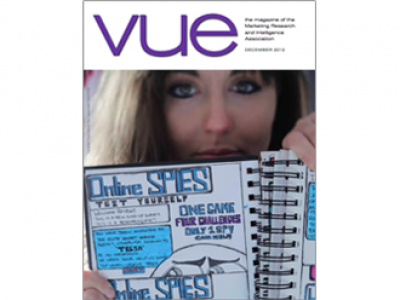
Featured article in VUE magazine

Betty Adamou on BOSS Academy Radio

Portafolio interviews Betty Adamou

Featured article in AEDEMO magazine

Article in Analog, the game dev fanzine
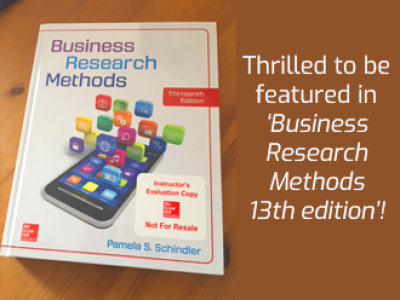
Betty's work cited in the Business Research Methods book, 13th edition
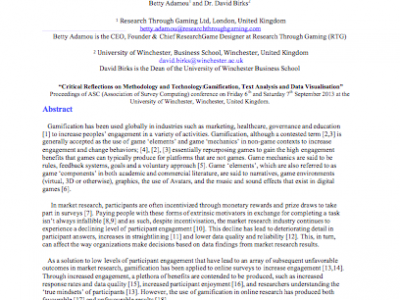
ResearchGames as a Methodology - conference paper
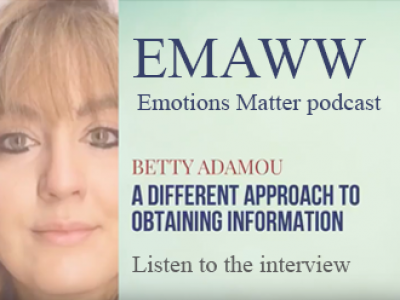
About the book
Why don’t research participants take part in surveys as much as we want them to, even when they’re given, sometimes lucrative, incentives? Because they’re unengaged, and games, by contrast, are the most engaging medium of all time.
Games harness storytelling and heuristics, drive emotion and push the evolution of technology in a way that no other platform has. It’s no surprise, then, that games and gamification are revolutionizing the market research industry, offering opportunities to reinvigorate the notoriously sluggish engagement levels seen in traditional surveying methods. This not only improves data quality, but offers untapped insights unattainable through traditional methods. Games and Gamification in Market Research shows readers how to design ResearchGames and Gamified Surveys that will intrinsically engage participants and how best to use these methodologies to become, and stay, commercially competitive.
In a world where brands and organizations are increasingly interested in the feelings and contexts that drive consumer choices, Games and Gamification in Market Research gives readers the skills to use the components in games to encourage play and observe consumer behaviours via simulations for predictive modelling. Written by Betty Adamou , the UK’s leading research game designer and named as one of seven women shaping the future of market research, it explains the ways in which these methodologies will evolve with technologies such as virtual reality and artificial intelligence, and how it will shape research careers. This book provides a fully immersive and fascinating overview of game-based research.
About the author
Betty Adamou has been named a revolutionary, pioneer, innovator and one of seven women shaping the future of market research. Having invented a new methodology of research and new genre of games through ResearchGames, Betty is frequently invited to share her work and enthusiasm as keynote addresses and lectures with her industry peers and students to re-ignite their passion for surveys, opinion-polling and other forms of research.
In her first and anticipated book, Adamou reveals the secrets of Games and Gamification applied to market research and why you need to join the change.
You can find Betty on Twitter: @BettyAdamou
More reviews of Games and Gamification in Market Research
“An interesting, informative read without the bulk. Betty is a master of her craft and this book is a gift to all who venture into the realm of games and gamification for market research.
Betty takes a step back to help you focus on the psychology behind why these methods will help you succeed. A must-read for all people interested in the space.”
– Laura Fagan, CEO & Founder, The Pain Journal
“Betty is the absolute expert when it comes to games and gamification in market research. Her book is steeped in practical advice and is written in such an engaging way that you won’t be able to help yourself in sharing her knowledge with others. Don’t expect a dry manual. This is an engaging read with lots of activities to get involved.”
– Fiona Blades, President and Chief Experience Officer, MESH Experience
“Market Research is going through a state of disruption on many fronts. We have big problems to solve including respondent engagement, data quality and client belief in the powers of great consumer insight. Game-based research provides many of the answers to these problems and in this book Betty demonstrates how we can all benefit from more gamification.”
– Stephen Phillips, CEO, ZappiStore
“Gamification has become one of research’s verifiably worthwhile new tools to improve surveys in a variety of ways, benefitting the respondent, research agency and client. Who knows more about this particular subject than Betty Adamou? There’s no so-called expert out there that I respect as much on the subject than Betty, which is why I can’t wait to get my copy of Games and Gamification in Market Research .”
– Bob Lederer, Editor, Publisher & Producer, RFL Communications
Order your copy today
Hey, you there want to unlock the secret stuff for readers page use the code noted in chapters 8 and 11. don’t tell anyone..

- Pollfish School
- Market Research
- Survey Guides
- Get started
Gamifying Market Research with Survey Gamification
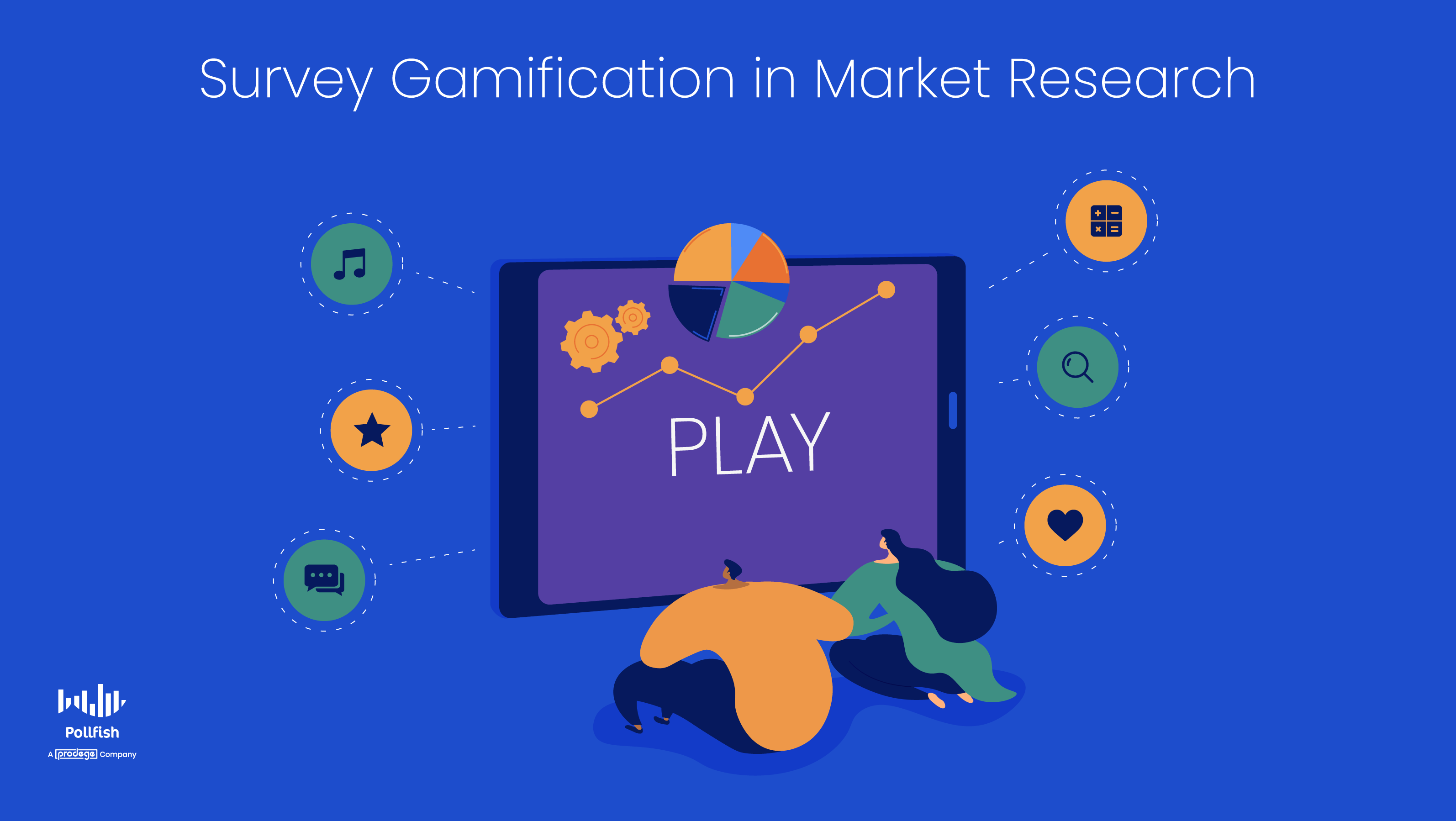
Survey gamification is one of the most effective ways to enhance the survey experience and increase your survey completion rate — and for good reason, as gamification is a hot topic, with a global market projected to grow from $9.1 billion in 2020 to $30.7 billion by 2025 .
Gamification is being applied across a wide range of industries, from education, to HR, to retail and banking. In fact, a Texas bank raised customer acquisition by 700% via gamification . The clothing company Moosejaw implemented a gamified system, which increased sales by 76%.
Given the unmistakable advantages of gamification and the shift from traditional market research to online mobile surveys , it is inevitable that gamification will become coupled with survey research. Many businesses are already adopting this hybrid approach , as should yours to stay competitive.
This article examines survey gamification, including its key examples, utilities, importance and how to establish it in your surveys to augment your market research techniques .
Understanding Survey Gamification
Survey gamification takes the premise of gamification and implements it for market research purposes , in turn creating what is apt to call a gamification survey.
First, it’s key to understand the precise meaning behind gamification before applying it to surveys . Gamification refers to the integration of game mechanics into non-game contexts , such as websites, online communities, SaaS products such as learning management systems, other systems, activities and services.
The aim of gamification is to forge similar experiences to those of playing games in non-leisure environments to motivate and engage users . In today’s competitive business world, it didn’t take long for gamification to make its way into the business sphere .
Gamification can be applied to various business practices to engage customers, employees, partners and various other stakeholders. When it comes to market research, r esearchers can apply this practice and create a gamification survey .
Survey gamification is the practice of using gaming elements and techniques in surveys. This method enhances the survey experience, fostering participation and engagem ent, which supports respondents completing a survey, as there is no element of boredom.
The goal of survey gamification is to create surveys that are more interactive, engaging, and enjoyable during participation. This enables them to better engage with consumers, employees, partners and all other survey participants.
Examples of Survey Gamification
There are several ways to gamify a survey; this can mean only using a few game elements, or even only one. The following lists some examples of prominent elements and techniques to use for a gamification survey:
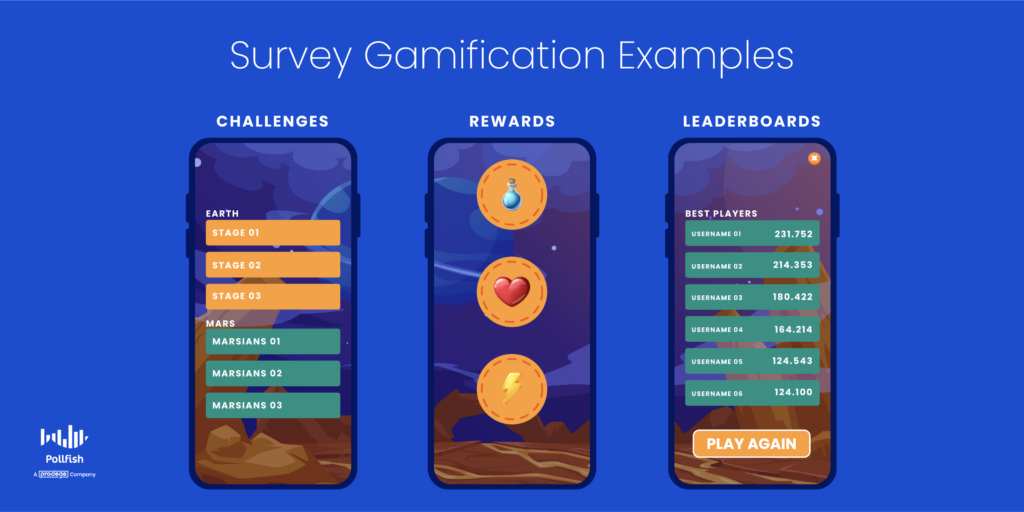
- This provides an element of personalization as respondents can see their names and the display of their performance levels.
- This also provides the game element of competition , as respondents will be motivated to score higher, which can have different applications in different surveys.
- This will motivate the respondents to finish their survey, provide quality feedback and do whatever else you demand, as they’ll want to score higher to earn a reward.
- Rewards are also known as survey incentives . They can be monetary or non-monetary.
- The reward should correlate with the time and effort that respondents invested.
- High-tier and pricey rewards should be in surveys that mention your brand, as this is key for brand awareness . This tactic will remind respondents of your business and establish a positive brand experience .
- This is a kind of reward itself that shows respondents’ level of achievement .
- This can be applied in-survey, or if you use an online survey platform that partners with a mobile game, this badge can be rewarded through the game itself.
- The respondents should receive a badge, at the end of the survey.
- Or, they should receive some points or anything that can then be conveyed through a ranking system .
- This shows respondents how close they are to completing their survey .
- This is far more interesting than a plain survey that gives no visual or other kinds of indication of how far respondents are in the survey.
- This also provides a higher level of transparency , which will motivate respondents to finish the survey, as they won’t be left wondering how much longer they have to go.
- Here, you can allow respondents to create their own avatars for answering your questions.
- Allow your respondents to save these as unique images they can use elsewhere.
- Additionally, the answers to questions themselves can be avatars . This way, rather than expressing themselves in words, your respondents can choose an avatar that reflects their answer.
- Through this element, you’ll have your answers while the respondents get a pleasant survey experience.
- This can be cryptocurrency or survey currency unique to your brand.
- For example, you can provide “currency” that virtually acts as a gift card to your company.
- You can also provide currency to a desktop or in-app game, should the online survey platform you use to deploy your survey to gaming sites and apps.
- Include visual and other gaming challenges in your survey, such as solving a puzzle.
- Aside from being engaging, this will show you if your respondents are paying attention.
- You can get creative here, the more interesting you make your challenges, the better it is for your brand visibility.
The Importance of Survey Gamification
The days of dull surveys that left respondents feeling as though they’ve completed a chore are in the past . With survey gamification, your surveys will keep your users engaged throughout the survey.
With this key benefit in mind, you should also understand that a gamification survey has far more importance than merely offering the element of fun into a survey.
Due to gamification, the respondents are more motivated to complete the survey. As such, they are more likely to provide quality answers . This is a major benefit for market researchers, as it results in higher quality data for analysis .
Survey gamification also draws more interest in partaking in a survey to begin with , which increases your survey response rates . In addition, aside from partaking in the survey, survey gamification cuts back on boredom and maintains higher levels of engagement , which in turn, increases the survey completion rate.
When respondents are deeply engaged, they won’t feel bored or discouraged from finishing their survey . As such, a gamification survey plays a major role in reducing survey attrition .
The gamification of surveys is also important, in that games gratify the basic human need of self-fulfillment . Their motivational factor occurs owing to this need. Games also generate the effect of being fully immersed and involved in an activity .
Gamified surveys also feed into the respondents’ sense of developmental growth and accomplishment, which adds to their user experience.
These are the key aspects that all UX designers, app developers and other digital makers seek to create, in order to keep users on their digital properties.
Integrating game mechanics into business processes, marketing campaigns, websites, applications, online communities, or school classes and college courses have proven to be an effective and fun way of encouraging the participation of target audiences.
Aside from influencing and motivating the behavior of your respondents, which is often your target market , if you’re a business, gamified surveys also yield a strong positive effect on your employees. There will be many instances in which you’ll need to gather employee feedback .
Most of the time, these surveys are anonymized, which will deter your employees from answering them. A gamification survey will avoid this lack of interest and motivation in taking a survey and instead make employees more inclined to take it .
If your survey is not anonymized, employees will still enjoy the process of answering the survey more than they would with a traditional survey.
Finally, survey gamification increases consumer loyalty and brand awareness if you explicitly mention your brand in the survey. When respondents are kept interested in the survey through a positive app or survey experience, it improves brand acceptance in general. This is because they’ll associate their positive experience with your brand.
How to Gamify a Survey
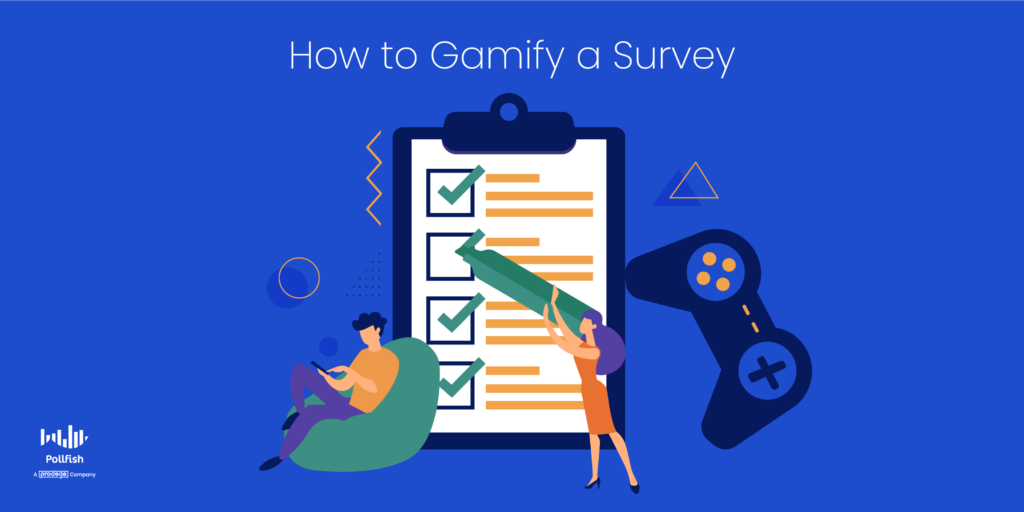
You can gamify your survey with the examples from a previous section. But aside from those examples, there is more to gamifying a survey. The steps below offer a guide on how to go about gamifying your survey in various ways, along with some examples.
- These tend to be more specific, so that respondents answer with visuals.
- For example, change “What type of sneakers do you like?” to “which sneakers would you buy if you could buy all your favorites?”
- Place a progress bar at the top of the survey, so the respondent clearly sees their progress and how close they are to completion.
- See the customer satisfaction survey question guide for specific types of numerical and visual rating surveys and question examples.
- This allows respondents to access or “jump” directly to a particular page, question or item in your survey based on their response to a previous question.
- The online survey platform you use will need to offer advanced skip logic to add this feature.
- Only through scoring will you be able to add a leaderboard (see the section on examples) and reward respondents .
- Use social sharing to increase respondents’ competitiveness and gain new respondents, as social sharing can lure in new ones.
- Give a reward early on to keep them motivated to complete their survey.
Making Strides in All Survey Research
Survey gamification makes gathering accurate consumer data or the data of any audience far more engaging and enjoyable for the respondents and easier for the researchers . As such, businesses are supplied with high-quality insights.
The progress in innovation and convenience in the digital, mobile and market research spheres will lead to more advanced iterations of the gamification of surveys .
To offer the most effective survey gamification, you must first use a strong online survey tool, as this platform will dictate how your surveys will be gamified. Ideally, you would want to have the leeway to include all of the aforementioned survey gamification elements and techniques in your survey.
To do so, you should use an online survey platform that operates on random device engagement (RDE) sampling, which allows you to reach respondents in their natural digital environments , reducing all kinds of survey bias in turn.
You should also opt for an online survey platform that operates via artificial intelligence and machine learning , which disqualifies survey fraud and poor-quality data , along with providing a mobile-first approach design.
An online survey tool with these functionalities will enable you to establish high-quality survey gamification that will allure and retain your survey respondents , resulting in high levels of participation, low attrition and speed to insights.
Do you want to distribute your survey? Pollfish offers you access to millions of targeted consumers to get survey responses from $0.95 per complete. Launch your survey today.
Privacy Preference Center
Privacy preferences.
- Market Research
How to write effective market research questions
- October 31, 2022

Every business owner wants to get into the head of their audience, as it makes a business successful. That is why primary data is valuable, and every blog you read suggests asking the right market research questions.
The right questions will give you a way into the psyche of your customers, driving your business in the right direction, but how do you create the perfect market research questionnaire?
In this article, we will share some interesting tips and examples of market research questions that would help you speed up your market research process.
Types of market research questions.
Market research is a tricky game for someone who is just beginning. There are many moving pieces and cogs to handle, which can sometimes get overwhelming.
While it is crucial for decision-making and should be prioritized, many people make the mistake of rushing the process. They forget that if they do not create a contextual market research questionnaire, it can make the insights inconclusive or confusing.
A market research survey should have questions based on your market research goal. This will help you get qualitative insights from your audience. Here are the types of questions you can ask your audience:
Multiple choice questions
You must have tackled MCQ quizzes in your high school or college. When doing market research, these questions are useful when you need to cast a wide net and understand the different opinions (or options) a respondent has. For example, the types of credit cards they hold and use frequently.

Single choice questions
Single-choice (or radio button) questions give users only one choice to select from a given list. These questions are suitable when you want to:
- Segment your customers.
- Discover critical pain points.
- Qualify your respondents for the following survey segments.
You can also use these questions for product development or customer satisfaction surveys. For example, asking users which features they hate or like to see in future updates.
Matrix grid questions
A matrix question grid is usually seen in customer satisfaction surveys but can be used in market research questionnaires to shorten the surveys.
Here’s an example of a matrix question:
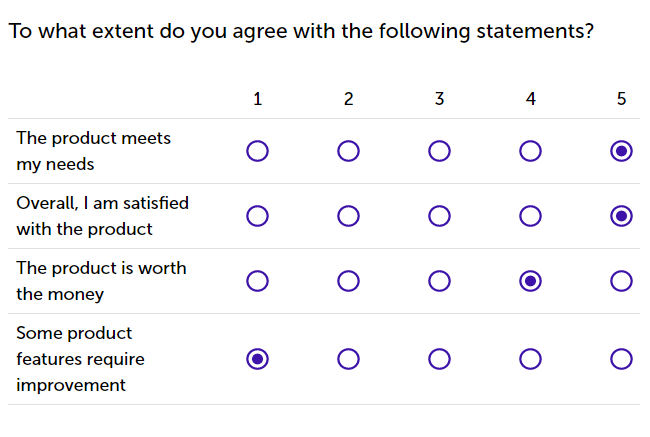
Ranking questions
Ranking questions ask the respondents to prioritize their opinions or choices in order of preference; for example, what is the most important criterion for you while booking a room in a hotel?
- Location
- Amenities
- Customer Ratings
Customers can rank their preferences by moving the options up and down. These questions help understand a respondent’s preferences and choices, which can be crucial for marketing campaign planning, copywriting, and creative decision-making.
Open-ended questions
Open-ended questions are straightaway questions that ask respondents to write out their answers directly. These are free text responses that one can share to explain the reasons for their last response or freely share opinions.
Such answers do not have a definitive structure and can be hard to analyze at scale. Many modern market research tools use sentiment analysis features to categorize open-ended responses.
For example, GapScout can help you unearth trends and the general sentiments from online customer reviews.
Market research questions for segmenting your audience.
Segmentation divides your target audience into categories to personalize marketing campaigns, improve the value proposition, or delight users with contextual information or offers.
Market research with segmentation as an objective should have questions that give you granular-level insights about your audience, their preferences, and their character traits.
Ideally, segmentation questions should aim to gather insights about demographics, psychographics, or behavioral characteristics.

Before writing market research questions for segmenting audiences, you should find answers to questions like:
- What locations are the most popular among customers?
- What are our existing customers’ interests, preferences, fears, and aspirations?
- Do we have existing data on the demographics of our ideal target audience?
- Have we segmented our customers before? If yes, how is the current situation different from before?
- Are we expecting to prove any hypothesis regarding customer expectations, pain points, or aspirations?
- How do our customers find out about us?
Once you write out the answers to the above questions, you will have ample ideas on how to structure your market research survey. If you are still clueless, here are a few questions to help you get inspired.
Segmentation market research question examples:
- Are you open to trying new experiences, or love sticking to your regular brands?
- What is your hobby? What do you enjoy in your leisure time?
- What kind of food do you like?
- Where do you research before going for a big-ticket purchase?
- How much money do you usually spend on x (product)?
- What is your primary source of information?
- Are you married? If yes, how many children do you have?
- Where do you shop for your monthly groceries?
Market research questions for product development.
A lot of data goes into developing a new product. So, conducting market research for product development is essential, as it gives you enough information about what your customer wants to see in a new product. It also helps you understand the perception of your product over competitors and will also help you prioritize your product roadmap.
When planning to conduct market research for product development, ask yourself:
- What products are currently available in the market?
- Are the users dissatisfied with existing offerings?
- How does your product compare to other products available in the market?
- What are the pain points no one is solving for customers?
- Do you have the resources to build a customer-centric roadmap and deliver a unique product?
- What value proposition can you offer?
- How to gather customer feedback from the existing users (of competitors)?
You can use GapScout to conduct market research from existing product reviews of competitors to get deep insights into what users want. These insights will help you identify the opportunity gaps in the market that you can confirm by asking on-point questions in your market research questionnaire.
Product development market research question examples:
- Which features are most valuable to you when you use xxx (product)?
- What challenges do you face with XXXX ( your industry, for example, organic skincare brands)?
- What do you wish XXXX (product/service) had that it currently does not?
- What tools do you use at your job or in your daily life?
- What brand/company do you turn to when you have xxxx problem (your pain point)?
- How often do you use a product/service during the day/week/month?
Market research questions for pricing strategy.
An on-point pricing strategy is one of the most critical elements for the success of your business because this will drive revenues. Pricing market research to understand consumers’ interest in paying for something will ensure long-term success.
Accurate pricing market research can help you stay profitable, attract more users, and keep growing through various business cycles. Before starting market research, ask yourself:
- Have your existing customers ever complained about your price?
- How do the competitors charge for their products, and what features do they offer?
- How is the perception of your current pricing plans in the eyes of customers compared to competitors?
- Do your products offer value for money for customers?
- How will restructuring the price affect the revenue or profit margins?
- Is there any room for cross-selling or upselling among the existing customer group?
- Can we offer a free tier, plan or demo to attract more customers?
The answers to the above questions will give your market research a clear direction about what to ask. For example, suppose you know your customers charge less than you and your customers feel cheated because of this. In that case, you can create a direct question about how disappointed they are and then take corrective actions to delight future users.
Pricing market research question examples:
- Would you purchase the product at xxx price?
- What do you think about the cost of xxx (category or product) in the market? Is it costly, cheap, or justifies its worth?
- What sort of customer service would you expect in return
- if you have to pay for a service or product every month?
- Are you confused about the pricing of xxx (competing product)?
Market research questions for branding & marketing
Whether you are branding for a small business , startup, or enterprise, you will need detailed inputs and information about your target audience. Market research for branding and advertising helps you analyze the effectiveness of your current campaigns and provides inputs for future marketing strategies.
A standard market research questionnaire would help you generate ideas, gather inspiration, and optimize your overall marketing/branding strategy. Here’s what you should keep in mind when you are planning market research for branding or marketing:
- What are our best-performing advertising and marketing channels currently?
- Do we have a brand recall or desired visibility?
- Do we achieve the desired ROI? If not, what is stopping us from attaining efficiency or effectiveness?
- Do our customers associate the brand with the value proposition we offer?
- Are our positioning and communication precise enough for customers to understand how we address their fear and apprehensions?
- Are our competitors performing better in terms of marketing? If yes, what channels are they most active on?
- Are we running A/B tests or conducting conversion optimization for our existing marketing efforts?
Branding & marketing research question examples:
- What is the first thing that comes to mind when you hear the word ‘xxx’ (your brand name)?
- Where did you first hear about XXXX (your brand name)?
- If XXXX (name of your brand) was a person, how would you describe them?
- Will you pick xxx (the product) from an online store or an offline retailer?
- Look at the video clip. What do you think right after you finish seeing the video? (for perception analysis of a new video campaign)
- When you see it online, will you click on Banner A or Banner B? (linked with banner options)
Best practices for writing market research questions.
- Create multiple-choice questions with mutually exclusive options: Do not create overlapping options for MCQs. For example, if you are asking about the age, make sure to have exclusive options such as 10-17, 18-24, 25-34 and so on. This will make sure your data is not skewed.
- Calculate the required sample size beforehand: You should know how many respondents you need to gather conclusive findings. The best way is to use an online sample size calculator that helps you account for the margin of error and confidence level of respondents. This way, you will have desired data without wastage of resources.
- Keep questions straightforward: Every question should be written with the intention of gathering one clear insight. There should not be more than one question about the same issue. This will make your life easier and improve the quality of the data you gather. At the same time, do not add double-barreled questions to the survey that confuse a respondent.
Save time with GapScout.
Conducting a compelling and conclusive market research survey is time-consuming and costly — something not every entrepreneur can afford, especially at the early stages. Even with the most accurate questions to gather insights, human errors can lead to inconclusive results.
A better way to conduct market research for your business is to use online customer reviews to gather insights. GapScout helps you scan real customer reviews in your industry and provide deep insights on customer pain points, expectations, need gaps, and opportunities in the market.
Use GapScout to save time gathering insights and start optimizing your business plan and operations within hours.
Also Read:
- Market Research vs Marketing Research
- Market research process
- Market research for startups
Ready to Automate Your Market Research? Get exclusive access to GapScout prior to release!
Share this:
The best in market research.
Market research tips & tools sent to your inbox.
By clicking Subscribe, you agree to our Terms and Conditions.
Popular Articles

The ultimate guide to market research for business

How to measure the success of design thinking

Email us: [email protected] Made with ♥ in sunny California
- Legal Policies
Sign up for early access here!
ⓒ 2023 GapScout. All rights reserved.

Get Early Access!
Sign up to get early beta access to GapScout before it becomes publicly available!
We use cookies to give you the best possible experience on our website.
Extract insights from Customer & Employee Interviews. At Scale.
Market research questions to ask for actionable insights.
Home » Market research questions to ask for actionable insights
Insightful Market Queries serve as a pivotal element in driving successful market research. Businesses thrive when they ask the right questions that illuminate customer preferences, behaviors, and trends. By delving into these inquiries, companies can uncover valuable insights tailored to their unique needs. This understanding fosters better strategies, ensuring that decisions are data-driven and aligned with market demands.
Moreover, crafting these queries effectively is essential for gathering actionable insights. Open-ended questions can reveal underlying motivations, while specific queries help identify gaps in the market. Striking the right balance between exploration and focus empowers businesses to transform raw data into meaningful narratives that fuel growth and innovation. Emphasizing the significance of these inquiries can guide organizations towards more informed choices in a competitive marketplace.
Crafting Insightful Market Queries for Actionable Data
Crafting insightful market queries is essential for obtaining actionable data that informs strategic decisions. Start by defining clear objectives for your research. Focus on understanding your target audience, their needs, and how your product aligns with those needs. Utilize open-ended queries that encourage detailed responses, such as asking consumers what challenges they face with existing solutions. This approach will provide deeper insights.
Next, prioritize specificity in your questions. Instead of asking broad inquiries, use tailored questions that touch on particular aspects of user experience. This could include querying about product features or services they find important. Additionally, consider demographic and psychographic factors when forming your questions, as this helps refine your understanding of different customer segments. By asking the right questions, you can uncover meaningful insights that drive effective strategies for growth and customer satisfaction.
Understanding Customer Needs
Understanding customer needs is pivotal for any business aiming to thrive in a competitive marketplace. Insightful market queries help uncover what customers truly value and how they perceive your offerings. By focusing on these questions, businesses can better align their strategies with customer expectations, leading to improved satisfaction and engagement.
First, identifying customer pain points is crucial. Ask questions that reveal frustrations customers face in their buying journey. Additionally, explore their desires and preferences. What features do they prioritize? Understanding these elements allows you to tailor your products or services more effectively. Feedback on pricing strategies is equally important. Customers often have insights that can help adjust your pricing to meet market demands better. Lastly, examine the overall customer experience. Questions regarding ease of use and support can highlight areas needing improvement, ensuring you remain committed to customer satisfaction.
Analyzing Market Trends
Analyzing market trends involves a systematic approach to collecting and interpreting data relevant to consumer behavior and preferences. It is crucial to formulate insightful market queries that match your business objectives. Such questions can help uncover emerging patterns and shifts that influence purchasing decisions. By assessing how market dynamics shift over time, businesses can better anticipate customer needs and adjust their strategies accordingly.
To delve deeper, consider asking targeted questions within three key areas:
Consumer Characteristics : What demographics are showing interest in our products and services? Understanding your audience helps tailor offerings effectively.
Competitive Analysis : How are competitors adjusting their market strategies? Evaluating competitors provides insights into effective tactics and potential market gaps.
Market Conditions : What external factors are influencing buying behaviors? This can include economic trends, technological advances, or changes in consumer attitudes.
Incorporating these queries into market analysis can yield actionable insights that guide strategic decisions.
Implementing Insightful Market Queries in Surveys
Implementing insightful market queries in surveys is crucial for gathering meaningful data that translates into actionable insights. Designing surveys with well-crafted questions enables researchers to capture the nuances of consumer behaviors and preferences. This process begins with identifying key objectives, ensuring each question aligns with the desired outcomes. Engaging participants with clear and concise queries fosters thoughtful responses and promotes higher participation rates.
To effectively implement insightful market queries, consider several essential components: 1. Define Objectives – Clearly articulate what you aim to learn from the survey. 2. Craft Targeted Questions – Use open-ended questions to uncover deeper insights. 3. Ensure Clarity – Avoid jargon and complex language to maintain respondent engagement. 4. Pilot Test – Run a small trial to identify potential issues in question wording or survey flow. 5. Analyze Findings – Take time to evaluate the data thoroughly, translating insights into strategic recommendations. Adopting these strategies ensures that your surveys yield valuable information for informed decision-making.
Structuring Effective Survey Questions
Effective survey questions are pivotal for gathering insightful market queries that drive strategic decisions. To create impactful questions, first identify your objectives. Are you looking for feedback on a product, customer satisfaction, or market trends? Clear objectives will shape the questions, ensuring they target relevant information.
Next, consider the question format. Closed-ended questions, such as multiple choice or rating scales, provide quantitative data for easy analysis. In contrast, open-ended questions invite deeper insights and nuances. Ultimately, a balanced mix of both formats can yield a robust dataset. Additionally, wording matters; use simple, direct language to avoid confusion and ensure respondents understand what is being asked. Moreover, pilot testing your questions can help identify any ambiguities before launching your survey. By structuring effective survey questions thoughtfully, you position your research to uncover actionable insights that inform lasting business strategies.
Leveraging Technology for Better Insights
In today's fast-paced market environment, insightful market queries are crucial for understanding consumer behavior and preferences. By utilizing technology, businesses can efficiently gather and analyze data, leading to actionable insights that drive strategic decisions. Advanced tools can help streamline the data collection process, ensuring accuracy and reducing the time spent on manual analysis.
To maximize the benefits of technology in market research, consider focusing on the following aspects:
Automated Data Collection : Employ digital tools for survey distribution and data gathering, minimizing human error and time consumption.
Advanced Analytics : Leverage AI and machine learning to analyze large datasets and uncover trends that might otherwise go unnoticed.
Visualization Tools : Use graphic representations of data to make complex insights easily digestible, enabling better decision-making.
Collaboration Platforms : Implement systems that facilitate knowledge sharing among team members, ensuring all insights are centralized and easily accessible.
Focusing on these areas will empower organizations to generate more insightful market queries and swiftly convert data into powerful strategies.
Conclusion: Turning Insightful Market Queries into Strategic Actions
Transforming Insightful Market Queries into strategic actions is essential for effective decision-making. Start by framing your questions to address specific challenges or opportunities within your market. This clarity will allow you to glean meaningful insights and identify trends that directly impact your business strategy.
Once you have gathered data from these queries, analyze it diligently. Look for patterns that can inform product development, marketing tactics, or customer engagement strategies. By aligning these insights with your organizational goals, you can create actionable plans that not only address current needs but also anticipate future market shifts.
Turn interviews into actionable insights
On this Page
How to write market segmentation articles that attract readers
You may also like, product segmentation strategy: steps to optimize your offerings.
Role of CPG in marketing: Best practices
Questionnaire about consumer behavior: crafting effective questions.
Unlock Insights from Interviews 10x faster
- Request demo
- Get started for free
Articles on Olympic Games Paris 2024
Displaying all articles.

The Paralympics can be an economic boon for host cities – and leave a unique legacy
Kirsten Holmes , Curtin University and Leonie Lockstone-Binney , Griffith University

Kenya topped Africa’s Olympics medal table – but a new strategy will be needed to keep winning
Wycliffe W. Njororai Simiyu , Stephen F. Austin State University

Post Paris success, Olympics eye the future with new sporting formats to widen youth appeal
Andy Miah , University of Salford
Related Topics
- 2024 Paris Olympics
- African sports
- Keep me on trend
- Olympic games
- Track and field
Top contributors
Chair in Science Communication & Future Media, University of Salford
Professor and Chair of Kinesiology and Health Science, Stephen F. Austin State University
- X (Twitter)
- Unfollow topic Follow topic
India Outdoor Gears and Equipment Market By Type (Apparel, Footwear, Backpacks, Tents and Sleeping Bags, Climbing Equipment, Accessories); By Application (Game, Sport Activity); By Geography – Growth, Share, Opportunities & Competitive Analysis, 2024 – 2032
Price: $1699.
- Table Of Content
| Historical Period | 2019-2022 |
| Base Year | 2023 |
| Forecast Period | 2024-2032 |
| India Outdoor Gears and Equipment Market Size 2023 | USD 978.45 Million |
| India Outdoor Gears and Equipment Market, CAGR | 8.00% |
| India Outdoor Gears and Equipment Market Size 2032 | USD 1,955.93 Million |
Market Overview
The India Outdoor Gears and Equipment Market is projected to grow from USD 978.45 million in 2023 to USD 1,955.93 million by 2032, reflecting a compound annual growth rate (CAGR) of 8.00%.
The India Outdoor Gears and Equipment Market is driven by the rising popularity of outdoor activities such as trekking, camping, and adventure sports, fueled by increased health consciousness and a growing preference for active lifestyles. The market is further supported by a rising disposable income, allowing consumers to spend more on leisure and recreational activities. Additionally, advancements in product innovation and the availability of a wide range of high-quality, durable gear are attracting more consumers. The growing influence of social media and digital marketing also plays a crucial role in driving awareness and demand for outdoor gears and equipment.
The India Outdoor Gears and Equipment Market is predominantly concentrated in urban areas, with major demand coming from cities such as Delhi, Mumbai, and Bangalore, where the urban population has higher disposable income and a growing interest in outdoor activities. The market is expanding into smaller cities and towns, driven by increased awareness and accessibility. Key players in the market include Wildcraft India Pvt. Ltd., Decathlon S.A., The North Face (VF Corporation), Coleman Company, Inc., and Adventure Worx. These companies are leveraging their strong brand presence, extensive product portfolios, and strategic marketing to capture a larger share of the growing market.

Access crucial information at unmatched prices!
Request your free sample report today & start making informed decisions powered by Credence Research!
Download Free Sample

Market Drivers
Rising Disposable Income, Urbanization, and Interest in Adventure Sports
The increasing disposable income among Indian consumers is a key driver for the outdoor gears and equipment market, as more people can now afford to invest in high-quality outdoor products. For instance, India’s per capita disposable income is projected to reach ₹2.14 lakh in 2023-24. This rise in spending power is complemented by the growing urbanization in India, where many city dwellers seek to escape the hustle and bustle of urban life by engaging in outdoor activities. These activities offer a way to reconnect with nature and provide a much-needed respite from the fast-paced city environment. The interest in adventure sports and trekking is also on the rise, with India’s diverse landscapes and rich cultural heritage making it a popular destination for adventure tourism. Younger generations, in particular, are increasingly drawn to activities like trekking and hiking, which are not only enjoyable but also provide a sense of adventure and exploration.
Government Initiatives, Infrastructure Development, and Product Innovation
Government initiatives and infrastructure development play a crucial role in supporting the growth of the outdoor gears and equipment market. India’s extensive network of national parks and wildlife sanctuaries attracts a large number of outdoor enthusiasts, and improvements in infrastructure, such as roads and trails, enhance accessibility to these outdoor destinations. For example, the Indian government has taken several initiatives such as Khelo India, TOPS Scheme, etc to build India as a sporting nation. This increased accessibility encourages more people to explore outdoor activities. Additionally, product innovation and customization are key trends in the market. Manufacturers are developing lightweight and durable equipment to meet the needs of modern adventurers, ensuring that their products are both practical and efficient. Customized options, such as specific hiking boots or camping tents tailored to individual preferences, cater to the diverse needs of outdoor enthusiasts.
Health and Wellness Consciousness and Social Media Influence
The growing consciousness about health and wellness is another significant factor driving the demand for outdoor gears and equipment. People are increasingly recognizing the benefits of outdoor activities for both physical and mental health, leading to a surge in participation in activities such as hiking, camping, and cycling. These fitness trends require appropriate gear and equipment, which has led to an increased market demand. Social media platforms further amplify this trend by popularizing outdoor activities and adventure travel. Influencers who share their outdoor experiences inspire others to participate, creating a ripple effect that drives market growth. The visual appeal of stunning images and videos of outdoor adventures motivates people to seek similar experiences, further boosting the demand for outdoor gear and equipment.
E-commerce Growth and Accessibility
The growth of e-commerce has significantly impacted the outdoor gears and equipment market by providing consumers with convenient access to a wide range of products. Online shopping platforms make it easy for consumers to explore various options, compare prices, and read reviews, all from the comfort of their homes. This convenience is particularly appealing to younger consumers who are tech-savvy and prefer online shopping. E-commerce also often offers competitive pricing, making outdoor gear and equipment more affordable. The ability to access a wide variety of products and make informed purchasing decisions online has contributed to the market’s expansion, as more consumers are drawn to the ease and efficiency of online shopping for their outdoor needs.
Market Trends
Shift Towards Lightweight, Sustainable, and Multi-functional Gear
The outdoor gears and equipment market is witnessing a significant shift towards lightweight and sustainable gear, driven by a minimalist approach among consumers who prioritize reducing carrying weight and minimizing their environmental footprint. For instance, brands are increasingly focusing on using sustainable materials such as recycled fabrics and biodegradable components. Brands are increasingly focusing on using sustainable materials, such as recycled fabrics and biodegradable components, to meet the growing demand for eco-friendly products. This trend aligns with the broader global movement towards sustainability, reflecting consumers’ increasing awareness and concern for the environment. In parallel, there is a rising demand for multi-functional gear that caters to various outdoor activities like hiking, camping, and trekking. Consumers are looking for versatile equipment that can adapt to different scenarios, making their outdoor experiences more seamless and convenient. Modular designs are becoming popular, allowing users to customize and adapt their gear according to specific needs, enhancing both functionality and user experience. This focus on multi-functionality and sustainability is driving innovation and product development in the outdoor gear market.
Increasing Demand for Women-Specific Gear and Technological Integration
The market is also responding to the increasing demand for women-specific gear, recognizing the need for equipment designed to accommodate the unique needs of female outdoor enthusiasts. Brands are focusing on creating gear with gender-specific fits that consider differences in body shape and size, providing better comfort and performance for women. Women-focused marketing campaigns are also gaining traction, attracting more female consumers to outdoor activities and expanding the market base. Alongside these developments, the integration of technology into outdoor gear is becoming more prevalent. Smart gear, such as GPS tracking devices and wearable technology, is enhancing safety, convenience, and the overall outdoor experience. These technological advancements provide users with real-time data and connectivity, improving navigation, health monitoring, and emergency responses during outdoor adventures. The incorporation of smart features in outdoor gear is catering to tech-savvy consumers who value both innovation and practicality, further driving market growth.
Market Challenges Analysis
Limited Awareness, Adoption, and Infrastructure Constraints
The India Outdoor Gears and Equipment Market faces significant challenges due to limited awareness and adoption, particularly in rural areas and smaller cities. For instance, a study by MIT found that rural areas in India face a severe technological deficit, which can extend to outdoor gear and equipment. This lack of exposure and adoption is further compounded by cultural norms and beliefs that may not align with outdoor activities. Additionally, despite the growing urban population, India’s infrastructure development needs are estimated to cross $840 billion over the next 15 years, indicating a significant infrastructure constraint. Many individuals in these regions have limited exposure to outdoor activities and the associated gear, which restricts market penetration. Traditional cultural norms and beliefs can also act as barriers, as outdoor activities may not align with local customs or be viewed as necessary or desirable pursuits. This cultural context hampers the growth of outdoor recreation and, consequently, the demand for related equipment. Additionally, infrastructure constraints pose a considerable challenge. In some regions, there is a lack of well-maintained trails, camping sites, and other essential outdoor infrastructure, which are critical for promoting safe and enjoyable outdoor experiences. Safety concerns related to wildlife, natural hazards, and the lack of emergency services further discourage participation in outdoor activities, limiting the potential market for outdoor gear.
Price Sensitivity, Seasonal Demand, and Competitive Landscape
Price sensitivity is another critical challenge in the India Outdoor Gears and Equipment Market. High-quality and premium outdoor gear can be costly, making it unaffordable for a significant portion of the population. Consumers often seek value-for-money options, leading to pressure on pricing and profitability for manufacturers and retailers. Seasonal demand exacerbates these pricing challenges, with peak periods typically occurring during cooler months. Managing inventory during off-peak seasons becomes a complex task, requiring businesses to balance stock levels and minimize carrying costs. The competitive landscape is also marked by the presence of both organized and unorganized players, contributing to market fragmentation. This unorganized market segment, often characterized by lower-priced, lower-quality products, creates intense price competition, eroding profit margins for established brands. The prevalence of counterfeit products further complicates the competitive landscape, as imitation gear undermines the quality and safety standards of outdoor equipment. Counterfeit products not only pose risks to consumer safety but also damage the reputation of genuine brands, making it harder for consumers to trust and invest in high-quality outdoor gear.
Market Segmentation Analysis:
The India Outdoor Gears and Equipment Market is categorized into several key product types, including Apparel, Footwear, Backpacks, Tents and Sleeping Bags, Climbing Equipment, and Accessories. Apparel holds a significant share, driven by the demand for durable, weather-resistant clothing designed for outdoor activities such as hiking, trekking, and camping. Footwear is another critical segment, with consumers seeking specialized shoes and boots that offer support, protection, and comfort for various terrains. Backpacks are essential for carrying gear, making them a staple for outdoor enthusiasts who require versatile, durable, and ergonomic solutions. Tents and Sleeping Bags cater to camping needs, with a focus on lightweight, easy-to-carry, and weather-proof designs. Climbing Equipment is gaining traction as adventure sports become more popular, requiring reliable and safe gear. Accessories, which include items such as water bottles, gloves, and navigation tools, also play a vital role in enhancing the outdoor experience, contributing to the market’s growth.
By Application:
Based on application, the India Outdoor Gears and Equipment Market can be segmented into various uses, including activities categorized under Game. This segment encompasses outdoor sports and adventure activities like hunting, fishing, and wildlife exploration, which require specialized gear to ensure safety, performance, and convenience. The growing interest in these activities is fueled by India’s diverse natural landscapes, from mountains to forests, offering ample opportunities for game-related activities. Equipment tailored to these pursuits includes camouflage clothing, specialized footwear, durable backpacks, and specific accessories that cater to the unique needs of game enthusiasts. The rising popularity of these activities is driving demand for high-quality, reliable gear that enhances safety and effectiveness. As more individuals engage in game-related activities, this segment is expected to see continuous growth, supported by innovations in product design and functionality tailored to meet the specific requirements of game enthusiasts.
Based on Type:
- Tents and Sleeping Bags
- Climbing Equipment
- Accessories
Based on Application:
- Sport Activity
Based on the Geography:
Regional Analysis
Northern region
The Northern region of India dominates the outdoor gears and equipment market, holding a significant market share of approximately 35%. This region’s prominence is largely attributed to its diverse topography, including the Himalayan mountain range, which attracts a large number of trekkers, climbers, and adventure enthusiasts. States like Uttarakhand, Himachal Pradesh, and Jammu & Kashmir serve as major hubs for outdoor activities, driving the demand for high-quality gear and equipment. The region’s market is characterized by a mix of international brands and local manufacturers catering to various price segments. The growing popularity of adventure tourism in the North has led to increased investment in outdoor infrastructure and facilities, further boosting the demand for specialized equipment. Additionally, the rising trend of fitness-oriented lifestyles among urban dwellers in major cities like Delhi and Chandigarh has contributed to the growth of the outdoor gear market, particularly in categories such as hiking shoes, backpacks, and camping gear.
Western region
The Western region of India holds the second-largest share in the outdoor gears and equipment market, accounting for roughly 28% of the total market value. This region’s significant market presence is driven by states like Maharashtra, Gujarat, and Goa, which offer a diverse range of outdoor activities from trekking in the Western Ghats to water sports along the coastal areas. The region benefits from a strong urban population with higher disposable incomes and an increasing inclination towards outdoor recreational activities. Cities like Mumbai and Pune serve as key markets, with a growing number of outdoor enthusiasts and adventure clubs driving the demand for specialized gear. The Western region’s market is also characterized by a strong e-commerce presence, with many consumers preferring to purchase outdoor equipment online. This has led to the emergence of several online-only brands and retailers specializing in outdoor gear. Furthermore, the region has witnessed a surge in eco-tourism initiatives, promoting sustainable outdoor activities and creating a niche market for eco-friendly outdoor equipment.
Key Player Analysis
- Wildcraft India Pvt. Ltd.
- Decathlon S.A.
- Coleman Company, Inc.
- Quechua (Decathlon S.A.)
- Adventure Worx
- The North Face (VF Corporation)
- Kathmandu Holdings Limited
- Snow Peak Inc.
Competitive Analysis
The India Outdoor Gears and Equipment Market is highly competitive, with leading players such as Wildcraft India Pvt. Ltd., Decathlon S.A., The North Face (VF Corporation), Coleman Company, Inc., and Adventure Worx dominating the market. These companies benefit from strong brand recognition and extensive distribution networks, allowing them to reach a broad consumer base. Wildcraft India Pvt. Ltd. and Decathlon S.A. have established a significant market presence by offering a wide range of affordable, high-quality products tailored to Indian consumers. The North Face and Coleman Company focus on premium products that appeal to serious outdoor enthusiasts, leveraging their global reputation for quality and innovation. Adventure Worx differentiates itself by catering to niche markets with specialized gear for trekking and adventure sports. These leading players continually invest in product innovation, marketing strategies, and expanding their retail footprint to maintain their competitive edge in the growing India Outdoor Gears and Equipment Market.
Recent Developments
- In May 2024, Wildcraft invested Rs 80 crore to open a warehouse at Sira, Karnataka, spreading across a 3.5 lakh sq.ft area.
- In June 2024, VF Corporation named Caroline Brown as the global brand president of The North Face.
- In 2024, Vango introduced a range of new tents that are suitable for families, small groups, and individuals, along with new self-inflating mattresses.
- In 2024, Snow Peak kicked off its Snow Peak Way Series at its new Campfield on Washington’s Pacific Coast.
- In April 2024, K.K.BCJ-80 commenced a tender offer to acquire the common shares of Snow Peak Inc.
Market Concentration & Characteristics
The India Outdoor Gears and Equipment Market exhibits moderate market concentration, with both established international brands and local companies competing for market share. Leading brands such as Decathlon S.A., Wildcraft India Pvt. Ltd., and The North Face (VF Corporation) dominate due to their strong brand recognition, extensive product portfolios, and widespread retail presence. These companies are known for their quality, durability, and innovative product offerings, which appeal to a wide range of outdoor enthusiasts. The market is characterized by a mix of organized and unorganized players, with the latter often offering lower-cost alternatives that cater to price-sensitive consumers. The competitive landscape is further shaped by a growing focus on e-commerce, which allows both large and small players to reach a broader audience. The market’s dynamic nature, driven by rising disposable incomes, increasing interest in adventure activities, and the influence of social media, continues to attract new entrants, making it a vibrant and competitive space.
Shape Your Report to Specific Countries or Regions & Enjoy 30% Off!
Report coverage.
The research report offers an in-depth analysis based on Type, Application, and Geography . It details leading market players, providing an overview of their business, product offerings, investments, revenue streams, and key applications. Additionally, the report includes insights into the competitive environment, SWOT analysis, current market trends, as well as the primary drivers and constraints. Furthermore, it discusses various factors that have driven market expansion in recent years. The report also explores market dynamics, regulatory scenarios, and technological advancements that are shaping the industry. It assesses the impact of external factors and global economic changes on market growth. Lastly, it provides strategic recommendations for new entrants and established companies to navigate the complexities of the market.
Future Outlook
- The market is expected to grow steadily due to increasing interest in outdoor activities and adventure sports.
- Rising disposable incomes will drive consumer spending on high-quality outdoor gear and equipment.
- Urbanization will continue to expand the market, as city dwellers seek recreational activities outside the urban environment.
- The demand for lightweight and sustainable gear will increase, driven by consumer preferences for environmentally friendly products.
- Technological advancements will lead to the development of smart outdoor gear, enhancing safety and convenience.
- E-commerce platforms will play a significant role in driving sales, offering consumers a wide range of products and easy access.
- Customization and personalized gear options will become more popular, catering to specific consumer needs and preferences.
- The market will see increased participation from women, leading to higher demand for women-specific gear.
- Government initiatives and infrastructure improvements will boost the market by enhancing access to outdoor recreational areas.
- The entry of new players and increasing competition will drive innovation and keep prices competitive.
Table of Content CHAPTER NO. 1 : INTRODUCTION 13 1.1.1. Report Description 13 Purpose of the Report 13 USP & Key Offerings 13 1.1.2. Key Benefits for Stakeholders 13 1.1.3. Target Audience 14 1.1.4. Report Scope 14 CHAPTER NO. 2 : EXECUTIVE SUMMARY 15 2.1. India Outdoor Gears and Equipment Market Snapshot 15 2.1.1. India Outdoor Gears and Equipment Market, 2018 – 2032 (USD Million) 16 CHAPTER NO. 3 : INDIA OUTDOOR GEARS AND EQUIPMENT MARKET – INDUSTRY ANALYSIS 17 3.1. Introduction 17 3.2. Market Drivers 18 3.2.1. Driving Factor 1 Analysis 18 3.2.2. Driving Factor 2 Analysis 19 3.3. Market Restraints 20 3.3.1. Restraining Factor Analysis 20 3.4. Market Opportunities 21 3.4.1. Market Opportunity Analysis 21 3.5. Porter’s Five Forces Analysis 22 CHAPTER NO. 4 : ANALYSIS COMPETITIVE LANDSCAPE 23 4.1. Company Market Share Analysis – 2023 23 4.1.1. India Outdoor Gears and Equipment Market: Company Market Share, by Volume, 2023 23 4.1.2. India Outdoor Gears and Equipment Market: Company Market Share, by Revenue, 2023 24 4.1.3. India Outdoor Gears and Equipment Market: Top 6 Company Market Share, by Revenue, 2023 24 4.1.4. India Outdoor Gears and Equipment Market: Top 3 Company Market Share, by Revenue, 2023 25 4.2. India Outdoor Gears and Equipment Market Company Revenue Market Share, 2023 26 4.3. Company Assessment Metrics, 2023 27 4.3.1. Stars 27 4.3.2. Emerging Leaders 27 4.3.3. Pervasive Players 27 4.3.4. Participants 27 4.4. Start-ups /SMEs Assessment Metrics, 2023 27 4.4.1. Progressive Companies 27 4.4.2. Responsive Companies 27 4.4.3. Dynamic Companies 27 4.4.4. Starting Blocks 27 4.5. Strategic Developments 28 4.5.1. Acquisitions & Mergers 28 New Product Launch 28 India Expansion 28 4.6. Key Players Product Matrix 29 CHAPTER NO. 5 : PESTEL & ADJACENT MARKET ANALYSIS 30 5.1. PESTEL 30 5.1.1. Political Factors 30 5.1.2. Economic Factors 30 5.1.3. Social Factors 30 5.1.4. Technological Factors 30 5.1.5. Environmental Factors 30 5.1.6. Legal Factors 30 5.2. Adjacent Market Analysis 30 CHAPTER NO. 6 : INDIA OUTDOOR GEARS AND EQUIPMENT MARKET – BY TYPE SEGMENT ANALYSIS 31 6.1. India Outdoor Gears and Equipment Market Overview, by Type Segment 31 6.1.1. India Outdoor Gears and Equipment Market Revenue Share, By Type, 2023 & 2032 32 6.1.2. India Outdoor Gears and Equipment Market Attractiveness Analysis, By Type 33 6.1.3. Incremental Revenue Growth Opportunity, by Type, 2024 – 2032 33 6.1.4. India Outdoor Gears and Equipment Market Revenue, By Type, 2018, 2023, 2027 & 2032 34 6.2. Apparel 35 6.3. Footwear 36 6.4. Backpacks 37 6.5. Tents and Sleeping Bags 38 6.6. Climbing Equipment 39 6.7. Accessories 39 CHAPTER NO. 7 : INDIA OUTDOOR GEARS AND EQUIPMENT MARKET – BY APPLICATION SEGMENT ANALYSIS 40 7.1. India Outdoor Gears and Equipment Market Overview, by Application Segment 40 7.1.1. India Outdoor Gears and Equipment Market Revenue Share, By Application, 2023 & 2032 41 7.1.2. India Outdoor Gears and Equipment Market Attractiveness Analysis, By Application 42 7.1.3. Incremental Revenue Growth Opportunity, by Application, 2024 – 2032 42 7.1.4. India Outdoor Gears and Equipment Market Revenue, By Application, 2018, 2023, 2027 & 2032 43 7.2. Game 44 7.3. Sport Activity 45 CHAPTER NO. 8 : INDIA OUTDOOR GEARS AND EQUIPMENT MARKET – INDIA ANALYSIS 46 8.1. Type 46 8.1.1. India Outdoor Gears and Equipment Market Revenue, By Type, 2018 – 2023 (USD Million) 46 8.1.2. India Outdoor Gears and Equipment Market Revenue, By Type, 2024 – 2032 (USD Million) 46 8.2. Application 47 8.2.1. India Outdoor Gears and Equipment Market Revenue, By Application, 2018 – 2023 (USD Million) 47 8.2.2. India Outdoor Gears and Equipment Market Revenue, By Application, 2024 – 2032 (USD Million) 47 CHAPTER NO. 9 : COMPANY PROFILES 48 9.1. Wildcraft India Pvt. Ltd. 48 9.1.1. Company Overview 48 9.1.2. Product Portfolio 48 9.1.3. Swot Analysis 48 9.1.4. Business Strategy 49 9.1.5. Financial Overview 49 9.2. Decathlon S.A. 50 9.3. Coleman Company, Inc. 50 9.4. Quechua (Decathlon S.A.) 50 9.5. Adventure Worx 50 9.6. The North Face (VF Corporation) 50 9.7. Quechua (Decathlon S.A.) 50 9.8. Vango 50 9.9. Kathmandu Holdings Limited 50 9.10. Snow Peak Inc. 50 CHAPTER NO. 10 : RESEARCH METHODOLOGY 51 10.1. Research Methodology 51 10.1.1. Phase I – Secondary Research 52 10.1.2. Phase II – Data Modeling 52 Company Share Analysis Model 53 Revenue Based Modeling 53 10.1.3. Phase III – Primary Research 54 10.1.4. Research Limitations 55 Assumptions 55 List of Figures FIG NO. 1. India Outdoor Gears and Equipment Market Revenue, 2018 – 2032 (USD Million) 16 FIG NO. 2. Porter’s Five Forces Analysis for India Outdoor Gears and Equipment Market 22 FIG NO. 3. Company Share Analysis, 2023 23 FIG NO. 4. Company Share Analysis, 2023 24 FIG NO. 5. Company Share Analysis, 2023 24 FIG NO. 6. Company Share Analysis, 2023 25 FIG NO. 7. India Outdoor Gears and Equipment Market – Company Revenue Market Share, 2023 26 FIG NO. 8. India Outdoor Gears and Equipment Market Revenue Share, By Type, 2023 & 2032 32 FIG NO. 9. Market Attractiveness Analysis, By Type 33 FIG NO. 10. Incremental Revenue Growth Opportunity by Type, 2024 – 2032 33 FIG NO. 11. India Outdoor Gears and Equipment Market Revenue, By Type, 2018, 2023, 2027 & 2032 34 FIG NO. 12. India Outdoor Gears and Equipment Market for Apparel, Revenue (USD Million) 2018 – 2032 35 FIG NO. 13. India Outdoor Gears and Equipment Market for Footwear, Revenue (USD Million) 2018 – 2032 36 FIG NO. 14. India Outdoor Gears and Equipment Market for Backpacks, Revenue (USD Million) 2018 – 2032 37 FIG NO. 15. India Outdoor Gears and Equipment Market for Tents and Sleeping Bags, Revenue (USD Million) 2018 – 2032 38 FIG NO. 16. India Outdoor Gears and Equipment Market for Climbing Equipment, Revenue (USD Million) 2018 – 2032 39 FIG NO. 17. India Outdoor Gears and Equipment Market for Accessories, Revenue (USD Million) 2018 – 2032 39 FIG NO. 18. India Outdoor Gears and Equipment Market Revenue Share, By Application, 2023 & 2032 41 FIG NO. 19. Market Attractiveness Analysis, By Application 42 FIG NO. 20. Incremental Revenue Growth Opportunity by Application, 2024 – 2032 42 FIG NO. 21. India Outdoor Gears and Equipment Market Revenue, By Application, 2018, 2023, 2027 & 2032 43 FIG NO. 22. India Outdoor Gears and Equipment Market for Game, Revenue (USD Million) 2018 – 2032 44 FIG NO. 23. India Outdoor Gears and Equipment Market for Sport Activity, Revenue (USD Million) 2018 – 2032 45 FIG NO. 24. Research Methodology – Detailed View 51 FIG NO. 25. Research Methodology 52
List of Tables TABLE NO. 1. : India Outdoor Gears and Equipment Market: Snapshot 15 TABLE NO. 2. : Drivers for the India Outdoor Gears and Equipment Market: Impact Analysis 18 TABLE NO. 3. : Restraints for the India Outdoor Gears and Equipment Market: Impact Analysis 20 TABLE NO. 4. : India Outdoor Gears and Equipment Market Revenue, By Type, 2018 – 2023 (USD Million) 46 TABLE NO. 5. : India Outdoor Gears and Equipment Market Revenue, By Type, 2024 – 2032 (USD Million) 46 TABLE NO. 6. : India Outdoor Gears and Equipment Market Revenue, By Application, 2018 – 2023 (USD Million) 47 TABLE NO. 7. : India Outdoor Gears and Equipment Market Revenue, By Application, 2024 – 2032 (USD Million) 47
Frequently Asked Questions:
The market is driven by the rising popularity of outdoor activities such as trekking, camping, and adventure sports, increasing health consciousness, higher disposable incomes, and the influence of social media and digital marketing.
The key segments include Apparel, Footwear, Backpacks, Tents and Sleeping Bags, Climbing Equipment, and Accessories, categorized based on Type. Additionally, the market is segmented by applications such as Game and Sport Activity.
Challenges include limited awareness and adoption in rural areas, price sensitivity among consumers, seasonal demand fluctuations, infrastructure constraints, and competition from both organized and unorganized players.
Major players in the market include Wildcraft India Pvt. Ltd., Decathlon S.A., The North Face (VF Corporation), Coleman Company, Inc., and Adventure Worx, which leverage their strong brand presence and extensive product portfolios.
Related Reports
Meat analogues market, plant stem cell skincare product market, personality assessment solution market, meal voucher market, australia consumer appliance market, smart cat litter box market, anti-earthquake bed market, rice water haircare market, kids eyewear market, food processing equipment market, paraben free skin care market, dive computer market, purchase options, request free sample.
Have a question?

Don’t settle for less – trust Mitul to help you find the best solution.
Call: +91 6232 49 3207
Report delivery within 24 to 48 hours
– Other Info –
– What people say ?-

I am very impressed with the information in this report. The author clearly did their research when they came up with this product and it has already given me a lot of ideas.
Jana Schmidt CEDAR CX Technologies
– Connect with us –
+91 6232 49 3207
24/7 Research Support
– Research Methodology –
Going beyond the basics: advanced techniques in research methodology
– Trusted By –

How Credence Research helps you
In-depth insights & niche market
10% Free customization
Deep specific intelligence

Don’t settle for less – trust Mitul to help you find the best solution.
Inquiry Before Buying
How Credence Research helps you?
Get a Custom Solution
Ready to transform data into decisions.
Request Your Free Sample Report and Start Your Journey of Informed Choices

IMAGES
VIDEO
COMMENTS
Complete Guide to Video Game Market Research. Jan 31, 2021. According to Newzoo, the video game market hit $175.8bn in 2021 - more than global movie and music industries combined. This article covers the key areas of video game market research. It gives a general industry overview.
Tip 4: Analyse your competition to stay ahead of the game. Analysing your competition is a crucial component of effective market research. By understanding your competition, you can identify opportunities for growth and improvement, as well as stay ahead of industry trends. When analysing your competition, it's important to identify their ...
The idea is simple. Take games on Steam that look like your game. It can be the same theme, genre, target market. Write down the numbers of reviews and the review ratio. Then, you go check out ...
4 - Free resources for video game market research. The crucial role of market research for indie game developers. If you're still unsure of what defines market research, it can be summed up as a compilation of data about games, trends, player interests, and forecasts for the industry. ... Asking open-ended questions on these forums will help ...
A smart approach to game marketing is to incorporate it into the game's development plan, conducting market research and beginning marketing processes at the inception of the game. It is a crucial component in attracting and engaging players, and it is ultimately crucial to success in driving sales: without a clear and well-executed marketing ...
99 market research questions: discover, define, drill down. There's no need to limit yourself! The best types of market research should - and do - include general questions and those addressing both existing and prospective customers. Indeed, an intelligent approach to market research should cover demographic questions all the way to those that'll help you plan a product launch, drill ...
Beyond genre, demographics of gamers themselves are also shifting in different markets. For instance, the gaming market in China continues to expand, and female gamers are stepping up. As of 2019, China is home to one of the highest populations of female gamers in the world, making up 45% of total Chinese gamers. 4.
Articles - Games Business, Marketing and Market Insights. Blog and articles by the VG Insights team covering the video games industry. We talk about market trends, give advice to indie developers on marketing and business and write tutorials on how to do proper market research for games. Rise of the Co-op Games Jul 2, 2024.
Karl Kontus joins us from Video Game Insights to show you how to do market research for your game and he'll be answering your questions as well.To learn more...
Market research (also called marketing research) is the action or activity of gathering information about market needs and preferences. This helps companies understand their target market — how the audience feels and behaves. For example, this could be an online questionnaire, shared by email, which has a set of questions that ask an audience ...
80 Market Research Questions for More Valuable Insights (+tips) There are different types of market research, with 85% of researchers regularly using online surveys as their go-to tool, allowing them to reach broad target audiences in a cost-effective way. Online surveys can break down geographical barriers and uncover profound customer ...
This number tells us that for each review, there were approximately 40 units that were sold. Last I checked, the median Boxleiter ratio was 33 sales per review, at least according to this article from Video Game Insights. Big budget games, low-rated games, and better-rated games have lower ratios.
Market research is an essential part of finding answers to your questions. For this reason, market research surveys have a big importance. So, market study survey questions, too.These types of questions help you get essential data about the target audience, conduct competitive analysis, get new ones, or protect existing customers.. We have gathered the most essential data to help you gather ...
Survey questions for market research are designed to collect information about a target market or audience. They can be used to gather data about consumer preferences, opinions, and behavior. Some common types of market research survey questions include demographic questions, behavioral questions and attitudinal questions. 2.
100+ Market Research Questions to Ask Your Customers. "Without data, you're just another person with an opinion." - W. Edwards Deming, Statistician. Asking the right market research questions can help you understand your target customers and map their behavior and preferences.
Market research questions are designed to gather specific information and insights about a target market or audience. These questions play a crucial role in conducting systematic research to understand consumer preferences, behaviors, and opinions, as well as to analyze market trends and competitors. You can use a market research survey ...
Pricing and Value. The following are pricing research questions to ask. Small business owners and marketers may want to assign someone to do a competitive analysis, such as gathering data from competitor websites and putting it into a spreadsheet. Doing research may also require you to gather information internally.
63 Insightful Market Research Questions to Ask in 2023. Better understand your target customer with these must-ask questions. Jan 17, 2023. Understanding your target market, and how they respond to your product, is the key to successful promotional campaigns. Even if you feel like you understand your market perfectly, markets do change over time.
First, let's go over the basic ideas behind market research. The five main objectives of marketing research are to: Gather data about people and companies to understand what people need. Determine the feasibility of a business (or, in your case, the desirability a board game idea). Identify and develop new markets (in your case, player bases).
Games and Gamification in Market Research is available through several outlets. For the full list, check out the Buy Now page. With special Foreword by industry thought-leader and author, Dr Annie Pettit, PhD. (I love you Annie. Thank you for helping me make this book happen!) and contribution from Jane Frost, CEO, Market Research Society.
Survey gamification is one of the most effective ways to enhance the survey experience and increase your survey completion rate — and for good reason, as gamification is a hot topic, with a global market projected to grow from $9.1 billion in 2020 to $30.7 billion by 2025. Gamification is being applied across a wide range of industries, from ...
Best practices for writing market research questions. Create multiple-choice questions with mutually exclusive options: Do not create overlapping options for MCQs. For example, if you are asking about the age, make sure to have exclusive options such as 10-17, 18-24, 25-34 and so on.
Insightful Market Queries serve as a pivotal element in driving successful market research. Businesses thrive when they ask the right questions that illuminate customer preferences, behaviors, and trends. By delving into these inquiries, companies can uncover valuable insights tailored to their unique needs.
But hosting the Paralympics can bring a city unique benefits that long outlast the games. Beatrice Chebet wins gold in the 10,000 metre event for Kenya. Christian Petersen/Getty Images August 16, 2024
19. Market Attractiveness Analysis, By Application 42 FIG NO. 20. Incremental Revenue Growth Opportunity by Application, 2024 - 2032 42 FIG NO. 21. India Outdoor Gears and Equipment Market Revenue, By Application, 2018, 2023, 2027 & 2032 43 FIG NO. 22. India Outdoor Gears and Equipment Market for Game, Revenue (USD Million) 2018 - 2032 44 ...
Other topics designated as "Don'ts" in the document, which has been widely shared on social media and YouTube, included politics, Covid-19, and China's video game industry policies.